Fortune ebisu Stock Photos and Images
 The god of good fortune, Ebisu Stock Photohttps://www.alamy.com/image-license-details/?v=1https://www.alamy.com/stock-photo-the-god-of-good-fortune-ebisu-105337332.html
The god of good fortune, Ebisu Stock Photohttps://www.alamy.com/image-license-details/?v=1https://www.alamy.com/stock-photo-the-god-of-good-fortune-ebisu-105337332.htmlRMG3AERG–The god of good fortune, Ebisu
 The Japanese god of fortune Daikoku with his fixed attributes the hammer and rice bag, Seated god of fortune Ebisu, draughtsman: Utagawa Kuniyoshi, 1808 - 1861, paper, brush, h 159 mm × w 115 mm Stock Photohttps://www.alamy.com/image-license-details/?v=1https://www.alamy.com/the-japanese-god-of-fortune-daikoku-with-his-fixed-attributes-the-hammer-and-rice-bag-seated-god-of-fortune-ebisu-draughtsman-utagawa-kuniyoshi-1808-1861-paper-brush-h-159-mm-w-115-mm-image472075286.html
The Japanese god of fortune Daikoku with his fixed attributes the hammer and rice bag, Seated god of fortune Ebisu, draughtsman: Utagawa Kuniyoshi, 1808 - 1861, paper, brush, h 159 mm × w 115 mm Stock Photohttps://www.alamy.com/image-license-details/?v=1https://www.alamy.com/the-japanese-god-of-fortune-daikoku-with-his-fixed-attributes-the-hammer-and-rice-bag-seated-god-of-fortune-ebisu-draughtsman-utagawa-kuniyoshi-1808-1861-paper-brush-h-159-mm-w-115-mm-image472075286.htmlRM2JC0TRJ–The Japanese god of fortune Daikoku with his fixed attributes the hammer and rice bag, Seated god of fortune Ebisu, draughtsman: Utagawa Kuniyoshi, 1808 - 1861, paper, brush, h 159 mm × w 115 mm
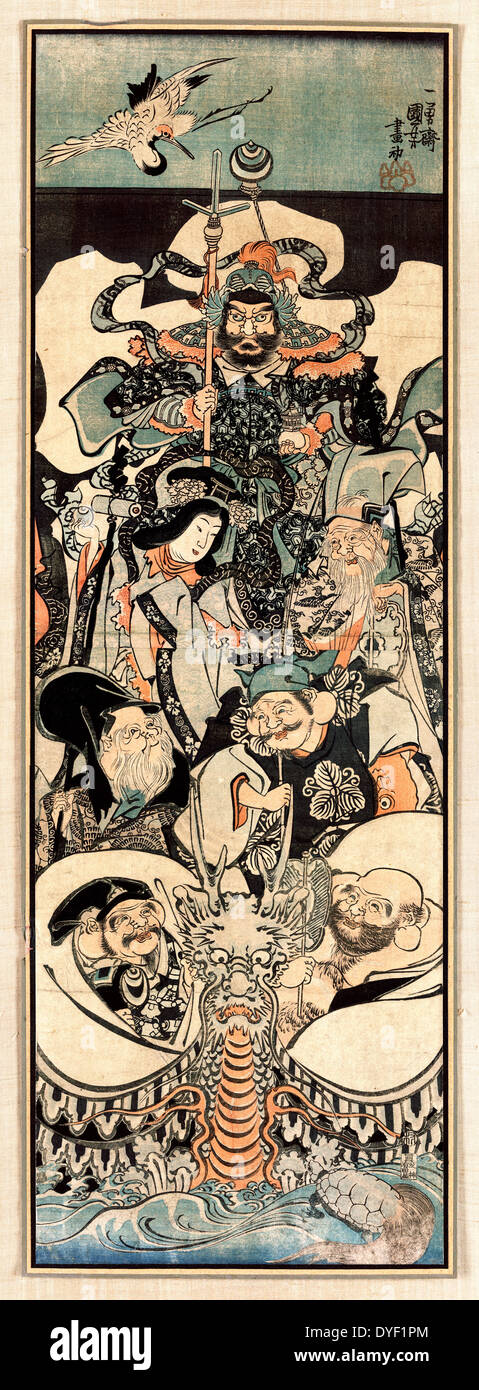 Shichifukujin takarabune (Seven gods of good fortune in the treasure boat). By Kuniyoshi Utagawa, 1798-1861, Japanese artist. dated between 1843 and 1846. Print shows the seven Japanese gods of good fortune (Ebisu, Daikokuten, Bishamonten, Benzaiten, Fukurokuju, Hotei, and Jurojin) in a treasure boat. Stock Photohttps://www.alamy.com/image-license-details/?v=1https://www.alamy.com/shichifukujin-takarabune-seven-gods-of-good-fortune-in-the-treasure-image68557516.html
Shichifukujin takarabune (Seven gods of good fortune in the treasure boat). By Kuniyoshi Utagawa, 1798-1861, Japanese artist. dated between 1843 and 1846. Print shows the seven Japanese gods of good fortune (Ebisu, Daikokuten, Bishamonten, Benzaiten, Fukurokuju, Hotei, and Jurojin) in a treasure boat. Stock Photohttps://www.alamy.com/image-license-details/?v=1https://www.alamy.com/shichifukujin-takarabune-seven-gods-of-good-fortune-in-the-treasure-image68557516.htmlRMDYF1PM–Shichifukujin takarabune (Seven gods of good fortune in the treasure boat). By Kuniyoshi Utagawa, 1798-1861, Japanese artist. dated between 1843 and 1846. Print shows the seven Japanese gods of good fortune (Ebisu, Daikokuten, Bishamonten, Benzaiten, Fukurokuju, Hotei, and Jurojin) in a treasure boat.
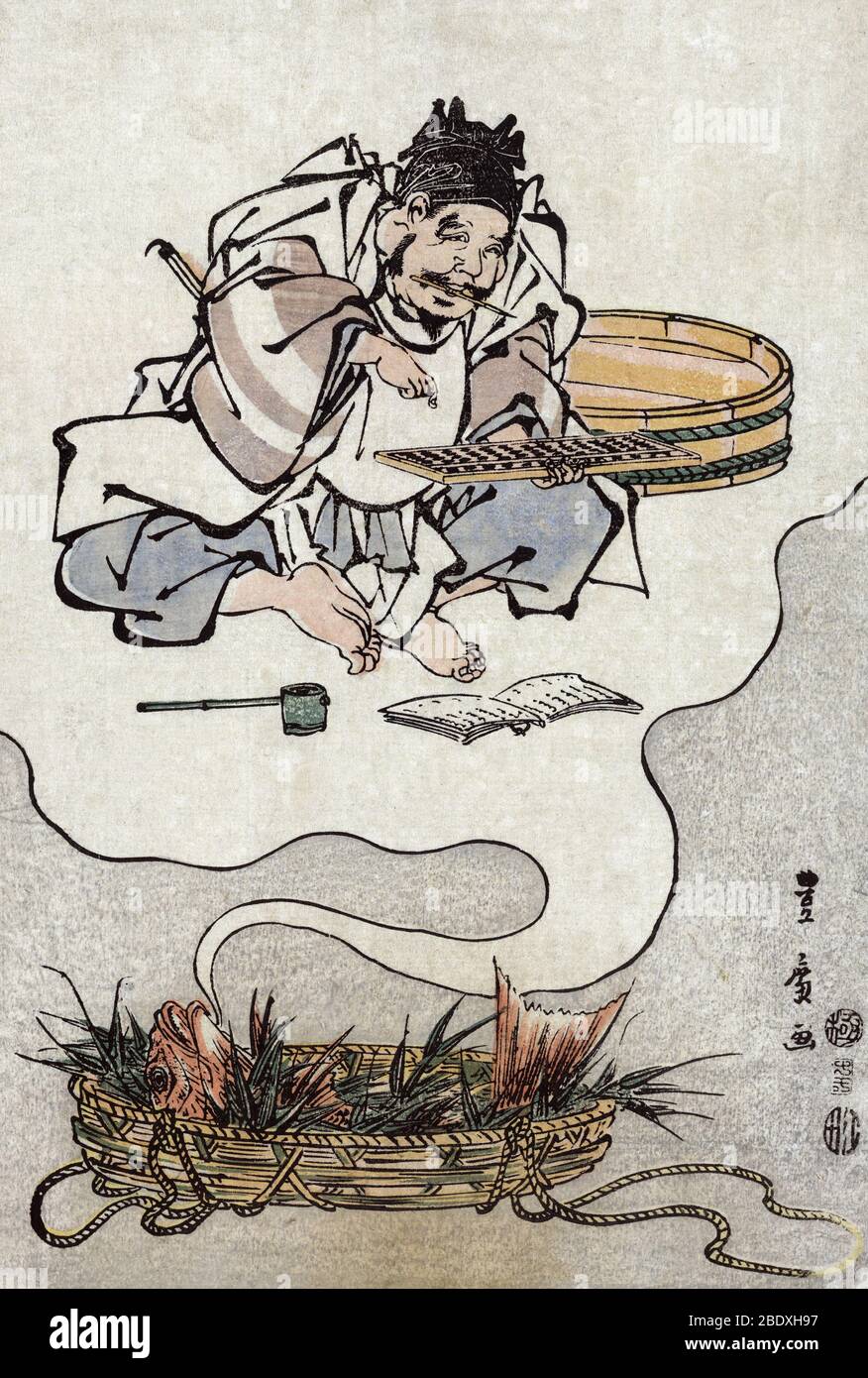 Ebisu Using Abacus, Japanese God of Fortune Stock Photohttps://www.alamy.com/image-license-details/?v=1https://www.alamy.com/ebisu-using-abacus-japanese-god-of-fortune-image352782227.html
Ebisu Using Abacus, Japanese God of Fortune Stock Photohttps://www.alamy.com/image-license-details/?v=1https://www.alamy.com/ebisu-using-abacus-japanese-god-of-fortune-image352782227.htmlRM2BDXH97–Ebisu Using Abacus, Japanese God of Fortune
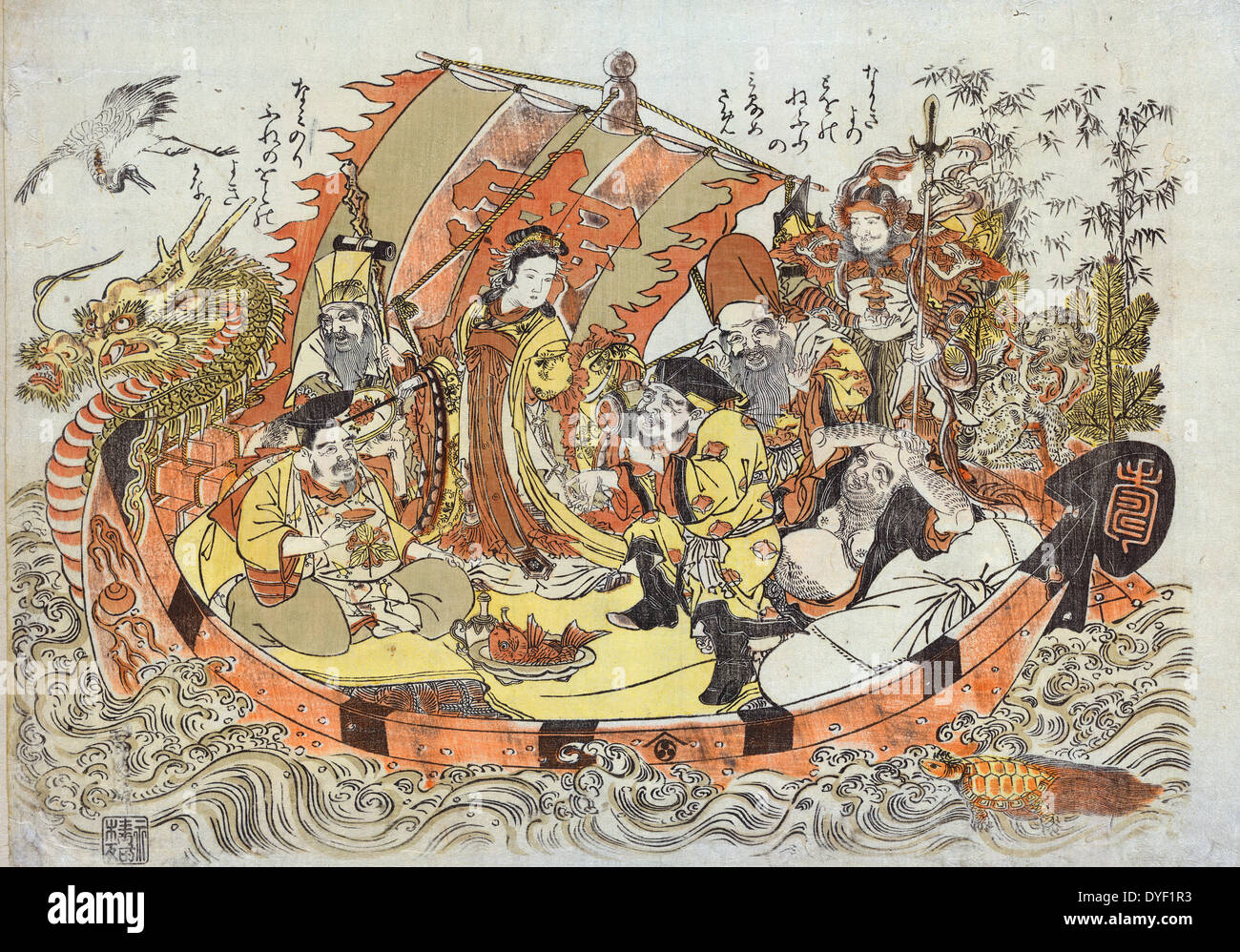 Shichifukujin takarabune (Seven gods of good fortune in the treasure boat). by Shigemasa Kitao, 1739-1820, Japanese artist. dated between 1772 and 1781. the seven Japanese gods of good fortune (Ebisu, Daikokuten, Bishamonten, Benzaiten, Fukurokuju, Hotei, and Jurojin) in a dragon-headed treasure boat, accompanied by a heron and a turtle. Stock Photohttps://www.alamy.com/image-license-details/?v=1https://www.alamy.com/shichifukujin-takarabune-seven-gods-of-good-fortune-in-the-treasure-image68557527.html
Shichifukujin takarabune (Seven gods of good fortune in the treasure boat). by Shigemasa Kitao, 1739-1820, Japanese artist. dated between 1772 and 1781. the seven Japanese gods of good fortune (Ebisu, Daikokuten, Bishamonten, Benzaiten, Fukurokuju, Hotei, and Jurojin) in a dragon-headed treasure boat, accompanied by a heron and a turtle. Stock Photohttps://www.alamy.com/image-license-details/?v=1https://www.alamy.com/shichifukujin-takarabune-seven-gods-of-good-fortune-in-the-treasure-image68557527.htmlRMDYF1R3–Shichifukujin takarabune (Seven gods of good fortune in the treasure boat). by Shigemasa Kitao, 1739-1820, Japanese artist. dated between 1772 and 1781. the seven Japanese gods of good fortune (Ebisu, Daikokuten, Bishamonten, Benzaiten, Fukurokuju, Hotei, and Jurojin) in a dragon-headed treasure boat, accompanied by a heron and a turtle.
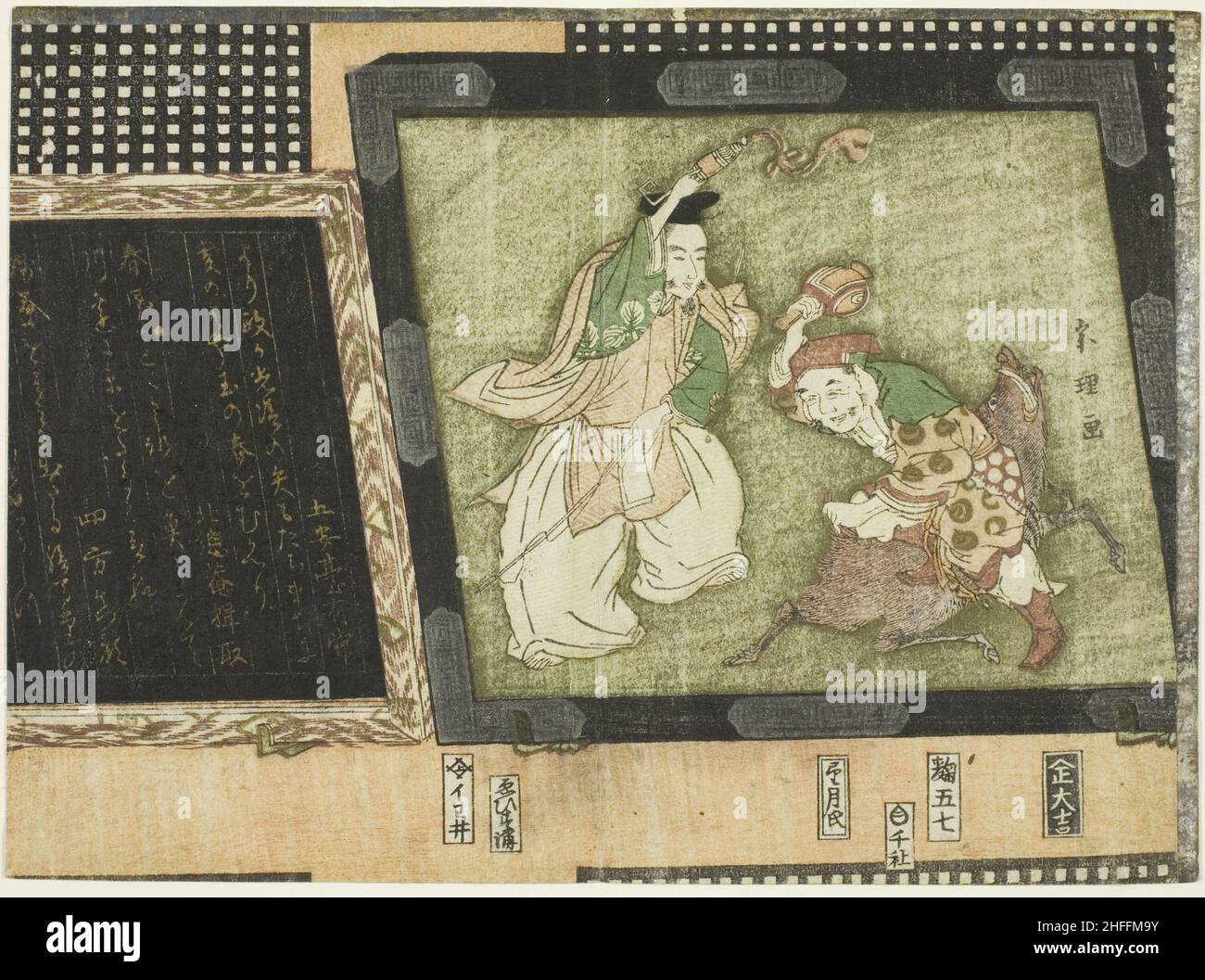 The gods of fortune Ebisu and Daikoku, Japan, 1797. Stock Photohttps://www.alamy.com/image-license-details/?v=1https://www.alamy.com/the-gods-of-fortune-ebisu-and-daikoku-japan-1797-image457034647.html
The gods of fortune Ebisu and Daikoku, Japan, 1797. Stock Photohttps://www.alamy.com/image-license-details/?v=1https://www.alamy.com/the-gods-of-fortune-ebisu-and-daikoku-japan-1797-image457034647.htmlRM2HFFM9Y–The gods of fortune Ebisu and Daikoku, Japan, 1797.
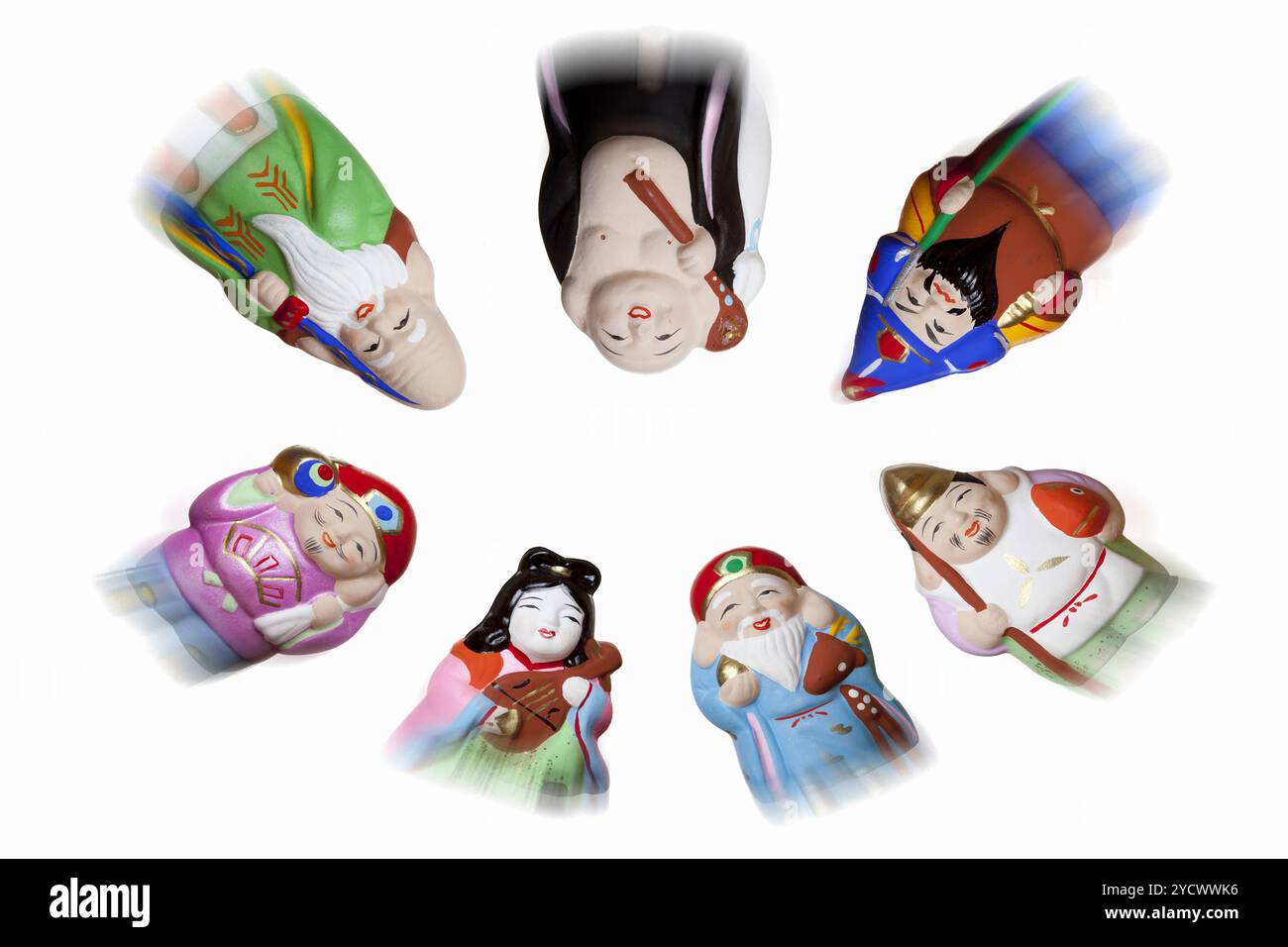 Seven gods of good fortune Stock Photohttps://www.alamy.com/image-license-details/?v=1https://www.alamy.com/seven-gods-of-good-fortune-image627518058.html
Seven gods of good fortune Stock Photohttps://www.alamy.com/image-license-details/?v=1https://www.alamy.com/seven-gods-of-good-fortune-image627518058.htmlRF2YCWWK6–Seven gods of good fortune
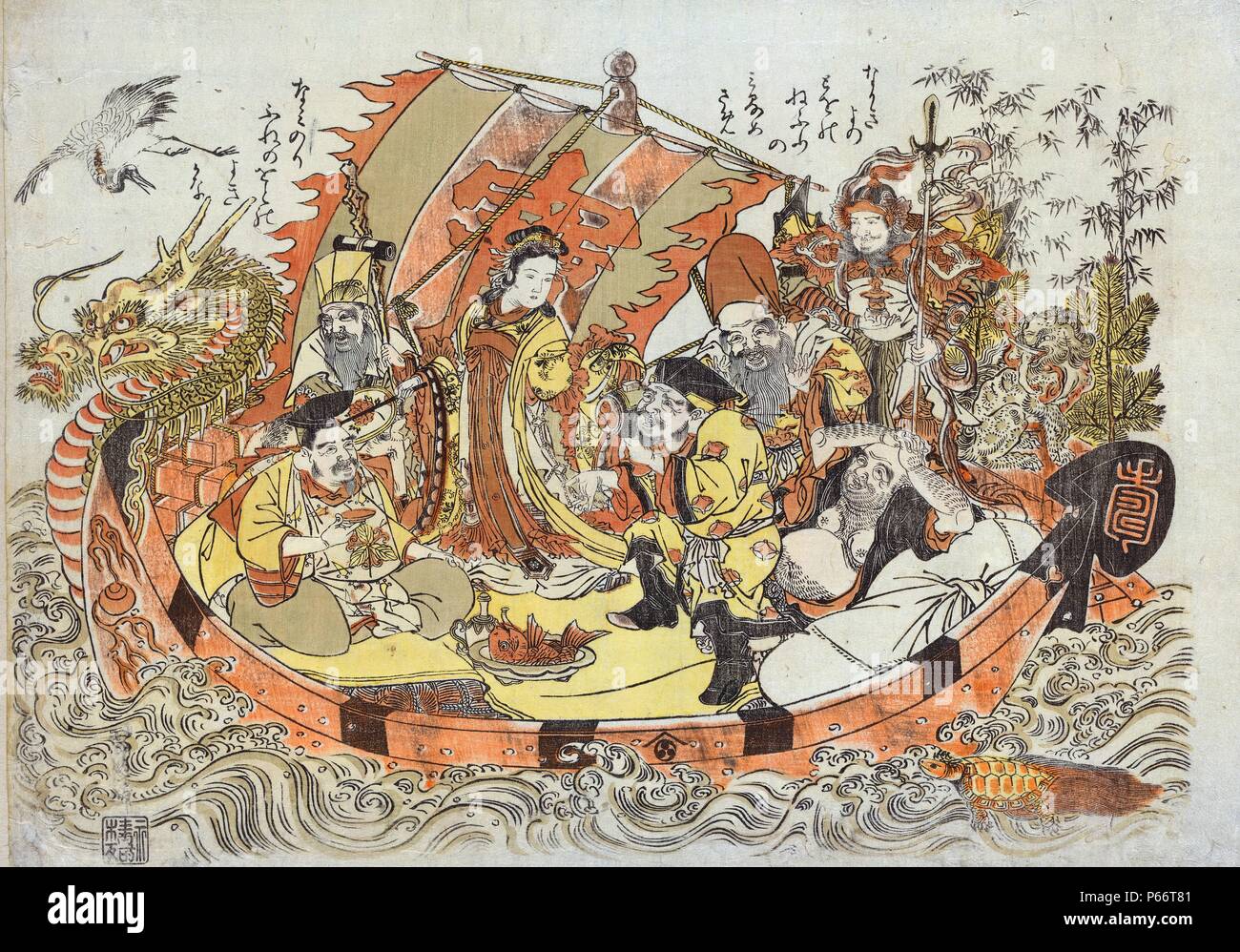 Shichifukujin takarabune (Seven gods of good fortune in the treasure boat). by Shigemasa Kitao, 1739-1820, Japanese artist. dated between 1772 and 1781. the seven Japanese gods of good fortune (Ebisu, Daikokuten, Bishamonten, Benzaiten, Fukurokuju, Hotei, and Jurojin) in a dragon-headed treasure boat, accompanied by a heron and a turtle. Stock Photohttps://www.alamy.com/image-license-details/?v=1https://www.alamy.com/shichifukujin-takarabune-seven-gods-of-good-fortune-in-the-treasure-boat-by-shigemasa-kitao-1739-1820-japanese-artist-dated-between-1772-and-1781-the-seven-japanese-gods-of-good-fortune-ebisu-daikokuten-bishamonten-benzaiten-fukurokuju-hotei-and-jurojin-in-a-dragon-headed-treasure-boat-accompanied-by-a-heron-and-a-turtle-image210363105.html
Shichifukujin takarabune (Seven gods of good fortune in the treasure boat). by Shigemasa Kitao, 1739-1820, Japanese artist. dated between 1772 and 1781. the seven Japanese gods of good fortune (Ebisu, Daikokuten, Bishamonten, Benzaiten, Fukurokuju, Hotei, and Jurojin) in a dragon-headed treasure boat, accompanied by a heron and a turtle. Stock Photohttps://www.alamy.com/image-license-details/?v=1https://www.alamy.com/shichifukujin-takarabune-seven-gods-of-good-fortune-in-the-treasure-boat-by-shigemasa-kitao-1739-1820-japanese-artist-dated-between-1772-and-1781-the-seven-japanese-gods-of-good-fortune-ebisu-daikokuten-bishamonten-benzaiten-fukurokuju-hotei-and-jurojin-in-a-dragon-headed-treasure-boat-accompanied-by-a-heron-and-a-turtle-image210363105.htmlRMP66T81–Shichifukujin takarabune (Seven gods of good fortune in the treasure boat). by Shigemasa Kitao, 1739-1820, Japanese artist. dated between 1772 and 1781. the seven Japanese gods of good fortune (Ebisu, Daikokuten, Bishamonten, Benzaiten, Fukurokuju, Hotei, and Jurojin) in a dragon-headed treasure boat, accompanied by a heron and a turtle.
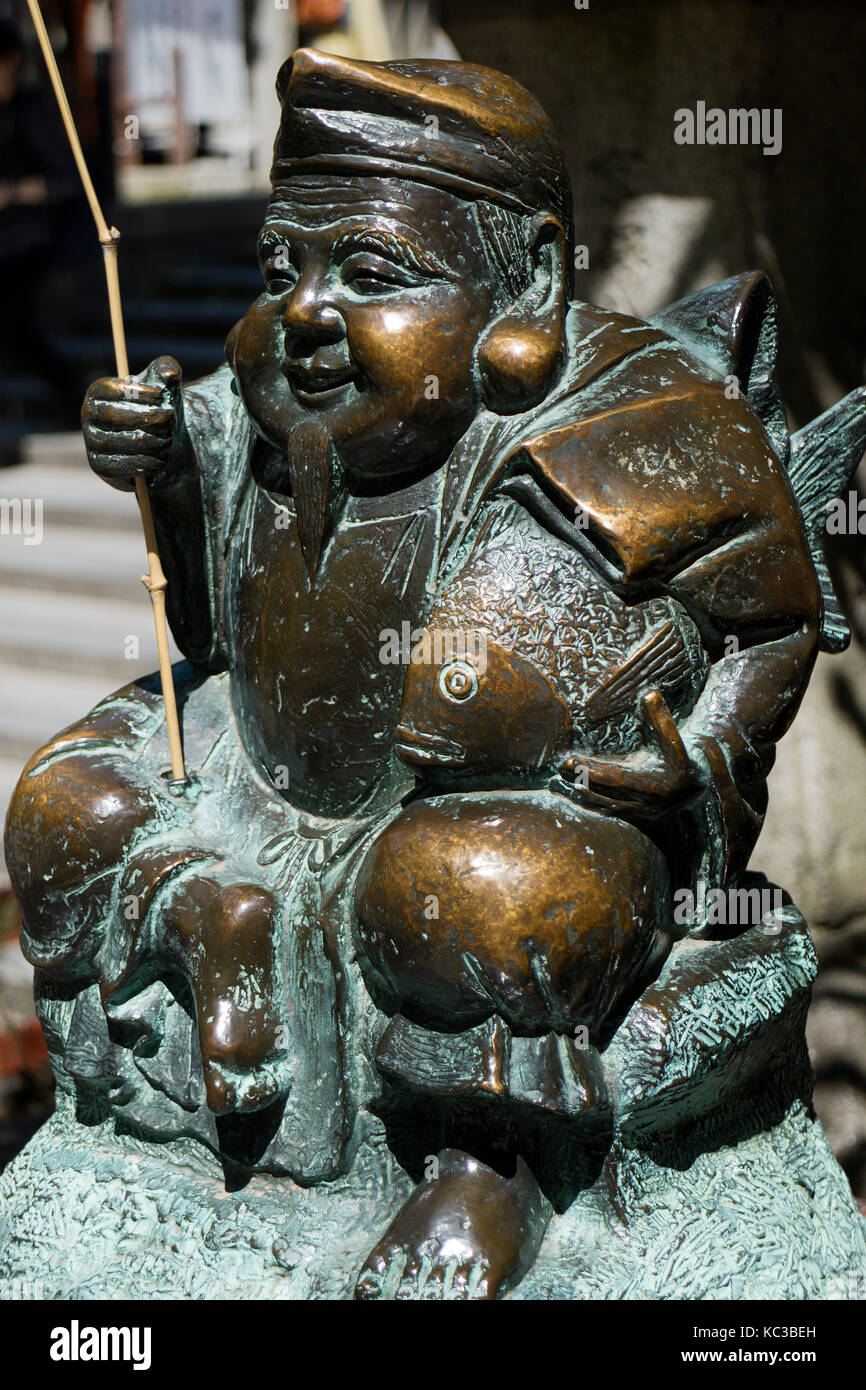 Kyoto, Japan - May 18, 2017: Ebisu statue, the Japanese god of fishermen and luck, he is one of the Seven Gods of Fortune Stock Photohttps://www.alamy.com/image-license-details/?v=1https://www.alamy.com/stock-image-kyoto-japan-may-18-2017-ebisu-statue-the-japanese-god-of-fishermen-162344073.html
Kyoto, Japan - May 18, 2017: Ebisu statue, the Japanese god of fishermen and luck, he is one of the Seven Gods of Fortune Stock Photohttps://www.alamy.com/image-license-details/?v=1https://www.alamy.com/stock-image-kyoto-japan-may-18-2017-ebisu-statue-the-japanese-god-of-fishermen-162344073.htmlRFKC3BEH–Kyoto, Japan - May 18, 2017: Ebisu statue, the Japanese god of fishermen and luck, he is one of the Seven Gods of Fortune
 Katsushika Hokusai. The gods of fortune Ebisu and Daikoku. 1797. Japan. Color woodblock print; surimono, egoyomi Stock Photohttps://www.alamy.com/image-license-details/?v=1https://www.alamy.com/katsushika-hokusai-the-gods-of-fortune-ebisu-and-daikoku-1797-japan-color-woodblock-print-surimono-egoyomi-image337995048.html
Katsushika Hokusai. The gods of fortune Ebisu and Daikoku. 1797. Japan. Color woodblock print; surimono, egoyomi Stock Photohttps://www.alamy.com/image-license-details/?v=1https://www.alamy.com/katsushika-hokusai-the-gods-of-fortune-ebisu-and-daikoku-1797-japan-color-woodblock-print-surimono-egoyomi-image337995048.htmlRM2AHW03M–Katsushika Hokusai. The gods of fortune Ebisu and Daikoku. 1797. Japan. Color woodblock print; surimono, egoyomi
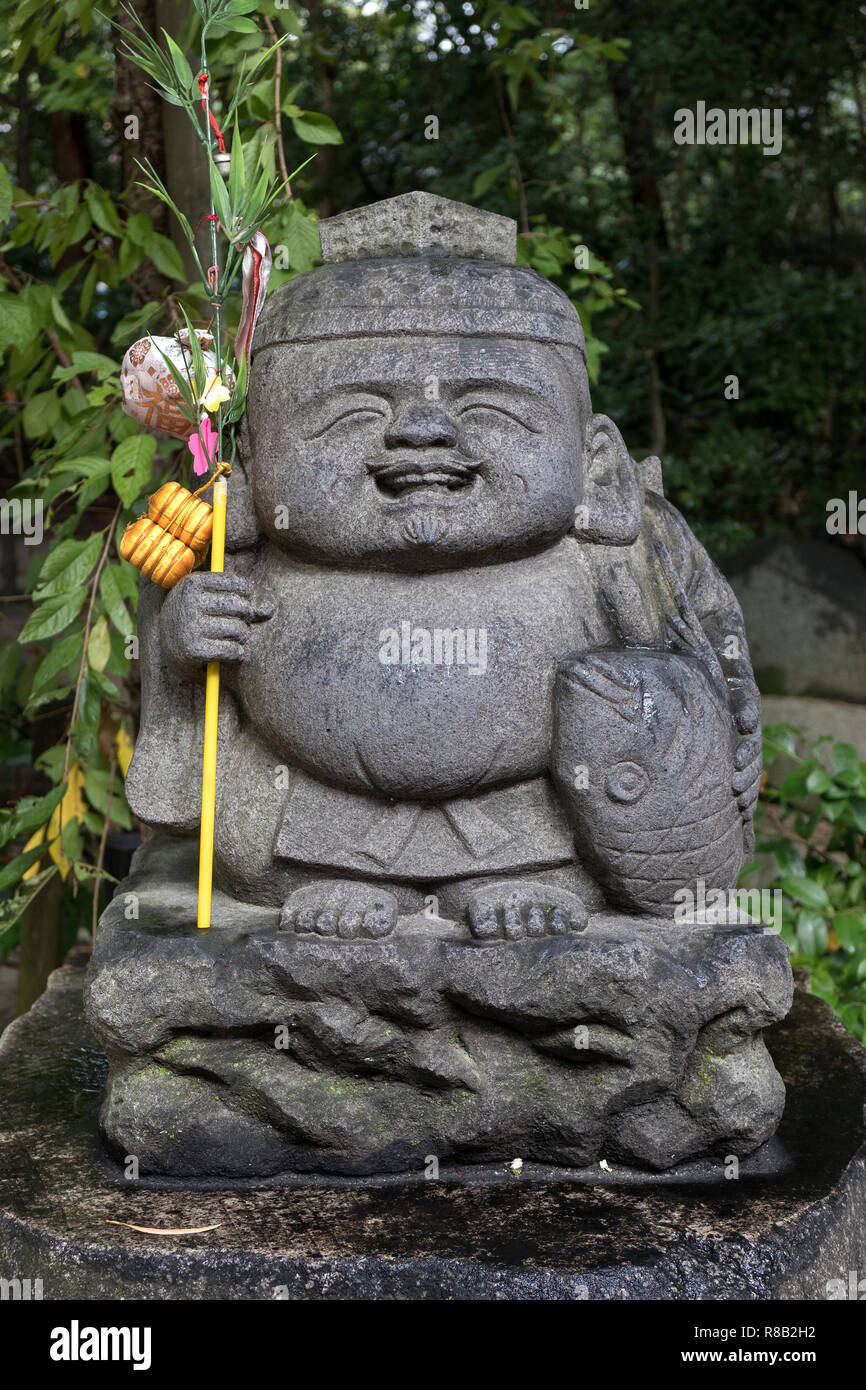 Fukuoka, Japan - October 19, 2018: Stone Ebisu statue, the Japanese god of fishermen and luck, he is one of the Seven Gods of Fortune Stock Photohttps://www.alamy.com/image-license-details/?v=1https://www.alamy.com/fukuoka-japan-october-19-2018-stone-ebisu-statue-the-japanese-god-of-fishermen-and-luck-he-is-one-of-the-seven-gods-of-fortune-image228895550.html
Fukuoka, Japan - October 19, 2018: Stone Ebisu statue, the Japanese god of fishermen and luck, he is one of the Seven Gods of Fortune Stock Photohttps://www.alamy.com/image-license-details/?v=1https://www.alamy.com/fukuoka-japan-october-19-2018-stone-ebisu-statue-the-japanese-god-of-fishermen-and-luck-he-is-one-of-the-seven-gods-of-fortune-image228895550.htmlRFR8B2H2–Fukuoka, Japan - October 19, 2018: Stone Ebisu statue, the Japanese god of fishermen and luck, he is one of the Seven Gods of Fortune
 Seven gods of good fortune: Ebisu, Daikokuten, Bishamonten, Benzaiten, Fukurokuju, Jurojin, and Hotei with sticker-style edging - Translation: Ebisu, Stock Vectorhttps://www.alamy.com/image-license-details/?v=1https://www.alamy.com/seven-gods-of-good-fortune-ebisu-daikokuten-bishamonten-benzaiten-fukurokuju-jurojin-and-hotei-with-sticker-style-edging-translation-ebisu-image561723216.html
Seven gods of good fortune: Ebisu, Daikokuten, Bishamonten, Benzaiten, Fukurokuju, Jurojin, and Hotei with sticker-style edging - Translation: Ebisu, Stock Vectorhttps://www.alamy.com/image-license-details/?v=1https://www.alamy.com/seven-gods-of-good-fortune-ebisu-daikokuten-bishamonten-benzaiten-fukurokuju-jurojin-and-hotei-with-sticker-style-edging-translation-ebisu-image561723216.htmlRF2RHTKKC–Seven gods of good fortune: Ebisu, Daikokuten, Bishamonten, Benzaiten, Fukurokuju, Jurojin, and Hotei with sticker-style edging - Translation: Ebisu,
 Art inspired by Ebisu and Daikoku; Two of the Seven Gods of Good Fortune, Edo period (1615–1868), 19th century, Japan, Part of an album of woodblock prints (surimono); ink and color on paper, 7 15/16 x 7 1/4 in. (20.2 x 18.4 cm), Prints, Totoya Hokkei (Japanese, 1780–1850, Classic works modernized by Artotop with a splash of modernity. Shapes, color and value, eye-catching visual impact on art. Emotions through freedom of artworks in a contemporary way. A timeless message pursuing a wildly creative new direction. Artists turning to the digital medium and creating the Artotop NFT Stock Photohttps://www.alamy.com/image-license-details/?v=1https://www.alamy.com/art-inspired-by-ebisu-and-daikoku-two-of-the-seven-gods-of-good-fortune-edo-period-16151868-19th-century-japan-part-of-an-album-of-woodblock-prints-surimono-ink-and-color-on-paper-7-1516-x-7-14-in-202-x-184-cm-prints-totoya-hokkei-japanese-17801850-classic-works-modernized-by-artotop-with-a-splash-of-modernity-shapes-color-and-value-eye-catching-visual-impact-on-art-emotions-through-freedom-of-artworks-in-a-contemporary-way-a-timeless-message-pursuing-a-wildly-creative-new-direction-artists-turning-to-the-digital-medium-and-creating-the-artotop-nft-image462913045.html
Art inspired by Ebisu and Daikoku; Two of the Seven Gods of Good Fortune, Edo period (1615–1868), 19th century, Japan, Part of an album of woodblock prints (surimono); ink and color on paper, 7 15/16 x 7 1/4 in. (20.2 x 18.4 cm), Prints, Totoya Hokkei (Japanese, 1780–1850, Classic works modernized by Artotop with a splash of modernity. Shapes, color and value, eye-catching visual impact on art. Emotions through freedom of artworks in a contemporary way. A timeless message pursuing a wildly creative new direction. Artists turning to the digital medium and creating the Artotop NFT Stock Photohttps://www.alamy.com/image-license-details/?v=1https://www.alamy.com/art-inspired-by-ebisu-and-daikoku-two-of-the-seven-gods-of-good-fortune-edo-period-16151868-19th-century-japan-part-of-an-album-of-woodblock-prints-surimono-ink-and-color-on-paper-7-1516-x-7-14-in-202-x-184-cm-prints-totoya-hokkei-japanese-17801850-classic-works-modernized-by-artotop-with-a-splash-of-modernity-shapes-color-and-value-eye-catching-visual-impact-on-art-emotions-through-freedom-of-artworks-in-a-contemporary-way-a-timeless-message-pursuing-a-wildly-creative-new-direction-artists-turning-to-the-digital-medium-and-creating-the-artotop-nft-image462913045.htmlRF2HW3E8N–Art inspired by Ebisu and Daikoku; Two of the Seven Gods of Good Fortune, Edo period (1615–1868), 19th century, Japan, Part of an album of woodblock prints (surimono); ink and color on paper, 7 15/16 x 7 1/4 in. (20.2 x 18.4 cm), Prints, Totoya Hokkei (Japanese, 1780–1850, Classic works modernized by Artotop with a splash of modernity. Shapes, color and value, eye-catching visual impact on art. Emotions through freedom of artworks in a contemporary way. A timeless message pursuing a wildly creative new direction. Artists turning to the digital medium and creating the Artotop NFT
![[ 1920s Japan - Japanese Gods of Fortune ] — Hikifuda (引札), a print used as an advertising flyer by local shops. They were popular from the 1800s through the 1920s. Daikokuten (大黒天, front) and Ebisu (恵比寿), two of the Seven Gods of Fortune (七福神 Shichi Fukujin), symbolizing prosperous business. Daikokuten and Ebisu are traditionally seen as gods of business and trade. 20th century vintage advertising flyer. Stock Photo [ 1920s Japan - Japanese Gods of Fortune ] — Hikifuda (引札), a print used as an advertising flyer by local shops. They were popular from the 1800s through the 1920s. Daikokuten (大黒天, front) and Ebisu (恵比寿), two of the Seven Gods of Fortune (七福神 Shichi Fukujin), symbolizing prosperous business. Daikokuten and Ebisu are traditionally seen as gods of business and trade. 20th century vintage advertising flyer. Stock Photo](https://c8.alamy.com/comp/2BMYWN8/1920s-japan-japanese-gods-of-fortune-hikifuda-a-print-used-as-an-advertising-flyer-by-local-shops-they-were-popular-from-the-1800s-through-the-1920s-daikokuten-front-and-ebisu-two-of-the-seven-gods-of-fortune-shichi-fukujin-symbolizing-prosperous-business-daikokuten-and-ebisu-are-traditionally-seen-as-gods-of-business-and-trade-20th-century-vintage-advertising-flyer-2BMYWN8.jpg) [ 1920s Japan - Japanese Gods of Fortune ] — Hikifuda (引札), a print used as an advertising flyer by local shops. They were popular from the 1800s through the 1920s. Daikokuten (大黒天, front) and Ebisu (恵比寿), two of the Seven Gods of Fortune (七福神 Shichi Fukujin), symbolizing prosperous business. Daikokuten and Ebisu are traditionally seen as gods of business and trade. 20th century vintage advertising flyer. Stock Photohttps://www.alamy.com/image-license-details/?v=1https://www.alamy.com/1920s-japan-japanese-gods-of-fortune-hikifuda-a-print-used-as-an-advertising-flyer-by-local-shops-they-were-popular-from-the-1800s-through-the-1920s-daikokuten-front-and-ebisu-two-of-the-seven-gods-of-fortune-shichi-fukujin-symbolizing-prosperous-business-daikokuten-and-ebisu-are-traditionally-seen-as-gods-of-business-and-trade-20th-century-vintage-advertising-flyer-image357113380.html
[ 1920s Japan - Japanese Gods of Fortune ] — Hikifuda (引札), a print used as an advertising flyer by local shops. They were popular from the 1800s through the 1920s. Daikokuten (大黒天, front) and Ebisu (恵比寿), two of the Seven Gods of Fortune (七福神 Shichi Fukujin), symbolizing prosperous business. Daikokuten and Ebisu are traditionally seen as gods of business and trade. 20th century vintage advertising flyer. Stock Photohttps://www.alamy.com/image-license-details/?v=1https://www.alamy.com/1920s-japan-japanese-gods-of-fortune-hikifuda-a-print-used-as-an-advertising-flyer-by-local-shops-they-were-popular-from-the-1800s-through-the-1920s-daikokuten-front-and-ebisu-two-of-the-seven-gods-of-fortune-shichi-fukujin-symbolizing-prosperous-business-daikokuten-and-ebisu-are-traditionally-seen-as-gods-of-business-and-trade-20th-century-vintage-advertising-flyer-image357113380.htmlRM2BMYWN8–[ 1920s Japan - Japanese Gods of Fortune ] — Hikifuda (引札), a print used as an advertising flyer by local shops. They were popular from the 1800s through the 1920s. Daikokuten (大黒天, front) and Ebisu (恵比寿), two of the Seven Gods of Fortune (七福神 Shichi Fukujin), symbolizing prosperous business. Daikokuten and Ebisu are traditionally seen as gods of business and trade. 20th century vintage advertising flyer.
 October. Woman unrolIIng a kakemono with images of Ebisu and Daikoku, the gods of fortune /Ebisu ko, from the series: Generic scenes of twelve months /Fuzoku Junikagetsu. Eizan, Kikugawa (1787 1867) Stock Photohttps://www.alamy.com/image-license-details/?v=1https://www.alamy.com/october-woman-unroliing-a-kakemono-with-images-of-ebisu-and-daikoku-the-gods-of-fortune-ebisu-ko-from-the-series-generic-scenes-of-twelve-months-fuzoku-junikagetsu-eizan-kikugawa-1787-1867-image471298916.html
October. Woman unrolIIng a kakemono with images of Ebisu and Daikoku, the gods of fortune /Ebisu ko, from the series: Generic scenes of twelve months /Fuzoku Junikagetsu. Eizan, Kikugawa (1787 1867) Stock Photohttps://www.alamy.com/image-license-details/?v=1https://www.alamy.com/october-woman-unroliing-a-kakemono-with-images-of-ebisu-and-daikoku-the-gods-of-fortune-ebisu-ko-from-the-series-generic-scenes-of-twelve-months-fuzoku-junikagetsu-eizan-kikugawa-1787-1867-image471298916.htmlRM2JANEG4–October. Woman unrolIIng a kakemono with images of Ebisu and Daikoku, the gods of fortune /Ebisu ko, from the series: Generic scenes of twelve months /Fuzoku Junikagetsu. Eizan, Kikugawa (1787 1867)
 Ebisu and Daikoku; Two of the Seven Gods of Good Fortune, Totoya Hokkei, 19th century Stock Photohttps://www.alamy.com/image-license-details/?v=1https://www.alamy.com/stock-image-ebisu-and-daikoku-two-of-the-seven-gods-of-good-fortune-totoya-hokkei-162414185.html
Ebisu and Daikoku; Two of the Seven Gods of Good Fortune, Totoya Hokkei, 19th century Stock Photohttps://www.alamy.com/image-license-details/?v=1https://www.alamy.com/stock-image-ebisu-and-daikoku-two-of-the-seven-gods-of-good-fortune-totoya-hokkei-162414185.htmlRMKC6GXH–Ebisu and Daikoku; Two of the Seven Gods of Good Fortune, Totoya Hokkei, 19th century
 Sword guard (Tsuba) Depicting Ebisu (恵比須図鐔) ca. 1615–1868 Japanese This tsuba depicts God of Fortune Ebisu and a young helper hauling in a net with fish. Ebisu is shown with his famous attributes fishing rod and fan as he is regarded as God of the fishing folk.. Sword guard (Tsuba) Depicting Ebisu (恵比須図鐔) 25716 Stock Photohttps://www.alamy.com/image-license-details/?v=1https://www.alamy.com/sword-guard-tsuba-depicting-ebisu-ca-16151868-japanese-this-tsuba-depicts-god-of-fortune-ebisu-and-a-young-helper-hauling-in-a-net-with-fish-ebisu-is-shown-with-his-famous-attributes-fishing-rod-and-fan-as-he-is-regarded-as-god-of-the-fishing-folk-sword-guard-tsuba-depicting-ebisu-25716-image458491148.html
Sword guard (Tsuba) Depicting Ebisu (恵比須図鐔) ca. 1615–1868 Japanese This tsuba depicts God of Fortune Ebisu and a young helper hauling in a net with fish. Ebisu is shown with his famous attributes fishing rod and fan as he is regarded as God of the fishing folk.. Sword guard (Tsuba) Depicting Ebisu (恵比須図鐔) 25716 Stock Photohttps://www.alamy.com/image-license-details/?v=1https://www.alamy.com/sword-guard-tsuba-depicting-ebisu-ca-16151868-japanese-this-tsuba-depicts-god-of-fortune-ebisu-and-a-young-helper-hauling-in-a-net-with-fish-ebisu-is-shown-with-his-famous-attributes-fishing-rod-and-fan-as-he-is-regarded-as-god-of-the-fishing-folk-sword-guard-tsuba-depicting-ebisu-25716-image458491148.htmlRM2HHX23T–Sword guard (Tsuba) Depicting Ebisu (恵比須図鐔) ca. 1615–1868 Japanese This tsuba depicts God of Fortune Ebisu and a young helper hauling in a net with fish. Ebisu is shown with his famous attributes fishing rod and fan as he is regarded as God of the fishing folk.. Sword guard (Tsuba) Depicting Ebisu (恵比須図鐔) 25716
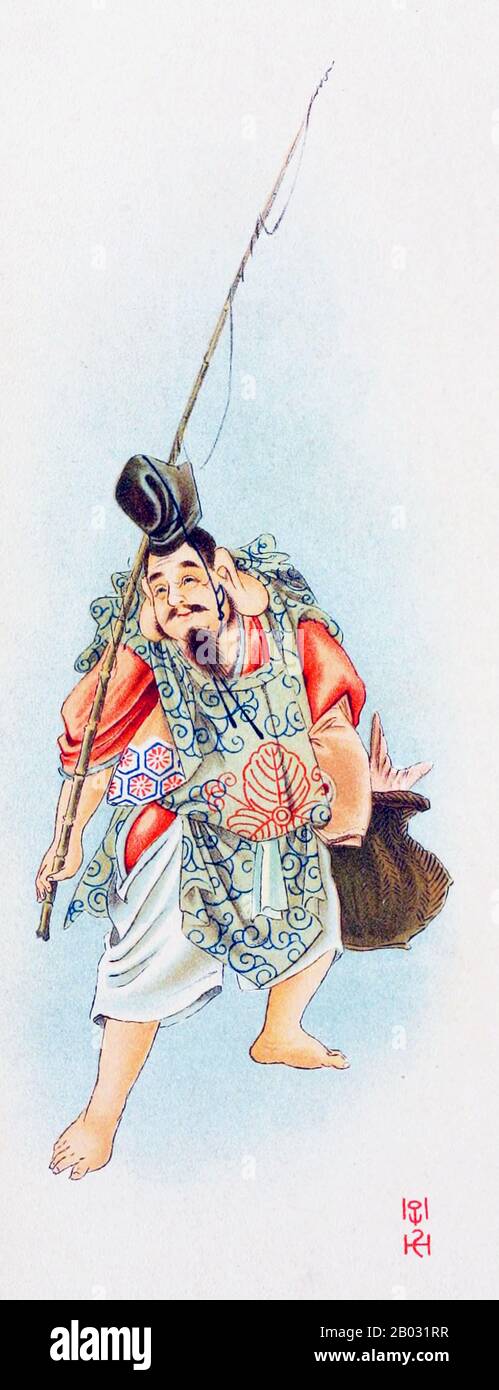 Ebisu, also transliterated Yebisu, is the Japanese god of fishermen and luck. He is one of the Seven Gods of Fortune or Shichifukujin, and the only one of the seven to originate purely from Japan without any Hindu or Chinese influence. Stock Photohttps://www.alamy.com/image-license-details/?v=1https://www.alamy.com/ebisu-also-transliterated-yebisu-is-the-japanese-god-of-fishermen-and-luck-he-is-one-of-the-seven-gods-of-fortune-or-shichifukujin-and-the-only-one-of-the-seven-to-originate-purely-from-japan-without-any-hindu-or-chinese-influence-image344274667.html
Ebisu, also transliterated Yebisu, is the Japanese god of fishermen and luck. He is one of the Seven Gods of Fortune or Shichifukujin, and the only one of the seven to originate purely from Japan without any Hindu or Chinese influence. Stock Photohttps://www.alamy.com/image-license-details/?v=1https://www.alamy.com/ebisu-also-transliterated-yebisu-is-the-japanese-god-of-fishermen-and-luck-he-is-one-of-the-seven-gods-of-fortune-or-shichifukujin-and-the-only-one-of-the-seven-to-originate-purely-from-japan-without-any-hindu-or-chinese-influence-image344274667.htmlRM2B031RR–Ebisu, also transliterated Yebisu, is the Japanese god of fishermen and luck. He is one of the Seven Gods of Fortune or Shichifukujin, and the only one of the seven to originate purely from Japan without any Hindu or Chinese influence.
 Shinto statuettes of Ebisu at Achi shrine in Kurashiki, Okayama Prefecture, Japan Stock Photohttps://www.alamy.com/image-license-details/?v=1https://www.alamy.com/stock-photo-shinto-statuettes-of-ebisu-at-achi-shrine-in-kurashiki-okayama-prefecture-100678161.html
Shinto statuettes of Ebisu at Achi shrine in Kurashiki, Okayama Prefecture, Japan Stock Photohttps://www.alamy.com/image-license-details/?v=1https://www.alamy.com/stock-photo-shinto-statuettes-of-ebisu-at-achi-shrine-in-kurashiki-okayama-prefecture-100678161.htmlRMFRP80H–Shinto statuettes of Ebisu at Achi shrine in Kurashiki, Okayama Prefecture, Japan
 Festival of the god of good fortune, Ebisu Stock Photohttps://www.alamy.com/image-license-details/?v=1https://www.alamy.com/stock-photo-festival-of-the-god-of-good-fortune-ebisu-105337523.html
Festival of the god of good fortune, Ebisu Stock Photohttps://www.alamy.com/image-license-details/?v=1https://www.alamy.com/stock-photo-festival-of-the-god-of-good-fortune-ebisu-105337523.htmlRMG3AF2B–Festival of the god of good fortune, Ebisu
 Ebisu and Benten walking in the snow, Utagawa Toyohiro, artist, 1810-1820, Tokyo, woodcut, This Japanese woodblock print is a good example of surimono, limited-edition, privately commissioned prints which are finely crafted, smaller than an ōban, they often combine verse and image in complementary arrangements. The composition of Ebisu and Benten or Benzaiten by Utagawa Toyohiro (1773–1828) was published to celebrate the advent of the new year. Both figures were counted among the fukujin, the Seven Gods of Good Fortune, and their appearance together was especially auspicious. Stock Photohttps://www.alamy.com/image-license-details/?v=1https://www.alamy.com/ebisu-and-benten-walking-in-the-snow-utagawa-toyohiro-artist-1810-1820-tokyo-woodcut-this-japanese-woodblock-print-is-a-good-example-of-surimono-limited-edition-privately-commissioned-prints-which-are-finely-crafted-smaller-than-an-ban-they-often-combine-verse-and-image-in-complementary-arrangements-the-composition-of-ebisu-and-benten-or-benzaiten-by-utagawa-toyohiro-17731828-was-published-to-celebrate-the-advent-of-the-new-year-both-figures-were-counted-among-the-fukujin-the-seven-gods-of-good-fortune-and-their-appearance-together-was-especially-auspicious-image454298747.html
Ebisu and Benten walking in the snow, Utagawa Toyohiro, artist, 1810-1820, Tokyo, woodcut, This Japanese woodblock print is a good example of surimono, limited-edition, privately commissioned prints which are finely crafted, smaller than an ōban, they often combine verse and image in complementary arrangements. The composition of Ebisu and Benten or Benzaiten by Utagawa Toyohiro (1773–1828) was published to celebrate the advent of the new year. Both figures were counted among the fukujin, the Seven Gods of Good Fortune, and their appearance together was especially auspicious. Stock Photohttps://www.alamy.com/image-license-details/?v=1https://www.alamy.com/ebisu-and-benten-walking-in-the-snow-utagawa-toyohiro-artist-1810-1820-tokyo-woodcut-this-japanese-woodblock-print-is-a-good-example-of-surimono-limited-edition-privately-commissioned-prints-which-are-finely-crafted-smaller-than-an-ban-they-often-combine-verse-and-image-in-complementary-arrangements-the-composition-of-ebisu-and-benten-or-benzaiten-by-utagawa-toyohiro-17731828-was-published-to-celebrate-the-advent-of-the-new-year-both-figures-were-counted-among-the-fukujin-the-seven-gods-of-good-fortune-and-their-appearance-together-was-especially-auspicious-image454298747.htmlRM2HB32K7–Ebisu and Benten walking in the snow, Utagawa Toyohiro, artist, 1810-1820, Tokyo, woodcut, This Japanese woodblock print is a good example of surimono, limited-edition, privately commissioned prints which are finely crafted, smaller than an ōban, they often combine verse and image in complementary arrangements. The composition of Ebisu and Benten or Benzaiten by Utagawa Toyohiro (1773–1828) was published to celebrate the advent of the new year. Both figures were counted among the fukujin, the Seven Gods of Good Fortune, and their appearance together was especially auspicious.
 Ebisu Garden Tokyo trendy fashion luxery modern Stock Photohttps://www.alamy.com/image-license-details/?v=1https://www.alamy.com/stock-photo-ebisu-garden-tokyo-trendy-fashion-luxery-modern-11888591.html
Ebisu Garden Tokyo trendy fashion luxery modern Stock Photohttps://www.alamy.com/image-license-details/?v=1https://www.alamy.com/stock-photo-ebisu-garden-tokyo-trendy-fashion-luxery-modern-11888591.htmlRMA7P9AT–Ebisu Garden Tokyo trendy fashion luxery modern
 Small stone Ebisu statues and animals at Achi shrine in Kurashiki City, Okayama Prefecture, Japan Stock Photohttps://www.alamy.com/image-license-details/?v=1https://www.alamy.com/stock-photo-small-stone-ebisu-statues-and-animals-at-achi-shrine-in-kurashiki-100678162.html
Small stone Ebisu statues and animals at Achi shrine in Kurashiki City, Okayama Prefecture, Japan Stock Photohttps://www.alamy.com/image-license-details/?v=1https://www.alamy.com/stock-photo-small-stone-ebisu-statues-and-animals-at-achi-shrine-in-kurashiki-100678162.htmlRMFRP80J–Small stone Ebisu statues and animals at Achi shrine in Kurashiki City, Okayama Prefecture, Japan
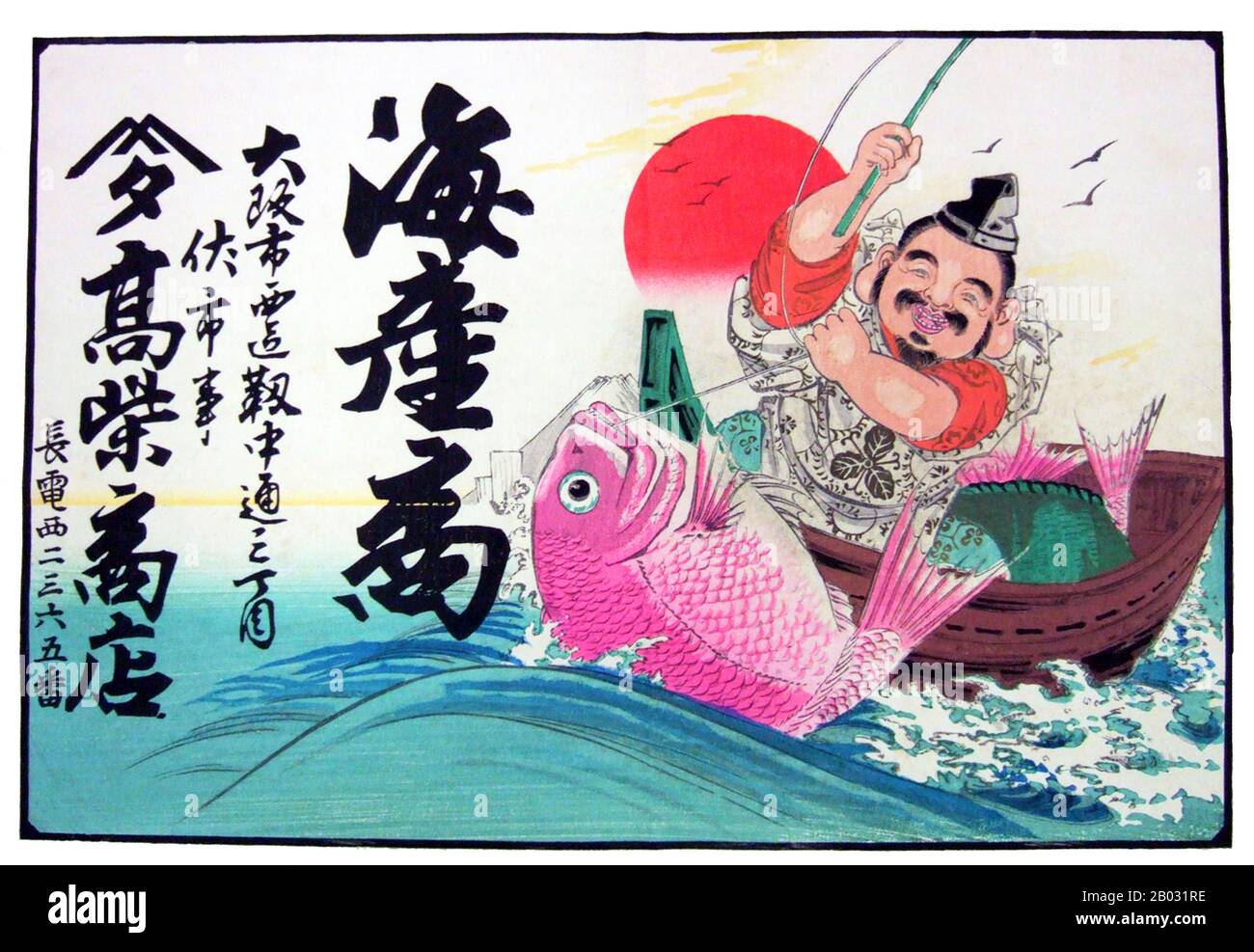 Ebisu, also transliterated Yebisu, is the Japanese god of fishermen and luck. He is one of the Seven Gods of Fortune or Shichifukujin, and the only one of the seven to originate purely from Japan without any Hindu or Chinese influence. Stock Photohttps://www.alamy.com/image-license-details/?v=1https://www.alamy.com/ebisu-also-transliterated-yebisu-is-the-japanese-god-of-fishermen-and-luck-he-is-one-of-the-seven-gods-of-fortune-or-shichifukujin-and-the-only-one-of-the-seven-to-originate-purely-from-japan-without-any-hindu-or-chinese-influence-image344274658.html
Ebisu, also transliterated Yebisu, is the Japanese god of fishermen and luck. He is one of the Seven Gods of Fortune or Shichifukujin, and the only one of the seven to originate purely from Japan without any Hindu or Chinese influence. Stock Photohttps://www.alamy.com/image-license-details/?v=1https://www.alamy.com/ebisu-also-transliterated-yebisu-is-the-japanese-god-of-fishermen-and-luck-he-is-one-of-the-seven-gods-of-fortune-or-shichifukujin-and-the-only-one-of-the-seven-to-originate-purely-from-japan-without-any-hindu-or-chinese-influence-image344274658.htmlRM2B031RE–Ebisu, also transliterated Yebisu, is the Japanese god of fishermen and luck. He is one of the Seven Gods of Fortune or Shichifukujin, and the only one of the seven to originate purely from Japan without any Hindu or Chinese influence.
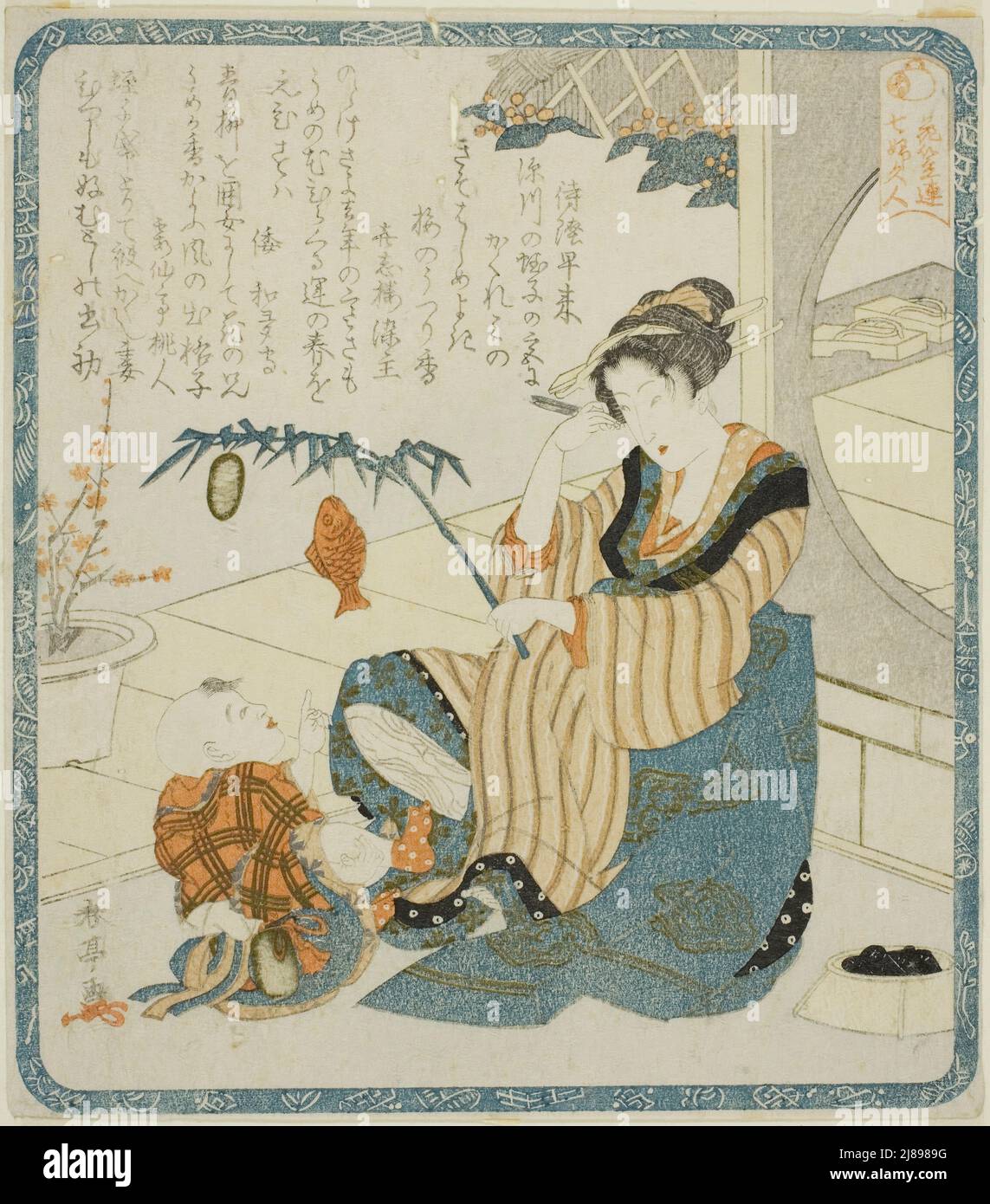 A Woman as Ebisu, from the series "Seven Women as the Gods of Good Fortune for the Hanagasa Poetry Club (Hanagasaren shichifukujin)", Japan, c. 1820. Stock Photohttps://www.alamy.com/image-license-details/?v=1https://www.alamy.com/a-woman-as-ebisu-from-the-series-quotseven-women-as-the-gods-of-good-fortune-for-the-hanagasa-poetry-club-hanagasaren-shichifukujinquot-japan-c-1820-image469801292.html
A Woman as Ebisu, from the series "Seven Women as the Gods of Good Fortune for the Hanagasa Poetry Club (Hanagasaren shichifukujin)", Japan, c. 1820. Stock Photohttps://www.alamy.com/image-license-details/?v=1https://www.alamy.com/a-woman-as-ebisu-from-the-series-quotseven-women-as-the-gods-of-good-fortune-for-the-hanagasa-poetry-club-hanagasaren-shichifukujinquot-japan-c-1820-image469801292.htmlRM2J8989G–A Woman as Ebisu, from the series "Seven Women as the Gods of Good Fortune for the Hanagasa Poetry Club (Hanagasaren shichifukujin)", Japan, c. 1820.
 Seven gods of good fortune Stock Photohttps://www.alamy.com/image-license-details/?v=1https://www.alamy.com/seven-gods-of-good-fortune-image627518051.html
Seven gods of good fortune Stock Photohttps://www.alamy.com/image-license-details/?v=1https://www.alamy.com/seven-gods-of-good-fortune-image627518051.htmlRF2YCWWJY–Seven gods of good fortune
 Seven Gods of Good Fortune and Chinese Children. Artist: Kano Chikanobu (Japanese, 1660-1728). Culture: Japan. Dimensions: 69 1/4 x 153 in. (175.9 x 388.6 cm). Date: 17th-18th century. In this screen, three of the seven gods of good fortune (Daikoku, Ebisu, and Hotei) and a group of Chinese children serve as visual references to wealth, prosperity, and abundance. Some of the children pull a flower cart (hana-guruma) laden with a bamboo basket overflowing with peonies (emblematic of riches and honor) and other flowers associated with good fortune. The flower cart, another popular subject for s Stock Photohttps://www.alamy.com/image-license-details/?v=1https://www.alamy.com/seven-gods-of-good-fortune-and-chinese-children-artist-kano-chikanobu-japanese-1660-1728-culture-japan-dimensions-69-14-x-153-in-1759-x-3886-cm-date-17th-18th-century-in-this-screen-three-of-the-seven-gods-of-good-fortune-daikoku-ebisu-and-hotei-and-a-group-of-chinese-children-serve-as-visual-references-to-wealth-prosperity-and-abundance-some-of-the-children-pull-a-flower-cart-hana-guruma-laden-with-a-bamboo-basket-overflowing-with-peonies-emblematic-of-riches-and-honor-and-other-flowers-associated-with-good-fortune-the-flower-cart-another-popular-subject-for-s-image213180876.html
Seven Gods of Good Fortune and Chinese Children. Artist: Kano Chikanobu (Japanese, 1660-1728). Culture: Japan. Dimensions: 69 1/4 x 153 in. (175.9 x 388.6 cm). Date: 17th-18th century. In this screen, three of the seven gods of good fortune (Daikoku, Ebisu, and Hotei) and a group of Chinese children serve as visual references to wealth, prosperity, and abundance. Some of the children pull a flower cart (hana-guruma) laden with a bamboo basket overflowing with peonies (emblematic of riches and honor) and other flowers associated with good fortune. The flower cart, another popular subject for s Stock Photohttps://www.alamy.com/image-license-details/?v=1https://www.alamy.com/seven-gods-of-good-fortune-and-chinese-children-artist-kano-chikanobu-japanese-1660-1728-culture-japan-dimensions-69-14-x-153-in-1759-x-3886-cm-date-17th-18th-century-in-this-screen-three-of-the-seven-gods-of-good-fortune-daikoku-ebisu-and-hotei-and-a-group-of-chinese-children-serve-as-visual-references-to-wealth-prosperity-and-abundance-some-of-the-children-pull-a-flower-cart-hana-guruma-laden-with-a-bamboo-basket-overflowing-with-peonies-emblematic-of-riches-and-honor-and-other-flowers-associated-with-good-fortune-the-flower-cart-another-popular-subject-for-s-image213180876.htmlRMPAR6AM–Seven Gods of Good Fortune and Chinese Children. Artist: Kano Chikanobu (Japanese, 1660-1728). Culture: Japan. Dimensions: 69 1/4 x 153 in. (175.9 x 388.6 cm). Date: 17th-18th century. In this screen, three of the seven gods of good fortune (Daikoku, Ebisu, and Hotei) and a group of Chinese children serve as visual references to wealth, prosperity, and abundance. Some of the children pull a flower cart (hana-guruma) laden with a bamboo basket overflowing with peonies (emblematic of riches and honor) and other flowers associated with good fortune. The flower cart, another popular subject for s
 Japan, Miyajima. Daisho-in temple. Statues of the Japanese seven deities of good fortune outdoors in a line with pile of coins left as offerings. Stock Photohttps://www.alamy.com/image-license-details/?v=1https://www.alamy.com/stock-photo-japan-miyajima-daisho-in-temple-statues-of-the-japanese-seven-deities-84410958.html
Japan, Miyajima. Daisho-in temple. Statues of the Japanese seven deities of good fortune outdoors in a line with pile of coins left as offerings. Stock Photohttps://www.alamy.com/image-license-details/?v=1https://www.alamy.com/stock-photo-japan-miyajima-daisho-in-temple-statues-of-the-japanese-seven-deities-84410958.htmlRMEW9712–Japan, Miyajima. Daisho-in temple. Statues of the Japanese seven deities of good fortune outdoors in a line with pile of coins left as offerings.
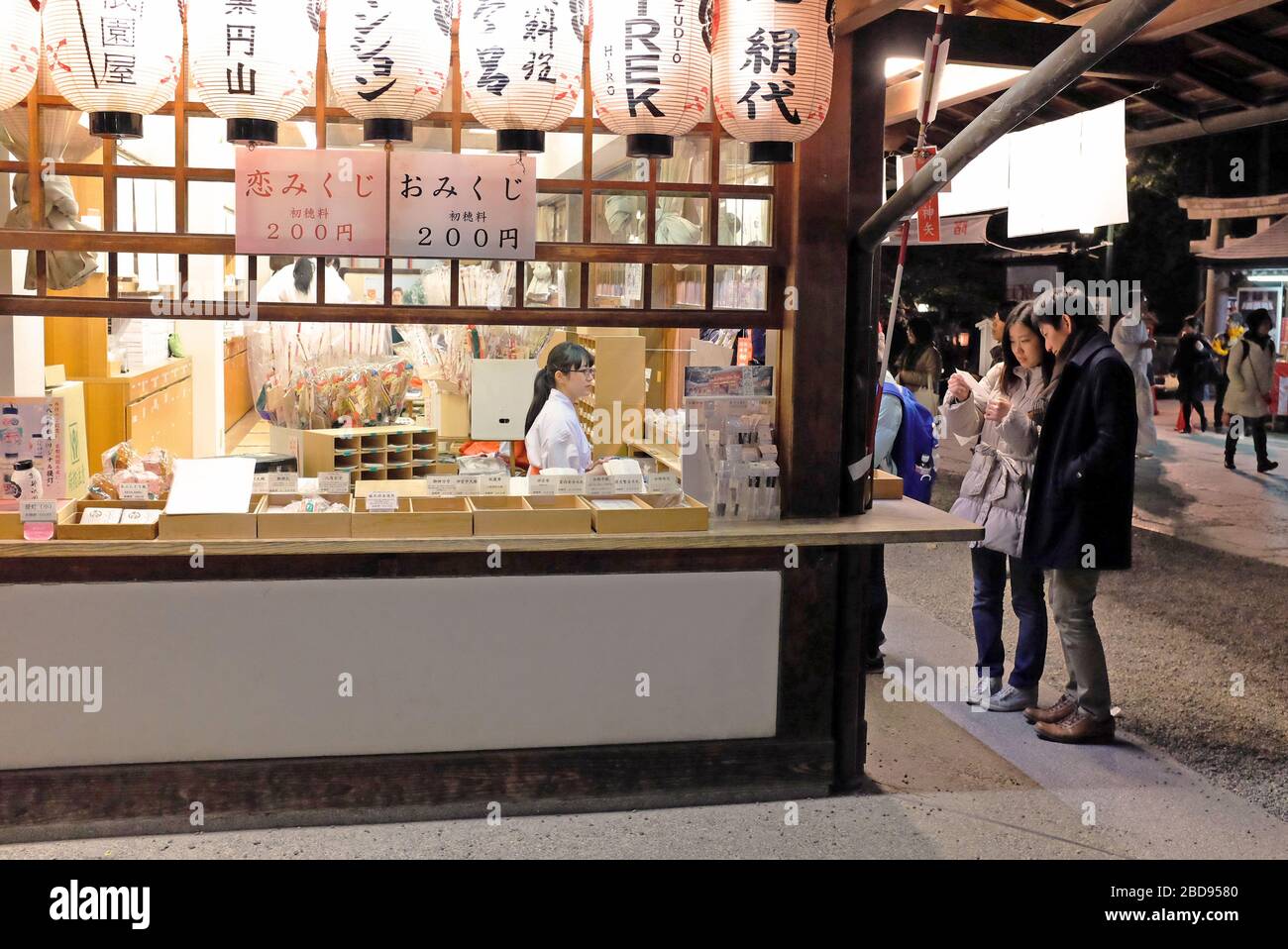 A young Japanese couple at the Kyoto Toka Ebisu festival in 2016, named for the God of prosperity and a major Japanese festival honoring Ebisu. Stock Photohttps://www.alamy.com/image-license-details/?v=1https://www.alamy.com/a-young-japanese-couple-at-the-kyoto-toka-ebisu-festival-in-2016-named-for-the-god-of-prosperity-and-a-major-japanese-festival-honoring-ebisu-image352399600.html
A young Japanese couple at the Kyoto Toka Ebisu festival in 2016, named for the God of prosperity and a major Japanese festival honoring Ebisu. Stock Photohttps://www.alamy.com/image-license-details/?v=1https://www.alamy.com/a-young-japanese-couple-at-the-kyoto-toka-ebisu-festival-in-2016-named-for-the-god-of-prosperity-and-a-major-japanese-festival-honoring-ebisu-image352399600.htmlRM2BD9580–A young Japanese couple at the Kyoto Toka Ebisu festival in 2016, named for the God of prosperity and a major Japanese festival honoring Ebisu.
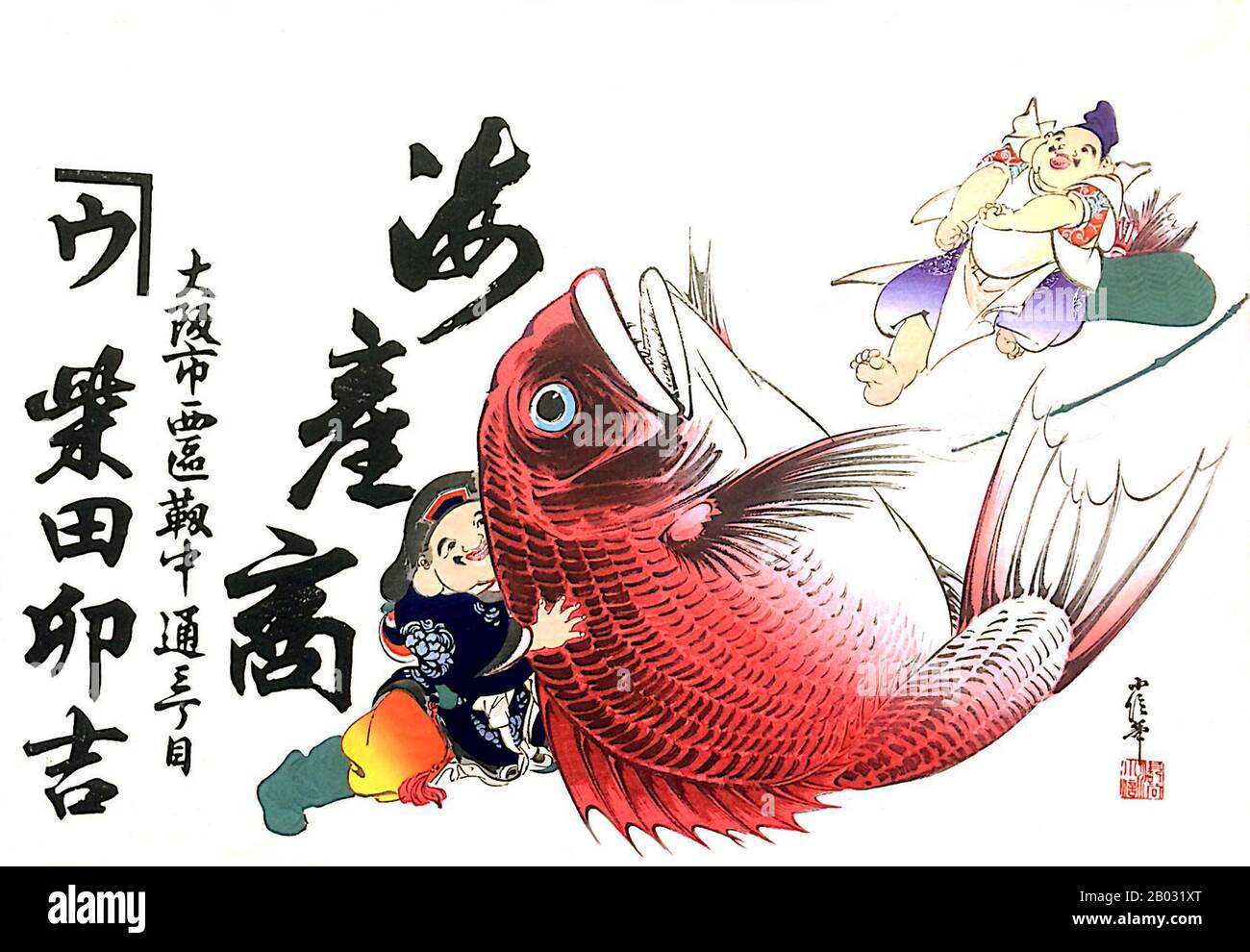 Ebisu, also transliterated Yebisu, is the Japanese god of fishermen and luck. He is one of the Seven Gods of Fortune or Shichifukujin, and the only one of the seven to originate purely from Japan without any Hindu or Chinese influence. Stock Photohttps://www.alamy.com/image-license-details/?v=1https://www.alamy.com/ebisu-also-transliterated-yebisu-is-the-japanese-god-of-fishermen-and-luck-he-is-one-of-the-seven-gods-of-fortune-or-shichifukujin-and-the-only-one-of-the-seven-to-originate-purely-from-japan-without-any-hindu-or-chinese-influence-image344274752.html
Ebisu, also transliterated Yebisu, is the Japanese god of fishermen and luck. He is one of the Seven Gods of Fortune or Shichifukujin, and the only one of the seven to originate purely from Japan without any Hindu or Chinese influence. Stock Photohttps://www.alamy.com/image-license-details/?v=1https://www.alamy.com/ebisu-also-transliterated-yebisu-is-the-japanese-god-of-fishermen-and-luck-he-is-one-of-the-seven-gods-of-fortune-or-shichifukujin-and-the-only-one-of-the-seven-to-originate-purely-from-japan-without-any-hindu-or-chinese-influence-image344274752.htmlRM2B031XT–Ebisu, also transliterated Yebisu, is the Japanese god of fishermen and luck. He is one of the Seven Gods of Fortune or Shichifukujin, and the only one of the seven to originate purely from Japan without any Hindu or Chinese influence.
 Cute and simple illustration of seven gods of good fortune Ebisu - Translation: EBISU Stock Vectorhttps://www.alamy.com/image-license-details/?v=1https://www.alamy.com/cute-and-simple-illustration-of-seven-gods-of-good-fortune-ebisu-translation-ebisu-image560990860.html
Cute and simple illustration of seven gods of good fortune Ebisu - Translation: EBISU Stock Vectorhttps://www.alamy.com/image-license-details/?v=1https://www.alamy.com/cute-and-simple-illustration-of-seven-gods-of-good-fortune-ebisu-translation-ebisu-image560990860.htmlRF2RGK9FT–Cute and simple illustration of seven gods of good fortune Ebisu - Translation: EBISU
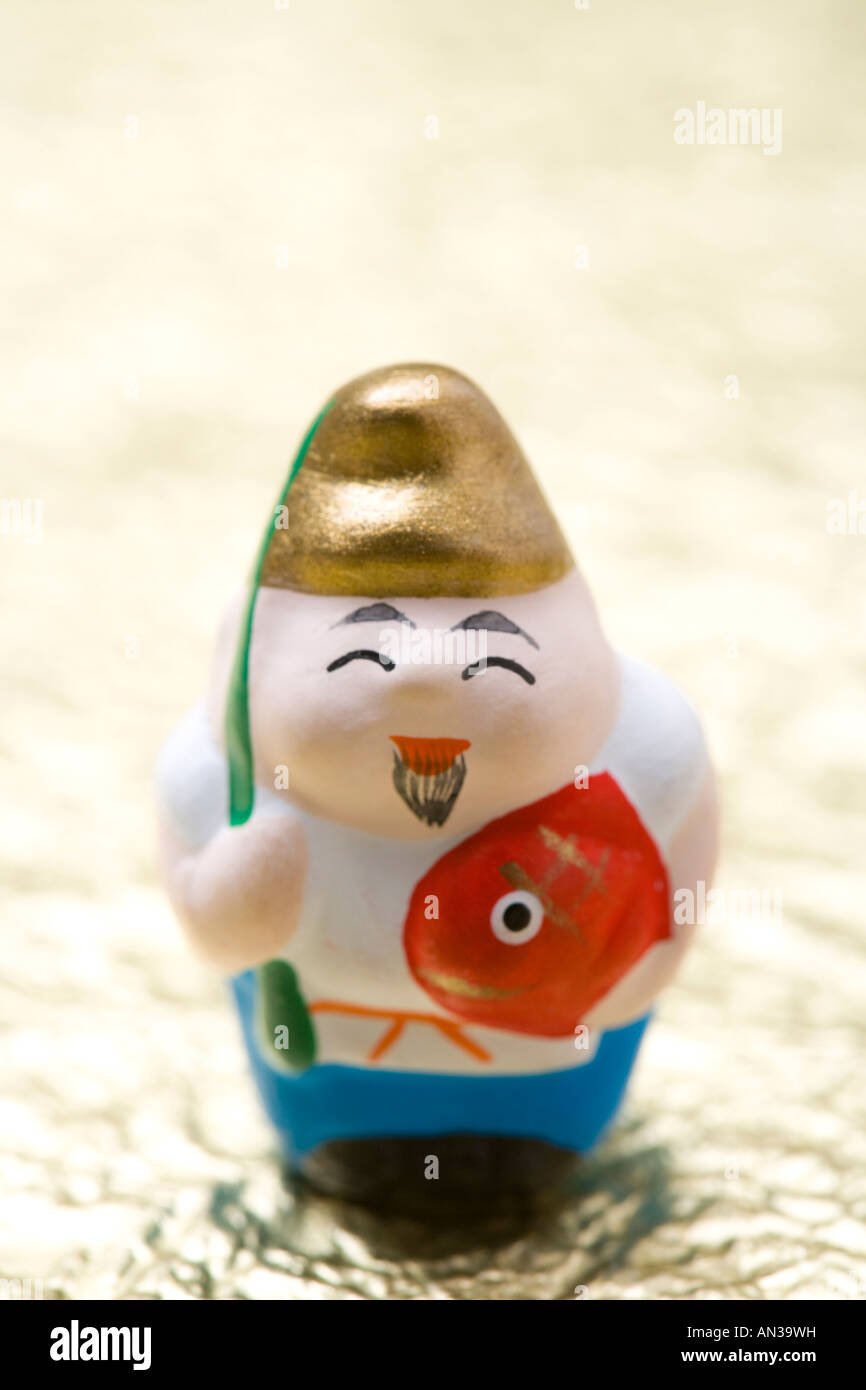 Ebisu Stock Photohttps://www.alamy.com/image-license-details/?v=1https://www.alamy.com/stock-photo-ebisu-15397948.html
Ebisu Stock Photohttps://www.alamy.com/image-license-details/?v=1https://www.alamy.com/stock-photo-ebisu-15397948.htmlRFAN39WH–Ebisu
![[ 1920s Japan - Japanese Business Woman on an Advertising Flyer ] — Hikifuda (引札), a print used as an advertising flyer by local shops. They were popular from the 1800s through the 1920s. A woman in kimono sporting a modern hairstyle is doing bookkeeping while Ebisu, one of the seven deities of fortune (Shichi Fukujin), looks on from the back. 20th century vintage advertising flyer. Stock Photo [ 1920s Japan - Japanese Business Woman on an Advertising Flyer ] — Hikifuda (引札), a print used as an advertising flyer by local shops. They were popular from the 1800s through the 1920s. A woman in kimono sporting a modern hairstyle is doing bookkeeping while Ebisu, one of the seven deities of fortune (Shichi Fukujin), looks on from the back. 20th century vintage advertising flyer. Stock Photo](https://c8.alamy.com/comp/WB6EHT/1920s-japan-japanese-business-woman-on-an-advertising-flyer-hikifuda-a-print-used-as-an-advertising-flyer-by-local-shops-they-were-popular-from-the-1800s-through-the-1920s-a-woman-in-kimono-sporting-a-modern-hairstyle-is-doing-bookkeeping-while-ebisu-one-of-the-seven-deities-of-fortune-shichi-fukujin-looks-on-from-the-back-20th-century-vintage-advertising-flyer-WB6EHT.jpg) [ 1920s Japan - Japanese Business Woman on an Advertising Flyer ] — Hikifuda (引札), a print used as an advertising flyer by local shops. They were popular from the 1800s through the 1920s. A woman in kimono sporting a modern hairstyle is doing bookkeeping while Ebisu, one of the seven deities of fortune (Shichi Fukujin), looks on from the back. 20th century vintage advertising flyer. Stock Photohttps://www.alamy.com/image-license-details/?v=1https://www.alamy.com/1920s-japan-japanese-business-woman-on-an-advertising-flyer-hikifuda-a-print-used-as-an-advertising-flyer-by-local-shops-they-were-popular-from-the-1800s-through-the-1920s-a-woman-in-kimono-sporting-a-modern-hairstyle-is-doing-bookkeeping-while-ebisu-one-of-the-seven-deities-of-fortune-shichi-fukujin-looks-on-from-the-back-20th-century-vintage-advertising-flyer-image265059924.html
[ 1920s Japan - Japanese Business Woman on an Advertising Flyer ] — Hikifuda (引札), a print used as an advertising flyer by local shops. They were popular from the 1800s through the 1920s. A woman in kimono sporting a modern hairstyle is doing bookkeeping while Ebisu, one of the seven deities of fortune (Shichi Fukujin), looks on from the back. 20th century vintage advertising flyer. Stock Photohttps://www.alamy.com/image-license-details/?v=1https://www.alamy.com/1920s-japan-japanese-business-woman-on-an-advertising-flyer-hikifuda-a-print-used-as-an-advertising-flyer-by-local-shops-they-were-popular-from-the-1800s-through-the-1920s-a-woman-in-kimono-sporting-a-modern-hairstyle-is-doing-bookkeeping-while-ebisu-one-of-the-seven-deities-of-fortune-shichi-fukujin-looks-on-from-the-back-20th-century-vintage-advertising-flyer-image265059924.htmlRMWB6EHT–[ 1920s Japan - Japanese Business Woman on an Advertising Flyer ] — Hikifuda (引札), a print used as an advertising flyer by local shops. They were popular from the 1800s through the 1920s. A woman in kimono sporting a modern hairstyle is doing bookkeeping while Ebisu, one of the seven deities of fortune (Shichi Fukujin), looks on from the back. 20th century vintage advertising flyer.
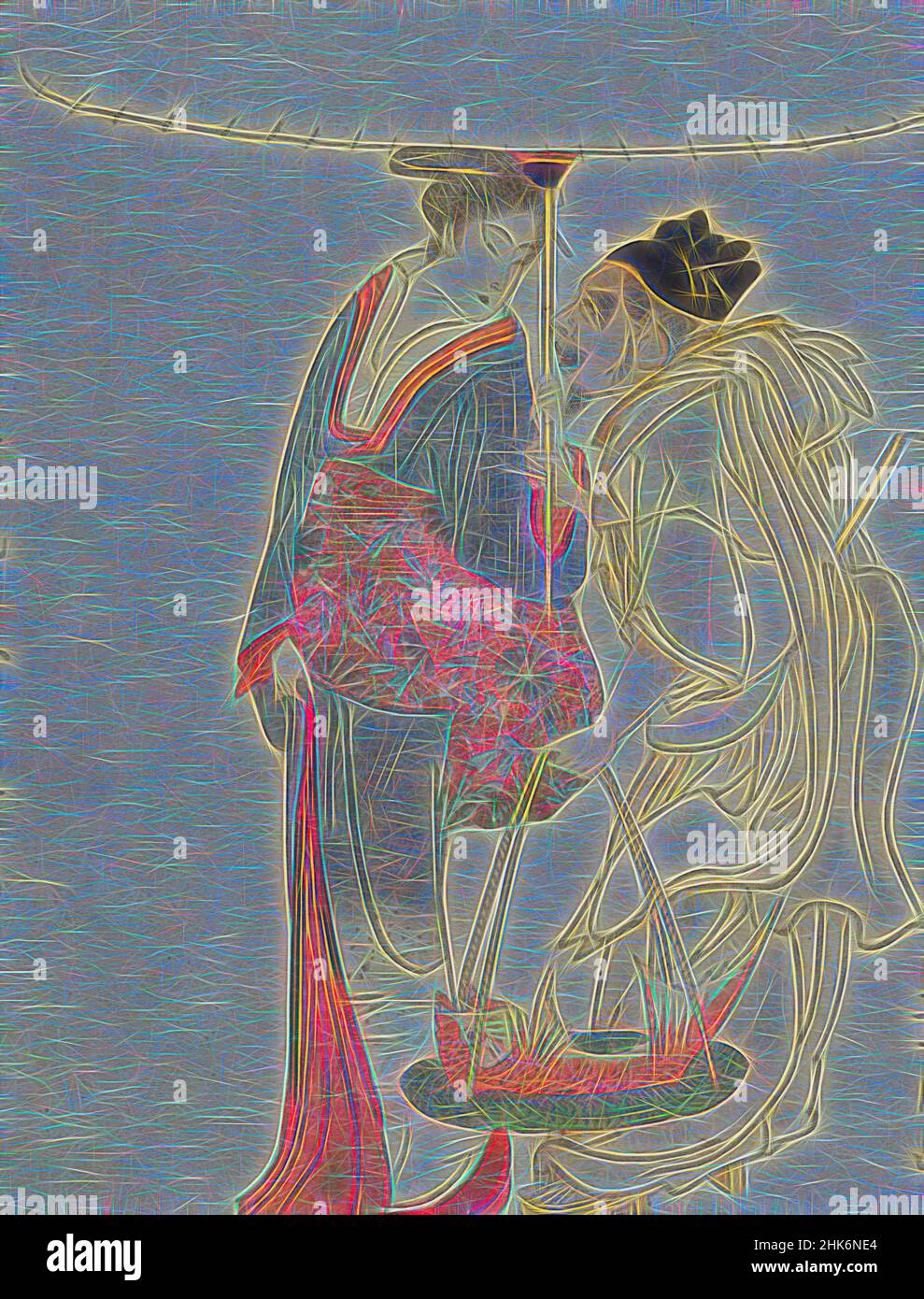 Inspired by Ebisu and Benten walking in the snow, Utagawa Toyohiro, artist, 1810-1820, Tokyo, woodcut, This Japanese woodblock print is a good example of surimono, limited-edition, privately commissioned prints which are finely crafted, smaller than an ōban, they often combine verse and image in, Reimagined by Artotop. Classic art reinvented with a modern twist. Design of warm cheerful glowing of brightness and light ray radiance. Photography inspired by surrealism and futurism, embracing dynamic energy of modern technology, movement, speed and revolutionize culture Stock Photohttps://www.alamy.com/image-license-details/?v=1https://www.alamy.com/inspired-by-ebisu-and-benten-walking-in-the-snow-utagawa-toyohiro-artist-1810-1820-tokyo-woodcut-this-japanese-woodblock-print-is-a-good-example-of-surimono-limited-edition-privately-commissioned-prints-which-are-finely-crafted-smaller-than-an-ban-they-often-combine-verse-and-image-in-reimagined-by-artotop-classic-art-reinvented-with-a-modern-twist-design-of-warm-cheerful-glowing-of-brightness-and-light-ray-radiance-photography-inspired-by-surrealism-and-futurism-embracing-dynamic-energy-of-modern-technology-movement-speed-and-revolutionize-culture-image459296604.html
Inspired by Ebisu and Benten walking in the snow, Utagawa Toyohiro, artist, 1810-1820, Tokyo, woodcut, This Japanese woodblock print is a good example of surimono, limited-edition, privately commissioned prints which are finely crafted, smaller than an ōban, they often combine verse and image in, Reimagined by Artotop. Classic art reinvented with a modern twist. Design of warm cheerful glowing of brightness and light ray radiance. Photography inspired by surrealism and futurism, embracing dynamic energy of modern technology, movement, speed and revolutionize culture Stock Photohttps://www.alamy.com/image-license-details/?v=1https://www.alamy.com/inspired-by-ebisu-and-benten-walking-in-the-snow-utagawa-toyohiro-artist-1810-1820-tokyo-woodcut-this-japanese-woodblock-print-is-a-good-example-of-surimono-limited-edition-privately-commissioned-prints-which-are-finely-crafted-smaller-than-an-ban-they-often-combine-verse-and-image-in-reimagined-by-artotop-classic-art-reinvented-with-a-modern-twist-design-of-warm-cheerful-glowing-of-brightness-and-light-ray-radiance-photography-inspired-by-surrealism-and-futurism-embracing-dynamic-energy-of-modern-technology-movement-speed-and-revolutionize-culture-image459296604.htmlRF2HK6NE4–Inspired by Ebisu and Benten walking in the snow, Utagawa Toyohiro, artist, 1810-1820, Tokyo, woodcut, This Japanese woodblock print is a good example of surimono, limited-edition, privately commissioned prints which are finely crafted, smaller than an ōban, they often combine verse and image in, Reimagined by Artotop. Classic art reinvented with a modern twist. Design of warm cheerful glowing of brightness and light ray radiance. Photography inspired by surrealism and futurism, embracing dynamic energy of modern technology, movement, speed and revolutionize culture
![[ 1930s Japan - Japanese Gods of Fortune ] — Hikifuda (引札), a print used as an advertising flyer by local shops. They were popular from the 1800s through the 1920s. The print shows Daikokuten (大黒天, right) and Ebisu (恵比寿), two of the Seven Gods of Fortune (七福神 Shichi Fukujin), who were believed to grant good fortune to people. They were an essential part of traditional Japanese New Year celebrations. 20th century vintage advertising flyer. Stock Photo [ 1930s Japan - Japanese Gods of Fortune ] — Hikifuda (引札), a print used as an advertising flyer by local shops. They were popular from the 1800s through the 1920s. The print shows Daikokuten (大黒天, right) and Ebisu (恵比寿), two of the Seven Gods of Fortune (七福神 Shichi Fukujin), who were believed to grant good fortune to people. They were an essential part of traditional Japanese New Year celebrations. 20th century vintage advertising flyer. Stock Photo](https://c8.alamy.com/comp/2BN1274/1930s-japan-japanese-gods-of-fortune-hikifuda-a-print-used-as-an-advertising-flyer-by-local-shops-they-were-popular-from-the-1800s-through-the-1920s-the-print-shows-daikokuten-right-and-ebisu-two-of-the-seven-gods-of-fortune-shichi-fukujin-who-were-believed-to-grant-good-fortune-to-people-they-were-an-essential-part-of-traditional-japanese-new-year-celebrations-20th-century-vintage-advertising-flyer-2BN1274.jpg) [ 1930s Japan - Japanese Gods of Fortune ] — Hikifuda (引札), a print used as an advertising flyer by local shops. They were popular from the 1800s through the 1920s. The print shows Daikokuten (大黒天, right) and Ebisu (恵比寿), two of the Seven Gods of Fortune (七福神 Shichi Fukujin), who were believed to grant good fortune to people. They were an essential part of traditional Japanese New Year celebrations. 20th century vintage advertising flyer. Stock Photohttps://www.alamy.com/image-license-details/?v=1https://www.alamy.com/1930s-japan-japanese-gods-of-fortune-hikifuda-a-print-used-as-an-advertising-flyer-by-local-shops-they-were-popular-from-the-1800s-through-the-1920s-the-print-shows-daikokuten-right-and-ebisu-two-of-the-seven-gods-of-fortune-shichi-fukujin-who-were-believed-to-grant-good-fortune-to-people-they-were-an-essential-part-of-traditional-japanese-new-year-celebrations-20th-century-vintage-advertising-flyer-image357138856.html
[ 1930s Japan - Japanese Gods of Fortune ] — Hikifuda (引札), a print used as an advertising flyer by local shops. They were popular from the 1800s through the 1920s. The print shows Daikokuten (大黒天, right) and Ebisu (恵比寿), two of the Seven Gods of Fortune (七福神 Shichi Fukujin), who were believed to grant good fortune to people. They were an essential part of traditional Japanese New Year celebrations. 20th century vintage advertising flyer. Stock Photohttps://www.alamy.com/image-license-details/?v=1https://www.alamy.com/1930s-japan-japanese-gods-of-fortune-hikifuda-a-print-used-as-an-advertising-flyer-by-local-shops-they-were-popular-from-the-1800s-through-the-1920s-the-print-shows-daikokuten-right-and-ebisu-two-of-the-seven-gods-of-fortune-shichi-fukujin-who-were-believed-to-grant-good-fortune-to-people-they-were-an-essential-part-of-traditional-japanese-new-year-celebrations-20th-century-vintage-advertising-flyer-image357138856.htmlRM2BN1274–[ 1930s Japan - Japanese Gods of Fortune ] — Hikifuda (引札), a print used as an advertising flyer by local shops. They were popular from the 1800s through the 1920s. The print shows Daikokuten (大黒天, right) and Ebisu (恵比寿), two of the Seven Gods of Fortune (七福神 Shichi Fukujin), who were believed to grant good fortune to people. They were an essential part of traditional Japanese New Year celebrations. 20th century vintage advertising flyer.
 Three Gods of Good Fortune Visit the Yoshiwara; or “Scenes of Pleasure at the Height of Spring” early 19th century Chōbunsai Eishi Chōbunsai Eishi, an artist of samurai descent who also created prints, illustrated several handscrolls showing patrons traveling to the pleasure quarters of Yoshiwara. In this and other versions, the artist added a twist by transforming some of the visitors into three of the Gods of Good Fortune—Ebisu, Daikoku, and Fukurokuju—and showing them revelling with courtesans in the bordellos. The inspiration for this theme seems to derive from a comic essay “Record of the Stock Photohttps://www.alamy.com/image-license-details/?v=1https://www.alamy.com/three-gods-of-good-fortune-visit-the-yoshiwara-or-scenes-of-pleasure-at-the-height-of-spring-early-19th-century-chbunsai-eishi-chbunsai-eishi-an-artist-of-samurai-descent-who-also-created-prints-illustrated-several-handscrolls-showing-patrons-traveling-to-the-pleasure-quarters-of-yoshiwara-in-this-and-other-versions-the-artist-added-a-twist-by-transforming-some-of-the-visitors-into-three-of-the-gods-of-good-fortuneebisu-daikoku-and-fukurokujuand-showing-them-revelling-with-courtesans-in-the-bordellos-the-inspiration-for-this-theme-seems-to-derive-from-a-comic-essay-record-of-the-image458528141.html
Three Gods of Good Fortune Visit the Yoshiwara; or “Scenes of Pleasure at the Height of Spring” early 19th century Chōbunsai Eishi Chōbunsai Eishi, an artist of samurai descent who also created prints, illustrated several handscrolls showing patrons traveling to the pleasure quarters of Yoshiwara. In this and other versions, the artist added a twist by transforming some of the visitors into three of the Gods of Good Fortune—Ebisu, Daikoku, and Fukurokuju—and showing them revelling with courtesans in the bordellos. The inspiration for this theme seems to derive from a comic essay “Record of the Stock Photohttps://www.alamy.com/image-license-details/?v=1https://www.alamy.com/three-gods-of-good-fortune-visit-the-yoshiwara-or-scenes-of-pleasure-at-the-height-of-spring-early-19th-century-chbunsai-eishi-chbunsai-eishi-an-artist-of-samurai-descent-who-also-created-prints-illustrated-several-handscrolls-showing-patrons-traveling-to-the-pleasure-quarters-of-yoshiwara-in-this-and-other-versions-the-artist-added-a-twist-by-transforming-some-of-the-visitors-into-three-of-the-gods-of-good-fortuneebisu-daikoku-and-fukurokujuand-showing-them-revelling-with-courtesans-in-the-bordellos-the-inspiration-for-this-theme-seems-to-derive-from-a-comic-essay-record-of-the-image458528141.htmlRM2HHYN91–Three Gods of Good Fortune Visit the Yoshiwara; or “Scenes of Pleasure at the Height of Spring” early 19th century Chōbunsai Eishi Chōbunsai Eishi, an artist of samurai descent who also created prints, illustrated several handscrolls showing patrons traveling to the pleasure quarters of Yoshiwara. In this and other versions, the artist added a twist by transforming some of the visitors into three of the Gods of Good Fortune—Ebisu, Daikoku, and Fukurokuju—and showing them revelling with courtesans in the bordellos. The inspiration for this theme seems to derive from a comic essay “Record of the
![[ 1900s Japan - Japanese Gods of Fortune ] — Hikifuda (引札), a print used as an advertising flyer by local shops. They were popular from the 1800s through the 1920s. This print shows Daikokuten (大黒天, right) and Ebisu (恵比寿), two of the Seven Gods of Fortune (七福神 Shichi Fukujin), who were believed to grant good fortune to people. They were an essential part of traditional Japanese New Year celebrations. 20th century vintage advertising flyer. Stock Photo [ 1900s Japan - Japanese Gods of Fortune ] — Hikifuda (引札), a print used as an advertising flyer by local shops. They were popular from the 1800s through the 1920s. This print shows Daikokuten (大黒天, right) and Ebisu (恵比寿), two of the Seven Gods of Fortune (七福神 Shichi Fukujin), who were believed to grant good fortune to people. They were an essential part of traditional Japanese New Year celebrations. 20th century vintage advertising flyer. Stock Photo](https://c8.alamy.com/comp/2BN1G66/1900s-japan-japanese-gods-of-fortune-hikifuda-a-print-used-as-an-advertising-flyer-by-local-shops-they-were-popular-from-the-1800s-through-the-1920s-this-print-shows-daikokuten-right-and-ebisu-two-of-the-seven-gods-of-fortune-shichi-fukujin-who-were-believed-to-grant-good-fortune-to-people-they-were-an-essential-part-of-traditional-japanese-new-year-celebrations-20th-century-vintage-advertising-flyer-2BN1G66.jpg) [ 1900s Japan - Japanese Gods of Fortune ] — Hikifuda (引札), a print used as an advertising flyer by local shops. They were popular from the 1800s through the 1920s. This print shows Daikokuten (大黒天, right) and Ebisu (恵比寿), two of the Seven Gods of Fortune (七福神 Shichi Fukujin), who were believed to grant good fortune to people. They were an essential part of traditional Japanese New Year celebrations. 20th century vintage advertising flyer. Stock Photohttps://www.alamy.com/image-license-details/?v=1https://www.alamy.com/1900s-japan-japanese-gods-of-fortune-hikifuda-a-print-used-as-an-advertising-flyer-by-local-shops-they-were-popular-from-the-1800s-through-the-1920s-this-print-shows-daikokuten-right-and-ebisu-two-of-the-seven-gods-of-fortune-shichi-fukujin-who-were-believed-to-grant-good-fortune-to-people-they-were-an-essential-part-of-traditional-japanese-new-year-celebrations-20th-century-vintage-advertising-flyer-image357149806.html
[ 1900s Japan - Japanese Gods of Fortune ] — Hikifuda (引札), a print used as an advertising flyer by local shops. They were popular from the 1800s through the 1920s. This print shows Daikokuten (大黒天, right) and Ebisu (恵比寿), two of the Seven Gods of Fortune (七福神 Shichi Fukujin), who were believed to grant good fortune to people. They were an essential part of traditional Japanese New Year celebrations. 20th century vintage advertising flyer. Stock Photohttps://www.alamy.com/image-license-details/?v=1https://www.alamy.com/1900s-japan-japanese-gods-of-fortune-hikifuda-a-print-used-as-an-advertising-flyer-by-local-shops-they-were-popular-from-the-1800s-through-the-1920s-this-print-shows-daikokuten-right-and-ebisu-two-of-the-seven-gods-of-fortune-shichi-fukujin-who-were-believed-to-grant-good-fortune-to-people-they-were-an-essential-part-of-traditional-japanese-new-year-celebrations-20th-century-vintage-advertising-flyer-image357149806.htmlRM2BN1G66–[ 1900s Japan - Japanese Gods of Fortune ] — Hikifuda (引札), a print used as an advertising flyer by local shops. They were popular from the 1800s through the 1920s. This print shows Daikokuten (大黒天, right) and Ebisu (恵比寿), two of the Seven Gods of Fortune (七福神 Shichi Fukujin), who were believed to grant good fortune to people. They were an essential part of traditional Japanese New Year celebrations. 20th century vintage advertising flyer.
 Wooden statue of Ebisu at Lake Ashi shore. Stock Photohttps://www.alamy.com/image-license-details/?v=1https://www.alamy.com/stock-photo-wooden-statue-of-ebisu-at-lake-ashi-shore-125207437.html
Wooden statue of Ebisu at Lake Ashi shore. Stock Photohttps://www.alamy.com/image-license-details/?v=1https://www.alamy.com/stock-photo-wooden-statue-of-ebisu-at-lake-ashi-shore-125207437.htmlRFH7KKA5–Wooden statue of Ebisu at Lake Ashi shore.
![[ 1920s Japan - Japanese Gods of Fortune ] — Hikifuda (引札), a print used as an advertising flyer by local shops. They were popular from the 1800s through the 1920s. Daikokuten (大黒天, back) and Ebisu (恵比寿), two of the Seven Gods of Fortune (七福神 Shichi Fukujin), in front of two cargo vessels with raised sails symbolizing prosperous business. Daikokuten and Ebisu are traditionally seen as gods of business and trade. 20th century vintage advertising flyer. Stock Photo [ 1920s Japan - Japanese Gods of Fortune ] — Hikifuda (引札), a print used as an advertising flyer by local shops. They were popular from the 1800s through the 1920s. Daikokuten (大黒天, back) and Ebisu (恵比寿), two of the Seven Gods of Fortune (七福神 Shichi Fukujin), in front of two cargo vessels with raised sails symbolizing prosperous business. Daikokuten and Ebisu are traditionally seen as gods of business and trade. 20th century vintage advertising flyer. Stock Photo](https://c8.alamy.com/comp/2BMYTX5/1920s-japan-japanese-gods-of-fortune-hikifuda-a-print-used-as-an-advertising-flyer-by-local-shops-they-were-popular-from-the-1800s-through-the-1920s-daikokuten-back-and-ebisu-two-of-the-seven-gods-of-fortune-shichi-fukujin-in-front-of-two-cargo-vessels-with-raised-sails-symbolizing-prosperous-business-daikokuten-and-ebisu-are-traditionally-seen-as-gods-of-business-and-trade-20th-century-vintage-advertising-flyer-2BMYTX5.jpg) [ 1920s Japan - Japanese Gods of Fortune ] — Hikifuda (引札), a print used as an advertising flyer by local shops. They were popular from the 1800s through the 1920s. Daikokuten (大黒天, back) and Ebisu (恵比寿), two of the Seven Gods of Fortune (七福神 Shichi Fukujin), in front of two cargo vessels with raised sails symbolizing prosperous business. Daikokuten and Ebisu are traditionally seen as gods of business and trade. 20th century vintage advertising flyer. Stock Photohttps://www.alamy.com/image-license-details/?v=1https://www.alamy.com/1920s-japan-japanese-gods-of-fortune-hikifuda-a-print-used-as-an-advertising-flyer-by-local-shops-they-were-popular-from-the-1800s-through-the-1920s-daikokuten-back-and-ebisu-two-of-the-seven-gods-of-fortune-shichi-fukujin-in-front-of-two-cargo-vessels-with-raised-sails-symbolizing-prosperous-business-daikokuten-and-ebisu-are-traditionally-seen-as-gods-of-business-and-trade-20th-century-vintage-advertising-flyer-image357112733.html
[ 1920s Japan - Japanese Gods of Fortune ] — Hikifuda (引札), a print used as an advertising flyer by local shops. They were popular from the 1800s through the 1920s. Daikokuten (大黒天, back) and Ebisu (恵比寿), two of the Seven Gods of Fortune (七福神 Shichi Fukujin), in front of two cargo vessels with raised sails symbolizing prosperous business. Daikokuten and Ebisu are traditionally seen as gods of business and trade. 20th century vintage advertising flyer. Stock Photohttps://www.alamy.com/image-license-details/?v=1https://www.alamy.com/1920s-japan-japanese-gods-of-fortune-hikifuda-a-print-used-as-an-advertising-flyer-by-local-shops-they-were-popular-from-the-1800s-through-the-1920s-daikokuten-back-and-ebisu-two-of-the-seven-gods-of-fortune-shichi-fukujin-in-front-of-two-cargo-vessels-with-raised-sails-symbolizing-prosperous-business-daikokuten-and-ebisu-are-traditionally-seen-as-gods-of-business-and-trade-20th-century-vintage-advertising-flyer-image357112733.htmlRM2BMYTX5–[ 1920s Japan - Japanese Gods of Fortune ] — Hikifuda (引札), a print used as an advertising flyer by local shops. They were popular from the 1800s through the 1920s. Daikokuten (大黒天, back) and Ebisu (恵比寿), two of the Seven Gods of Fortune (七福神 Shichi Fukujin), in front of two cargo vessels with raised sails symbolizing prosperous business. Daikokuten and Ebisu are traditionally seen as gods of business and trade. 20th century vintage advertising flyer.
 Seven gods of good fortune in the treasure boat Stock Photohttps://www.alamy.com/image-license-details/?v=1https://www.alamy.com/stock-photo-seven-gods-of-good-fortune-in-the-treasure-boat-105337562.html
Seven gods of good fortune in the treasure boat Stock Photohttps://www.alamy.com/image-license-details/?v=1https://www.alamy.com/stock-photo-seven-gods-of-good-fortune-in-the-treasure-boat-105337562.htmlRMG3AF3P–Seven gods of good fortune in the treasure boat
![[ 1900s Japan - Japanese Gods of Fortune ] — Hikifuda (引札), a print used as an advertising flyer by local shops. They were popular from the 1800s through the 1920s. This print shows Ebisu (恵比寿, left), Daikokuten (大黒天, center) and Benzaiten (弁才天 or 弁財天, right), three of the Seven Gods of Fortune (七福神 Shichi Fukujin), who were believed to grant good fortune to people. They were an essential part of traditional Japanese New Year celebrations. 20th century vintage advertising flyer. Stock Photo [ 1900s Japan - Japanese Gods of Fortune ] — Hikifuda (引札), a print used as an advertising flyer by local shops. They were popular from the 1800s through the 1920s. This print shows Ebisu (恵比寿, left), Daikokuten (大黒天, center) and Benzaiten (弁才天 or 弁財天, right), three of the Seven Gods of Fortune (七福神 Shichi Fukujin), who were believed to grant good fortune to people. They were an essential part of traditional Japanese New Year celebrations. 20th century vintage advertising flyer. Stock Photo](https://c8.alamy.com/comp/2BN1F9Y/1900s-japan-japanese-gods-of-fortune-hikifuda-a-print-used-as-an-advertising-flyer-by-local-shops-they-were-popular-from-the-1800s-through-the-1920s-this-print-shows-ebisu-left-daikokuten-center-and-benzaiten-or-right-three-of-the-seven-gods-of-fortune-shichi-fukujin-who-were-believed-to-grant-good-fortune-to-people-they-were-an-essential-part-of-traditional-japanese-new-year-celebrations-20th-century-vintage-advertising-flyer-2BN1F9Y.jpg) [ 1900s Japan - Japanese Gods of Fortune ] — Hikifuda (引札), a print used as an advertising flyer by local shops. They were popular from the 1800s through the 1920s. This print shows Ebisu (恵比寿, left), Daikokuten (大黒天, center) and Benzaiten (弁才天 or 弁財天, right), three of the Seven Gods of Fortune (七福神 Shichi Fukujin), who were believed to grant good fortune to people. They were an essential part of traditional Japanese New Year celebrations. 20th century vintage advertising flyer. Stock Photohttps://www.alamy.com/image-license-details/?v=1https://www.alamy.com/1900s-japan-japanese-gods-of-fortune-hikifuda-a-print-used-as-an-advertising-flyer-by-local-shops-they-were-popular-from-the-1800s-through-the-1920s-this-print-shows-ebisu-left-daikokuten-center-and-benzaiten-or-right-three-of-the-seven-gods-of-fortune-shichi-fukujin-who-were-believed-to-grant-good-fortune-to-people-they-were-an-essential-part-of-traditional-japanese-new-year-celebrations-20th-century-vintage-advertising-flyer-image357149127.html
[ 1900s Japan - Japanese Gods of Fortune ] — Hikifuda (引札), a print used as an advertising flyer by local shops. They were popular from the 1800s through the 1920s. This print shows Ebisu (恵比寿, left), Daikokuten (大黒天, center) and Benzaiten (弁才天 or 弁財天, right), three of the Seven Gods of Fortune (七福神 Shichi Fukujin), who were believed to grant good fortune to people. They were an essential part of traditional Japanese New Year celebrations. 20th century vintage advertising flyer. Stock Photohttps://www.alamy.com/image-license-details/?v=1https://www.alamy.com/1900s-japan-japanese-gods-of-fortune-hikifuda-a-print-used-as-an-advertising-flyer-by-local-shops-they-were-popular-from-the-1800s-through-the-1920s-this-print-shows-ebisu-left-daikokuten-center-and-benzaiten-or-right-three-of-the-seven-gods-of-fortune-shichi-fukujin-who-were-believed-to-grant-good-fortune-to-people-they-were-an-essential-part-of-traditional-japanese-new-year-celebrations-20th-century-vintage-advertising-flyer-image357149127.htmlRM2BN1F9Y–[ 1900s Japan - Japanese Gods of Fortune ] — Hikifuda (引札), a print used as an advertising flyer by local shops. They were popular from the 1800s through the 1920s. This print shows Ebisu (恵比寿, left), Daikokuten (大黒天, center) and Benzaiten (弁才天 or 弁財天, right), three of the Seven Gods of Fortune (七福神 Shichi Fukujin), who were believed to grant good fortune to people. They were an essential part of traditional Japanese New Year celebrations. 20th century vintage advertising flyer.
 Two men and a woman holding hands, in front the god Ebisu with a fishing rod, followed by a temple dancer, behind which the god Daikoku with rice sacks in the background and a money bag in the foreground, Two gods of fortune and a temple dancer Picture album of Korin (series title) Korin gafu (series title), print maker: Nakamura Hôchû, printer: Matsuda Shinsuke, (possibly), publisher: Izumiya Shojiro, Edo, 1826, paper, colour woodcut, h 256 mm × w 369 mm Stock Photohttps://www.alamy.com/image-license-details/?v=1https://www.alamy.com/two-men-and-a-woman-holding-hands-in-front-the-god-ebisu-with-a-fishing-rod-followed-by-a-temple-dancer-behind-which-the-god-daikoku-with-rice-sacks-in-the-background-and-a-money-bag-in-the-foreground-two-gods-of-fortune-and-a-temple-dancer-picture-album-of-korin-series-title-korin-gafu-series-title-print-maker-nakamura-hch-printer-matsuda-shinsuke-possibly-publisher-izumiya-shojiro-edo-1826-paper-colour-woodcut-h-256-mm-w-369-mm-image473402711.html
Two men and a woman holding hands, in front the god Ebisu with a fishing rod, followed by a temple dancer, behind which the god Daikoku with rice sacks in the background and a money bag in the foreground, Two gods of fortune and a temple dancer Picture album of Korin (series title) Korin gafu (series title), print maker: Nakamura Hôchû, printer: Matsuda Shinsuke, (possibly), publisher: Izumiya Shojiro, Edo, 1826, paper, colour woodcut, h 256 mm × w 369 mm Stock Photohttps://www.alamy.com/image-license-details/?v=1https://www.alamy.com/two-men-and-a-woman-holding-hands-in-front-the-god-ebisu-with-a-fishing-rod-followed-by-a-temple-dancer-behind-which-the-god-daikoku-with-rice-sacks-in-the-background-and-a-money-bag-in-the-foreground-two-gods-of-fortune-and-a-temple-dancer-picture-album-of-korin-series-title-korin-gafu-series-title-print-maker-nakamura-hch-printer-matsuda-shinsuke-possibly-publisher-izumiya-shojiro-edo-1826-paper-colour-woodcut-h-256-mm-w-369-mm-image473402711.htmlRM2JE59YK–Two men and a woman holding hands, in front the god Ebisu with a fishing rod, followed by a temple dancer, behind which the god Daikoku with rice sacks in the background and a money bag in the foreground, Two gods of fortune and a temple dancer Picture album of Korin (series title) Korin gafu (series title), print maker: Nakamura Hôchû, printer: Matsuda Shinsuke, (possibly), publisher: Izumiya Shojiro, Edo, 1826, paper, colour woodcut, h 256 mm × w 369 mm
 Ebisu Garden Tokyo trendy fashion luxery modern Stock Photohttps://www.alamy.com/image-license-details/?v=1https://www.alamy.com/stock-photo-ebisu-garden-tokyo-trendy-fashion-luxery-modern-11888670.html
Ebisu Garden Tokyo trendy fashion luxery modern Stock Photohttps://www.alamy.com/image-license-details/?v=1https://www.alamy.com/stock-photo-ebisu-garden-tokyo-trendy-fashion-luxery-modern-11888670.htmlRMA7P9HK–Ebisu Garden Tokyo trendy fashion luxery modern
 Seven Gods of Good Fortune and Chinese Children, Kano Chikanobu, 17th–18th century Stock Photohttps://www.alamy.com/image-license-details/?v=1https://www.alamy.com/stock-image-seven-gods-of-good-fortune-and-chinese-children-kano-chikanobu-17th18th-162410165.html
Seven Gods of Good Fortune and Chinese Children, Kano Chikanobu, 17th–18th century Stock Photohttps://www.alamy.com/image-license-details/?v=1https://www.alamy.com/stock-image-seven-gods-of-good-fortune-and-chinese-children-kano-chikanobu-17th18th-162410165.htmlRMKC6BR1–Seven Gods of Good Fortune and Chinese Children, Kano Chikanobu, 17th–18th century
 Seven gods of good fortune Stock Photohttps://www.alamy.com/image-license-details/?v=1https://www.alamy.com/seven-gods-of-good-fortune-image627518060.html
Seven gods of good fortune Stock Photohttps://www.alamy.com/image-license-details/?v=1https://www.alamy.com/seven-gods-of-good-fortune-image627518060.htmlRF2YCWWK8–Seven gods of good fortune
 Ebisu, God of Fortune, with a fish. Museum: State A. Pushkin Museum of Fine Arts, Moscow. Author: KAWANABE KYOSAI. Stock Photohttps://www.alamy.com/image-license-details/?v=1https://www.alamy.com/ebisu-god-of-fortune-with-a-fish-museum-state-a-pushkin-museum-of-fine-arts-moscow-author-kawanabe-kyosai-image231429071.html
Ebisu, God of Fortune, with a fish. Museum: State A. Pushkin Museum of Fine Arts, Moscow. Author: KAWANABE KYOSAI. Stock Photohttps://www.alamy.com/image-license-details/?v=1https://www.alamy.com/ebisu-god-of-fortune-with-a-fish-museum-state-a-pushkin-museum-of-fine-arts-moscow-author-kawanabe-kyosai-image231429071.htmlRMRCEE3Y–Ebisu, God of Fortune, with a fish. Museum: State A. Pushkin Museum of Fine Arts, Moscow. Author: KAWANABE KYOSAI.
![[ 1950s Japan - Buddhist Statue and Japanese Housewife ] — A housewife carrying a shopping bag and wearing an apron and geta is walking in front of a statue of Ebisu at Tengenji (天現寺), Tokyo 1957 (Showa 32). Ebisu is one of the seven deities of fortune (Shichi Fukujin). Stock Photo [ 1950s Japan - Buddhist Statue and Japanese Housewife ] — A housewife carrying a shopping bag and wearing an apron and geta is walking in front of a statue of Ebisu at Tengenji (天現寺), Tokyo 1957 (Showa 32). Ebisu is one of the seven deities of fortune (Shichi Fukujin). Stock Photo](https://c8.alamy.com/comp/W5DA98/1950s-japan-buddhist-statue-and-japanese-housewife-a-housewife-carrying-a-shopping-bag-and-wearing-an-apron-and-geta-is-walking-in-front-of-a-statue-of-ebisu-at-tengenji-tokyo-1957-showa-32-ebisu-is-one-of-the-seven-deities-of-fortune-shichi-fukujin-W5DA98.jpg) [ 1950s Japan - Buddhist Statue and Japanese Housewife ] — A housewife carrying a shopping bag and wearing an apron and geta is walking in front of a statue of Ebisu at Tengenji (天現寺), Tokyo 1957 (Showa 32). Ebisu is one of the seven deities of fortune (Shichi Fukujin). Stock Photohttps://www.alamy.com/image-license-details/?v=1https://www.alamy.com/1950s-japan-buddhist-statue-and-japanese-housewife-a-housewife-carrying-a-shopping-bag-and-wearing-an-apron-and-geta-is-walking-in-front-of-a-statue-of-ebisu-at-tengenji-tokyo-1957-showa-32-ebisu-is-one-of-the-seven-deities-of-fortune-shichi-fukujin-image261522276.html
[ 1950s Japan - Buddhist Statue and Japanese Housewife ] — A housewife carrying a shopping bag and wearing an apron and geta is walking in front of a statue of Ebisu at Tengenji (天現寺), Tokyo 1957 (Showa 32). Ebisu is one of the seven deities of fortune (Shichi Fukujin). Stock Photohttps://www.alamy.com/image-license-details/?v=1https://www.alamy.com/1950s-japan-buddhist-statue-and-japanese-housewife-a-housewife-carrying-a-shopping-bag-and-wearing-an-apron-and-geta-is-walking-in-front-of-a-statue-of-ebisu-at-tengenji-tokyo-1957-showa-32-ebisu-is-one-of-the-seven-deities-of-fortune-shichi-fukujin-image261522276.htmlRMW5DA98–[ 1950s Japan - Buddhist Statue and Japanese Housewife ] — A housewife carrying a shopping bag and wearing an apron and geta is walking in front of a statue of Ebisu at Tengenji (天現寺), Tokyo 1957 (Showa 32). Ebisu is one of the seven deities of fortune (Shichi Fukujin).
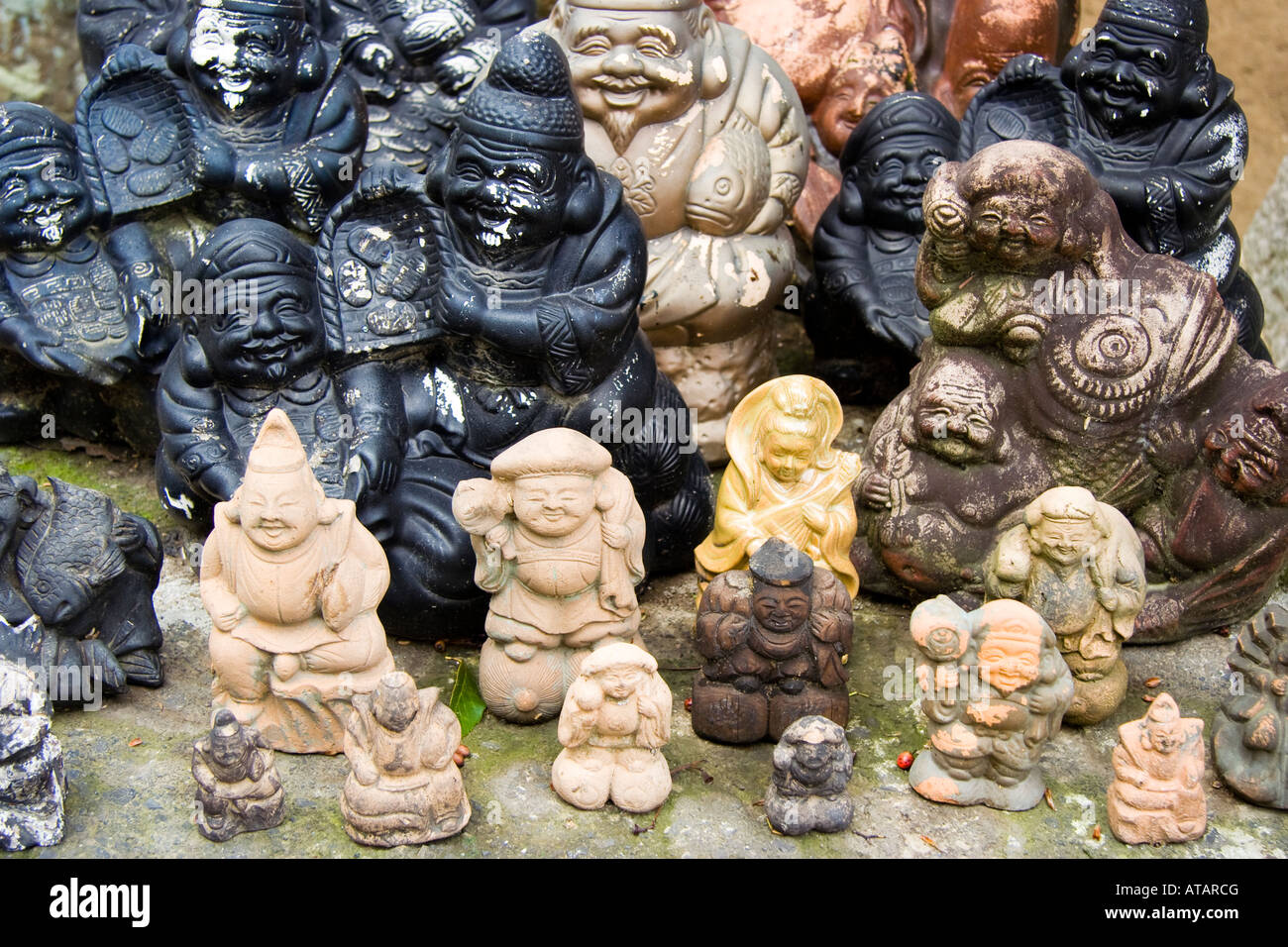 Small statues of the Shichifukujin, seven Japanese gods of happiness and good fortune arranged on the ground at the Achi-jinja shrine at Kurashiki. Stock Photohttps://www.alamy.com/image-license-details/?v=1https://www.alamy.com/stock-photo-small-statues-of-the-shichifukujin-seven-japanese-gods-of-happiness-16258623.html
Small statues of the Shichifukujin, seven Japanese gods of happiness and good fortune arranged on the ground at the Achi-jinja shrine at Kurashiki. Stock Photohttps://www.alamy.com/image-license-details/?v=1https://www.alamy.com/stock-photo-small-statues-of-the-shichifukujin-seven-japanese-gods-of-happiness-16258623.htmlRMATARCG–Small statues of the Shichifukujin, seven Japanese gods of happiness and good fortune arranged on the ground at the Achi-jinja shrine at Kurashiki.
![[ 1920s Japan - Japanese Deity of Good Fortune ] — Hikifuda (引札), a print used as an advertising flyer by local shops. They were popular from the 1800s through the 1920s. A woman and two children sit on the ground looking at Ebisu, one of the seven deities of fortune (Shichi Fukujin), who is counting. 20th century vintage advertising flyer. Stock Photo [ 1920s Japan - Japanese Deity of Good Fortune ] — Hikifuda (引札), a print used as an advertising flyer by local shops. They were popular from the 1800s through the 1920s. A woman and two children sit on the ground looking at Ebisu, one of the seven deities of fortune (Shichi Fukujin), who is counting. 20th century vintage advertising flyer. Stock Photo](https://c8.alamy.com/comp/2BMYT92/1920s-japan-japanese-deity-of-good-fortune-hikifuda-a-print-used-as-an-advertising-flyer-by-local-shops-they-were-popular-from-the-1800s-through-the-1920s-a-woman-and-two-children-sit-on-the-ground-looking-at-ebisu-one-of-the-seven-deities-of-fortune-shichi-fukujin-who-is-counting-20th-century-vintage-advertising-flyer-2BMYT92.jpg) [ 1920s Japan - Japanese Deity of Good Fortune ] — Hikifuda (引札), a print used as an advertising flyer by local shops. They were popular from the 1800s through the 1920s. A woman and two children sit on the ground looking at Ebisu, one of the seven deities of fortune (Shichi Fukujin), who is counting. 20th century vintage advertising flyer. Stock Photohttps://www.alamy.com/image-license-details/?v=1https://www.alamy.com/1920s-japan-japanese-deity-of-good-fortune-hikifuda-a-print-used-as-an-advertising-flyer-by-local-shops-they-were-popular-from-the-1800s-through-the-1920s-a-woman-and-two-children-sit-on-the-ground-looking-at-ebisu-one-of-the-seven-deities-of-fortune-shichi-fukujin-who-is-counting-20th-century-vintage-advertising-flyer-image357112254.html
[ 1920s Japan - Japanese Deity of Good Fortune ] — Hikifuda (引札), a print used as an advertising flyer by local shops. They were popular from the 1800s through the 1920s. A woman and two children sit on the ground looking at Ebisu, one of the seven deities of fortune (Shichi Fukujin), who is counting. 20th century vintage advertising flyer. Stock Photohttps://www.alamy.com/image-license-details/?v=1https://www.alamy.com/1920s-japan-japanese-deity-of-good-fortune-hikifuda-a-print-used-as-an-advertising-flyer-by-local-shops-they-were-popular-from-the-1800s-through-the-1920s-a-woman-and-two-children-sit-on-the-ground-looking-at-ebisu-one-of-the-seven-deities-of-fortune-shichi-fukujin-who-is-counting-20th-century-vintage-advertising-flyer-image357112254.htmlRM2BMYT92–[ 1920s Japan - Japanese Deity of Good Fortune ] — Hikifuda (引札), a print used as an advertising flyer by local shops. They were popular from the 1800s through the 1920s. A woman and two children sit on the ground looking at Ebisu, one of the seven deities of fortune (Shichi Fukujin), who is counting. 20th century vintage advertising flyer.
 Cute and simple illustration of seven gods of good fortune Ebisu, Vector Illustarion Stock Vectorhttps://www.alamy.com/image-license-details/?v=1https://www.alamy.com/cute-and-simple-illustration-of-seven-gods-of-good-fortune-ebisu-vector-illustarion-image560990889.html
Cute and simple illustration of seven gods of good fortune Ebisu, Vector Illustarion Stock Vectorhttps://www.alamy.com/image-license-details/?v=1https://www.alamy.com/cute-and-simple-illustration-of-seven-gods-of-good-fortune-ebisu-vector-illustarion-image560990889.htmlRF2RGK9GW–Cute and simple illustration of seven gods of good fortune Ebisu, Vector Illustarion
 Ebisu as Courtesan with Sea Bream, from Visual Pun, the Seven Gods of Good Fortune, artist unknown, c. 1825, print - Stock Photohttps://www.alamy.com/image-license-details/?v=1https://www.alamy.com/ebisu-as-courtesan-with-sea-bream-from-visual-pun-the-seven-gods-of-good-fortune-artist-unknown-c-1825-print-image265056951.html
Ebisu as Courtesan with Sea Bream, from Visual Pun, the Seven Gods of Good Fortune, artist unknown, c. 1825, print - Stock Photohttps://www.alamy.com/image-license-details/?v=1https://www.alamy.com/ebisu-as-courtesan-with-sea-bream-from-visual-pun-the-seven-gods-of-good-fortune-artist-unknown-c-1825-print-image265056951.htmlRMWB6ARK–Ebisu as Courtesan with Sea Bream, from Visual Pun, the Seven Gods of Good Fortune, artist unknown, c. 1825, print -
 Osaka by Night, Shinsaibashi JP Stock Photohttps://www.alamy.com/image-license-details/?v=1https://www.alamy.com/stock-photo-osaka-by-night-shinsaibashi-jp-21691548.html
Osaka by Night, Shinsaibashi JP Stock Photohttps://www.alamy.com/image-license-details/?v=1https://www.alamy.com/stock-photo-osaka-by-night-shinsaibashi-jp-21691548.htmlRMB783P4–Osaka by Night, Shinsaibashi JP
 Art inspired by Ebisu and Benten walking in the snow, Utagawa Toyohiro, artist, 1810-1820, Tokyo, woodcut, This Japanese woodblock print is a good example of surimono, limited-edition, privately commissioned prints which are finely crafted, smaller than an ōban, they often combine verse, Classic works modernized by Artotop with a splash of modernity. Shapes, color and value, eye-catching visual impact on art. Emotions through freedom of artworks in a contemporary way. A timeless message pursuing a wildly creative new direction. Artists turning to the digital medium and creating the Artotop NFT Stock Photohttps://www.alamy.com/image-license-details/?v=1https://www.alamy.com/art-inspired-by-ebisu-and-benten-walking-in-the-snow-utagawa-toyohiro-artist-1810-1820-tokyo-woodcut-this-japanese-woodblock-print-is-a-good-example-of-surimono-limited-edition-privately-commissioned-prints-which-are-finely-crafted-smaller-than-an-ban-they-often-combine-verse-classic-works-modernized-by-artotop-with-a-splash-of-modernity-shapes-color-and-value-eye-catching-visual-impact-on-art-emotions-through-freedom-of-artworks-in-a-contemporary-way-a-timeless-message-pursuing-a-wildly-creative-new-direction-artists-turning-to-the-digital-medium-and-creating-the-artotop-nft-image459611923.html
Art inspired by Ebisu and Benten walking in the snow, Utagawa Toyohiro, artist, 1810-1820, Tokyo, woodcut, This Japanese woodblock print is a good example of surimono, limited-edition, privately commissioned prints which are finely crafted, smaller than an ōban, they often combine verse, Classic works modernized by Artotop with a splash of modernity. Shapes, color and value, eye-catching visual impact on art. Emotions through freedom of artworks in a contemporary way. A timeless message pursuing a wildly creative new direction. Artists turning to the digital medium and creating the Artotop NFT Stock Photohttps://www.alamy.com/image-license-details/?v=1https://www.alamy.com/art-inspired-by-ebisu-and-benten-walking-in-the-snow-utagawa-toyohiro-artist-1810-1820-tokyo-woodcut-this-japanese-woodblock-print-is-a-good-example-of-surimono-limited-edition-privately-commissioned-prints-which-are-finely-crafted-smaller-than-an-ban-they-often-combine-verse-classic-works-modernized-by-artotop-with-a-splash-of-modernity-shapes-color-and-value-eye-catching-visual-impact-on-art-emotions-through-freedom-of-artworks-in-a-contemporary-way-a-timeless-message-pursuing-a-wildly-creative-new-direction-artists-turning-to-the-digital-medium-and-creating-the-artotop-nft-image459611923.htmlRF2HKN3KF–Art inspired by Ebisu and Benten walking in the snow, Utagawa Toyohiro, artist, 1810-1820, Tokyo, woodcut, This Japanese woodblock print is a good example of surimono, limited-edition, privately commissioned prints which are finely crafted, smaller than an ōban, they often combine verse, Classic works modernized by Artotop with a splash of modernity. Shapes, color and value, eye-catching visual impact on art. Emotions through freedom of artworks in a contemporary way. A timeless message pursuing a wildly creative new direction. Artists turning to the digital medium and creating the Artotop NFT
 Statue of the Japanese God, Ebisu, aka Webisu, Hiruko god of fishermen and luck. One of the seven gods of good fortune, shichifukujin.. Stock Photohttps://www.alamy.com/image-license-details/?v=1https://www.alamy.com/stock-photo-statue-of-the-japanese-god-ebisu-aka-webisu-hiruko-god-of-fishermen-89764722.html
Statue of the Japanese God, Ebisu, aka Webisu, Hiruko god of fishermen and luck. One of the seven gods of good fortune, shichifukujin.. Stock Photohttps://www.alamy.com/image-license-details/?v=1https://www.alamy.com/stock-photo-statue-of-the-japanese-god-ebisu-aka-webisu-hiruko-god-of-fishermen-89764722.htmlRMF613PX–Statue of the Japanese God, Ebisu, aka Webisu, Hiruko god of fishermen and luck. One of the seven gods of good fortune, shichifukujin..
 Ōkyo Picture Album 1850 (preface dated 1833) After Maruyama Ōkyo Japanese This book with woodblock-printed reproductions based on paintings by Maruyama Ōkyo contains twenty-four spreads with images of a variety of topics, in addition to the foreword and the calligraphic motto, “Songs of the Brush, Dances of Ink” (hikka bokubu 筆歌墨舞). The pictures span motifs of the four seasons, such as the blossoming plum branch, four of the Seven Gods of Good Fortune (Ebisu, Hotei, Fukurokuju, and Jurōjin), and various subject matter that Ōkyo commonly painted, including turtles, cranes and young pine trees. Stock Photohttps://www.alamy.com/image-license-details/?v=1https://www.alamy.com/kyo-picture-album-1850-preface-dated-1833-after-maruyama-kyo-japanese-this-book-with-woodblock-printed-reproductions-based-on-paintings-by-maruyama-kyo-contains-twenty-four-spreads-with-images-of-a-variety-of-topics-in-addition-to-the-foreword-and-the-calligraphic-motto-songs-of-the-brush-dances-of-ink-hikka-bokubu-the-pictures-span-motifs-of-the-four-seasons-such-as-the-blossoming-plum-branch-four-of-the-seven-gods-of-good-fortune-ebisu-hotei-fukurokuju-and-jurjin-and-various-subject-matter-that-kyo-commonly-painted-including-turtles-cranes-and-young-pine-trees-image458501630.html
Ōkyo Picture Album 1850 (preface dated 1833) After Maruyama Ōkyo Japanese This book with woodblock-printed reproductions based on paintings by Maruyama Ōkyo contains twenty-four spreads with images of a variety of topics, in addition to the foreword and the calligraphic motto, “Songs of the Brush, Dances of Ink” (hikka bokubu 筆歌墨舞). The pictures span motifs of the four seasons, such as the blossoming plum branch, four of the Seven Gods of Good Fortune (Ebisu, Hotei, Fukurokuju, and Jurōjin), and various subject matter that Ōkyo commonly painted, including turtles, cranes and young pine trees. Stock Photohttps://www.alamy.com/image-license-details/?v=1https://www.alamy.com/kyo-picture-album-1850-preface-dated-1833-after-maruyama-kyo-japanese-this-book-with-woodblock-printed-reproductions-based-on-paintings-by-maruyama-kyo-contains-twenty-four-spreads-with-images-of-a-variety-of-topics-in-addition-to-the-foreword-and-the-calligraphic-motto-songs-of-the-brush-dances-of-ink-hikka-bokubu-the-pictures-span-motifs-of-the-four-seasons-such-as-the-blossoming-plum-branch-four-of-the-seven-gods-of-good-fortune-ebisu-hotei-fukurokuju-and-jurjin-and-various-subject-matter-that-kyo-commonly-painted-including-turtles-cranes-and-young-pine-trees-image458501630.htmlRM2HHXFE6–Ōkyo Picture Album 1850 (preface dated 1833) After Maruyama Ōkyo Japanese This book with woodblock-printed reproductions based on paintings by Maruyama Ōkyo contains twenty-four spreads with images of a variety of topics, in addition to the foreword and the calligraphic motto, “Songs of the Brush, Dances of Ink” (hikka bokubu 筆歌墨舞). The pictures span motifs of the four seasons, such as the blossoming plum branch, four of the Seven Gods of Good Fortune (Ebisu, Hotei, Fukurokuju, and Jurōjin), and various subject matter that Ōkyo commonly painted, including turtles, cranes and young pine trees.
 Art inspired by Seven Gods of Good Fortune and Chinese Children, Edo period (1615–1868), 17th–18th century, Japan, One of a pair of six-panel folding screens; ink, color, and gilt on paper; Reverse side: ink, color, and gold on paper, 69 1/4 x 153 in. (175.9 x 388.6 cm), Screens, Kano, Classic works modernized by Artotop with a splash of modernity. Shapes, color and value, eye-catching visual impact on art. Emotions through freedom of artworks in a contemporary way. A timeless message pursuing a wildly creative new direction. Artists turning to the digital medium and creating the Artotop NFT Stock Photohttps://www.alamy.com/image-license-details/?v=1https://www.alamy.com/art-inspired-by-seven-gods-of-good-fortune-and-chinese-children-edo-period-16151868-17th18th-century-japan-one-of-a-pair-of-six-panel-folding-screens-ink-color-and-gilt-on-paper-reverse-side-ink-color-and-gold-on-paper-69-14-x-153-in-1759-x-3886-cm-screens-kano-classic-works-modernized-by-artotop-with-a-splash-of-modernity-shapes-color-and-value-eye-catching-visual-impact-on-art-emotions-through-freedom-of-artworks-in-a-contemporary-way-a-timeless-message-pursuing-a-wildly-creative-new-direction-artists-turning-to-the-digital-medium-and-creating-the-artotop-nft-image462910140.html
Art inspired by Seven Gods of Good Fortune and Chinese Children, Edo period (1615–1868), 17th–18th century, Japan, One of a pair of six-panel folding screens; ink, color, and gilt on paper; Reverse side: ink, color, and gold on paper, 69 1/4 x 153 in. (175.9 x 388.6 cm), Screens, Kano, Classic works modernized by Artotop with a splash of modernity. Shapes, color and value, eye-catching visual impact on art. Emotions through freedom of artworks in a contemporary way. A timeless message pursuing a wildly creative new direction. Artists turning to the digital medium and creating the Artotop NFT Stock Photohttps://www.alamy.com/image-license-details/?v=1https://www.alamy.com/art-inspired-by-seven-gods-of-good-fortune-and-chinese-children-edo-period-16151868-17th18th-century-japan-one-of-a-pair-of-six-panel-folding-screens-ink-color-and-gilt-on-paper-reverse-side-ink-color-and-gold-on-paper-69-14-x-153-in-1759-x-3886-cm-screens-kano-classic-works-modernized-by-artotop-with-a-splash-of-modernity-shapes-color-and-value-eye-catching-visual-impact-on-art-emotions-through-freedom-of-artworks-in-a-contemporary-way-a-timeless-message-pursuing-a-wildly-creative-new-direction-artists-turning-to-the-digital-medium-and-creating-the-artotop-nft-image462910140.htmlRF2HW3AH0–Art inspired by Seven Gods of Good Fortune and Chinese Children, Edo period (1615–1868), 17th–18th century, Japan, One of a pair of six-panel folding screens; ink, color, and gilt on paper; Reverse side: ink, color, and gold on paper, 69 1/4 x 153 in. (175.9 x 388.6 cm), Screens, Kano, Classic works modernized by Artotop with a splash of modernity. Shapes, color and value, eye-catching visual impact on art. Emotions through freedom of artworks in a contemporary way. A timeless message pursuing a wildly creative new direction. Artists turning to the digital medium and creating the Artotop NFT
 Statuette of Japanese Ebisu god isolated on white background Stock Photohttps://www.alamy.com/image-license-details/?v=1https://www.alamy.com/stock-photo-statuette-of-japanese-ebisu-god-isolated-on-white-background-76163526.html
Statuette of Japanese Ebisu god isolated on white background Stock Photohttps://www.alamy.com/image-license-details/?v=1https://www.alamy.com/stock-photo-statuette-of-japanese-ebisu-god-isolated-on-white-background-76163526.htmlRFEBWF9X–Statuette of Japanese Ebisu god isolated on white background
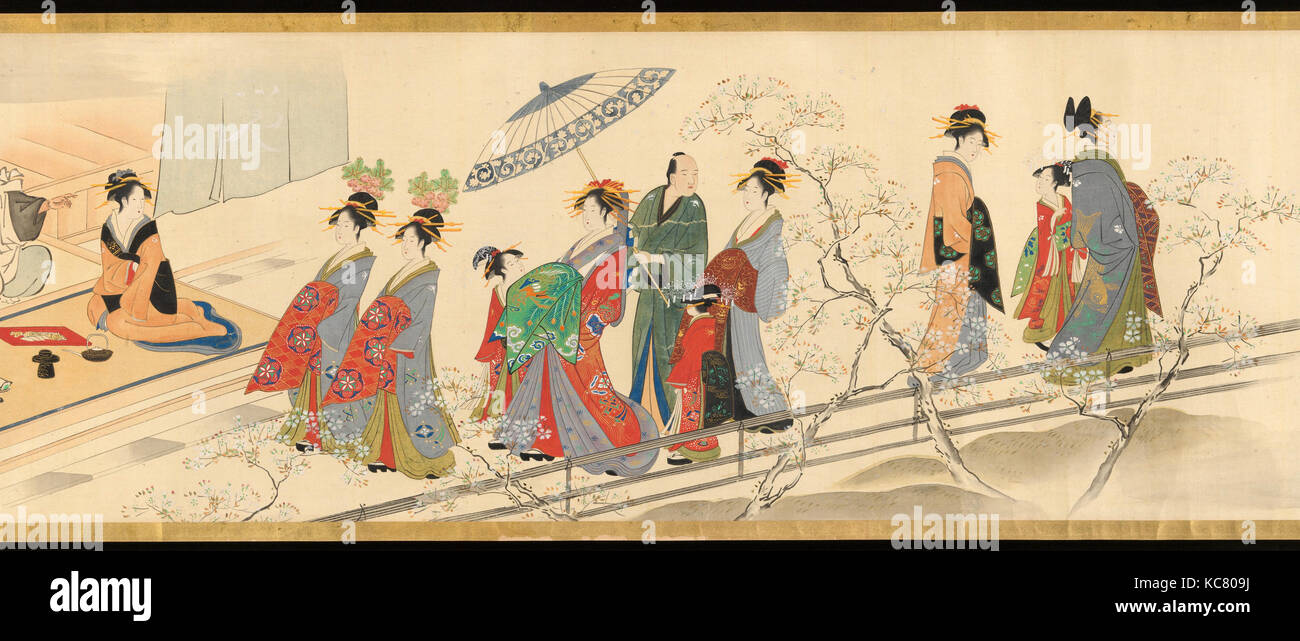 三幅神吉原通い図巻 「全盛季春遊戯」, Three Gods of Good Fortune Visit the Yoshiwara; or “Scenes of Pleasure at the Height of Spring Stock Photohttps://www.alamy.com/image-license-details/?v=1https://www.alamy.com/stock-image-three-gods-of-good-fortune-visit-the-yoshiwara-or-scenes-of-pleasure-162445070.html
三幅神吉原通い図巻 「全盛季春遊戯」, Three Gods of Good Fortune Visit the Yoshiwara; or “Scenes of Pleasure at the Height of Spring Stock Photohttps://www.alamy.com/image-license-details/?v=1https://www.alamy.com/stock-image-three-gods-of-good-fortune-visit-the-yoshiwara-or-scenes-of-pleasure-162445070.htmlRMKC809J–三幅神吉原通い図巻 「全盛季春遊戯」, Three Gods of Good Fortune Visit the Yoshiwara; or “Scenes of Pleasure at the Height of Spring
 Seven gods of good fortune in the treasure boat Stock Photohttps://www.alamy.com/image-license-details/?v=1https://www.alamy.com/stock-photo-seven-gods-of-good-fortune-in-the-treasure-boat-105337644.html
Seven gods of good fortune in the treasure boat Stock Photohttps://www.alamy.com/image-license-details/?v=1https://www.alamy.com/stock-photo-seven-gods-of-good-fortune-in-the-treasure-boat-105337644.htmlRMG3AF6M–Seven gods of good fortune in the treasure boat
 Ebisu and Daikoku; Two of the Seven Gods of Good Fortune 1929 by Totoya Hokkei Stock Photohttps://www.alamy.com/image-license-details/?v=1https://www.alamy.com/ebisu-and-daikoku-two-of-the-seven-gods-of-good-fortune-1929-by-totoya-hokkei-image575106909.html
Ebisu and Daikoku; Two of the Seven Gods of Good Fortune 1929 by Totoya Hokkei Stock Photohttps://www.alamy.com/image-license-details/?v=1https://www.alamy.com/ebisu-and-daikoku-two-of-the-seven-gods-of-good-fortune-1929-by-totoya-hokkei-image575106909.htmlRM2TBJAMD–Ebisu and Daikoku; Two of the Seven Gods of Good Fortune 1929 by Totoya Hokkei
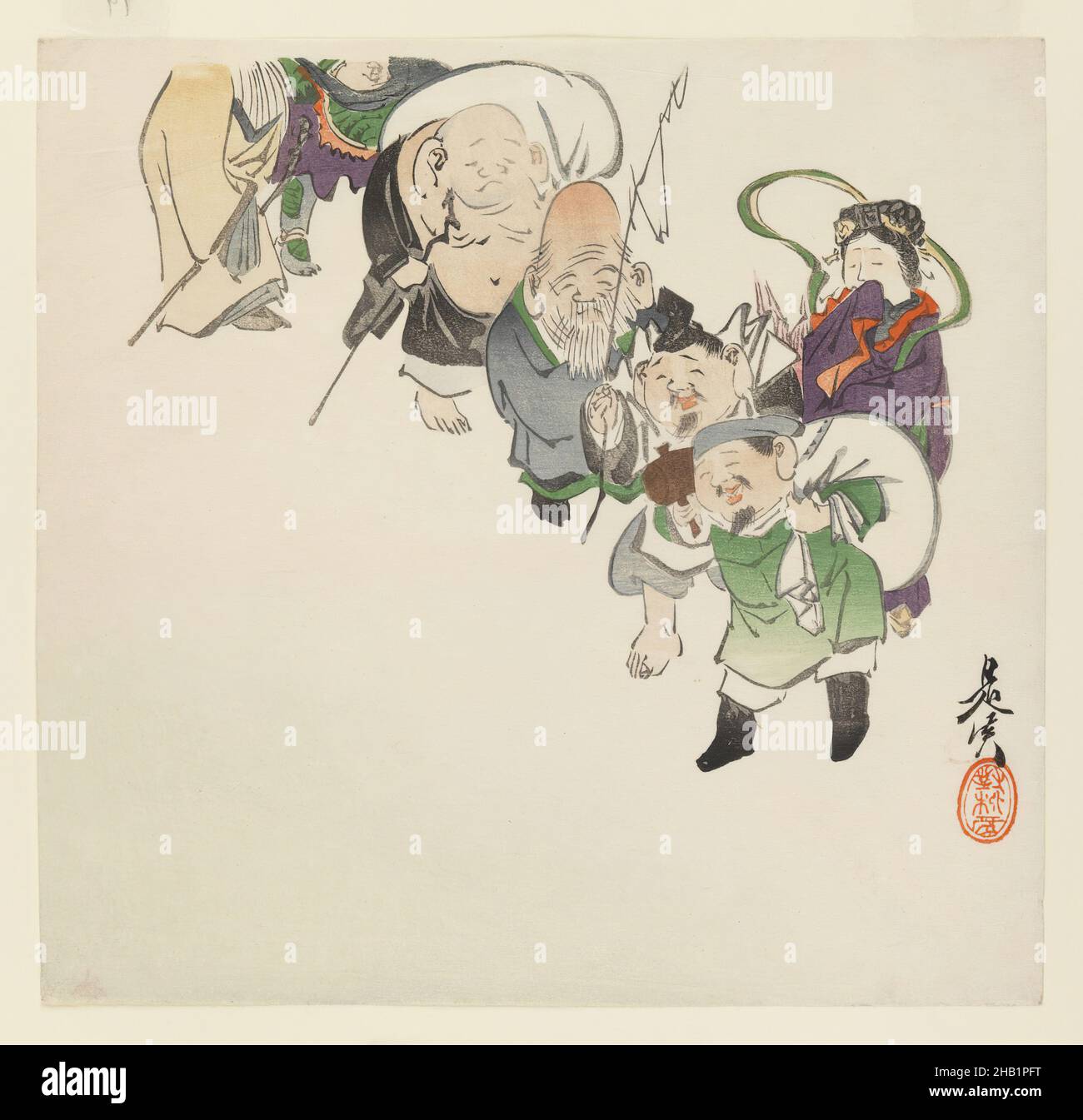 Seven Gods of Good Luck, From the Series Hana Kurabe, Shibata Zeshin, Japanese, 1807-1891, Woodblock color print, Japan, ca. 1885, Meiji Period, 9 1/2 x 9 7/8 in., 24.1 x 25.1 cm, Benzaiten, Bishamonten, Daikokuten, Ebisu, Fukurokuju, Hotei, Japanese mythology, Jurōjin, Seven Gods of Fortune, Shichi Fukujin Stock Photohttps://www.alamy.com/image-license-details/?v=1https://www.alamy.com/seven-gods-of-good-luck-from-the-series-hana-kurabe-shibata-zeshin-japanese-1807-1891-woodblock-color-print-japan-ca-1885-meiji-period-9-12-x-9-78-in-241-x-251-cm-benzaiten-bishamonten-daikokuten-ebisu-fukurokuju-hotei-japanese-mythology-jurjin-seven-gods-of-fortune-shichi-fukujin-image454270428.html
Seven Gods of Good Luck, From the Series Hana Kurabe, Shibata Zeshin, Japanese, 1807-1891, Woodblock color print, Japan, ca. 1885, Meiji Period, 9 1/2 x 9 7/8 in., 24.1 x 25.1 cm, Benzaiten, Bishamonten, Daikokuten, Ebisu, Fukurokuju, Hotei, Japanese mythology, Jurōjin, Seven Gods of Fortune, Shichi Fukujin Stock Photohttps://www.alamy.com/image-license-details/?v=1https://www.alamy.com/seven-gods-of-good-luck-from-the-series-hana-kurabe-shibata-zeshin-japanese-1807-1891-woodblock-color-print-japan-ca-1885-meiji-period-9-12-x-9-78-in-241-x-251-cm-benzaiten-bishamonten-daikokuten-ebisu-fukurokuju-hotei-japanese-mythology-jurjin-seven-gods-of-fortune-shichi-fukujin-image454270428.htmlRM2HB1PFT–Seven Gods of Good Luck, From the Series Hana Kurabe, Shibata Zeshin, Japanese, 1807-1891, Woodblock color print, Japan, ca. 1885, Meiji Period, 9 1/2 x 9 7/8 in., 24.1 x 25.1 cm, Benzaiten, Bishamonten, Daikokuten, Ebisu, Fukurokuju, Hotei, Japanese mythology, Jurōjin, Seven Gods of Fortune, Shichi Fukujin
 Ebisu Garden Tokyo Luxury fashion trendy japan Stock Photohttps://www.alamy.com/image-license-details/?v=1https://www.alamy.com/stock-photo-ebisu-garden-tokyo-luxury-fashion-trendy-japan-11889050.html
Ebisu Garden Tokyo Luxury fashion trendy japan Stock Photohttps://www.alamy.com/image-license-details/?v=1https://www.alamy.com/stock-photo-ebisu-garden-tokyo-luxury-fashion-trendy-japan-11889050.htmlRMA7PAMY–Ebisu Garden Tokyo Luxury fashion trendy japan
 A statue of Ebisu, one of the Seven Gods of Fortune at the Toyokawa Inari Betsuin temple in Asakusa, Tokyo, Japan. The Buddhist temple is part of the Soto Zen sect and enshrines the deity Toyokawa Dakinishinten but also known for the thousands of fox statues. Stock Photohttps://www.alamy.com/image-license-details/?v=1https://www.alamy.com/a-statue-of-ebisu-one-of-the-seven-gods-of-fortune-at-the-toyokawa-inari-betsuin-temple-in-asakusa-tokyo-japan-the-buddhist-temple-is-part-of-the-soto-zen-sect-and-enshrines-the-deity-toyokawa-dakinishinten-but-also-known-for-the-thousands-of-fox-statues-image449421676.html
A statue of Ebisu, one of the Seven Gods of Fortune at the Toyokawa Inari Betsuin temple in Asakusa, Tokyo, Japan. The Buddhist temple is part of the Soto Zen sect and enshrines the deity Toyokawa Dakinishinten but also known for the thousands of fox statues. Stock Photohttps://www.alamy.com/image-license-details/?v=1https://www.alamy.com/a-statue-of-ebisu-one-of-the-seven-gods-of-fortune-at-the-toyokawa-inari-betsuin-temple-in-asakusa-tokyo-japan-the-buddhist-temple-is-part-of-the-soto-zen-sect-and-enshrines-the-deity-toyokawa-dakinishinten-but-also-known-for-the-thousands-of-fox-statues-image449421676.htmlRM2H34WX4–A statue of Ebisu, one of the Seven Gods of Fortune at the Toyokawa Inari Betsuin temple in Asakusa, Tokyo, Japan. The Buddhist temple is part of the Soto Zen sect and enshrines the deity Toyokawa Dakinishinten but also known for the thousands of fox statues.
 Seven gods of good fortune Stock Photohttps://www.alamy.com/image-license-details/?v=1https://www.alamy.com/seven-gods-of-good-fortune-image627518057.html
Seven gods of good fortune Stock Photohttps://www.alamy.com/image-license-details/?v=1https://www.alamy.com/seven-gods-of-good-fortune-image627518057.htmlRF2YCWWK5–Seven gods of good fortune
 A Woman as Ebisu, from the series 'Seven Women as the Gods of Good Fortune for the Hanagasa Poetry Club (Hanagasaren shichifukujin)'. Katsukawa Shuntei; Japanese, 1770-1824. Date: 1815-1820. Dimensions: 19.4 x 17.1 cm (7 5/8 x 6 11/16 in.). Color woodblock print; shikishiban, surimono. Origin: Japan. Museum: The Chicago Art Institute. Stock Photohttps://www.alamy.com/image-license-details/?v=1https://www.alamy.com/a-woman-as-ebisu-from-the-series-seven-women-as-the-gods-of-good-fortune-for-the-hanagasa-poetry-club-hanagasaren-shichifukujin-katsukawa-shuntei-japanese-1770-1824-date-1815-1820-dimensions-194-x-171-cm-7-58-x-6-1116-in-color-woodblock-print-shikishiban-surimono-origin-japan-museum-the-chicago-art-institute-image239835563.html
A Woman as Ebisu, from the series 'Seven Women as the Gods of Good Fortune for the Hanagasa Poetry Club (Hanagasaren shichifukujin)'. Katsukawa Shuntei; Japanese, 1770-1824. Date: 1815-1820. Dimensions: 19.4 x 17.1 cm (7 5/8 x 6 11/16 in.). Color woodblock print; shikishiban, surimono. Origin: Japan. Museum: The Chicago Art Institute. Stock Photohttps://www.alamy.com/image-license-details/?v=1https://www.alamy.com/a-woman-as-ebisu-from-the-series-seven-women-as-the-gods-of-good-fortune-for-the-hanagasa-poetry-club-hanagasaren-shichifukujin-katsukawa-shuntei-japanese-1770-1824-date-1815-1820-dimensions-194-x-171-cm-7-58-x-6-1116-in-color-woodblock-print-shikishiban-surimono-origin-japan-museum-the-chicago-art-institute-image239835563.htmlRMRX5CKR–A Woman as Ebisu, from the series 'Seven Women as the Gods of Good Fortune for the Hanagasa Poetry Club (Hanagasaren shichifukujin)'. Katsukawa Shuntei; Japanese, 1770-1824. Date: 1815-1820. Dimensions: 19.4 x 17.1 cm (7 5/8 x 6 11/16 in.). Color woodblock print; shikishiban, surimono. Origin: Japan. Museum: The Chicago Art Institute.
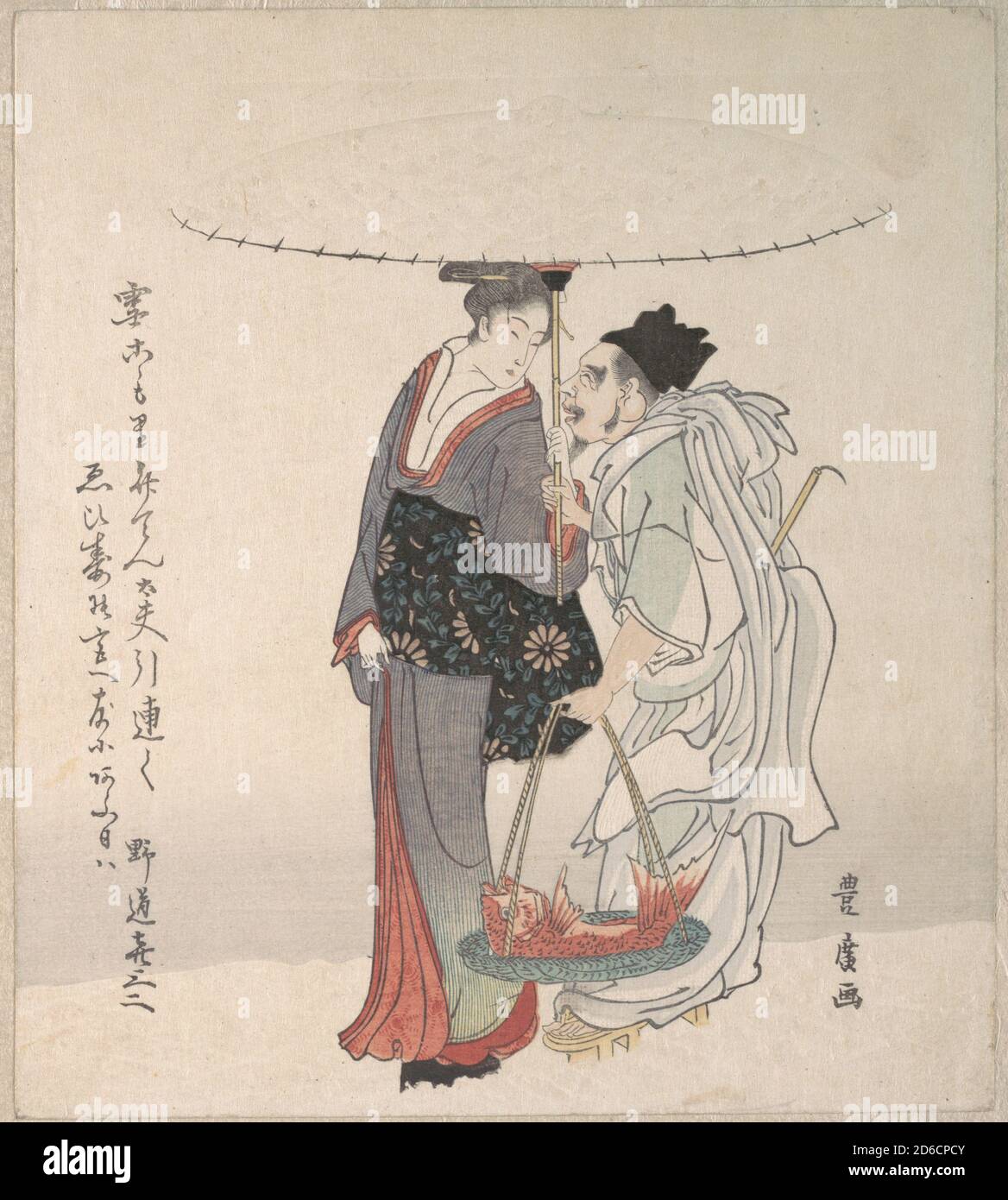 Ebisu and Benten Walking in the Snow. Stock Photohttps://www.alamy.com/image-license-details/?v=1https://www.alamy.com/ebisu-and-benten-walking-in-the-snow-image382597067.html
Ebisu and Benten Walking in the Snow. Stock Photohttps://www.alamy.com/image-license-details/?v=1https://www.alamy.com/ebisu-and-benten-walking-in-the-snow-image382597067.htmlRM2D6CPCY–Ebisu and Benten Walking in the Snow.
 Yashima Gakutei. Ebisu (Shobishin), from the series A Parody of the Seven Gods of Good Fortune (Mitate shichifukujin). 1823–1833. Japan. Color woodblock print; shikishiban, surimono Stock Photohttps://www.alamy.com/image-license-details/?v=1https://www.alamy.com/yashima-gakutei-ebisu-shobishin-from-the-series-a-parody-of-the-seven-gods-of-good-fortune-mitate-shichifukujin-18231833-japan-color-woodblock-print-shikishiban-surimono-image337994663.html
Yashima Gakutei. Ebisu (Shobishin), from the series A Parody of the Seven Gods of Good Fortune (Mitate shichifukujin). 1823–1833. Japan. Color woodblock print; shikishiban, surimono Stock Photohttps://www.alamy.com/image-license-details/?v=1https://www.alamy.com/yashima-gakutei-ebisu-shobishin-from-the-series-a-parody-of-the-seven-gods-of-good-fortune-mitate-shichifukujin-18231833-japan-color-woodblock-print-shikishiban-surimono-image337994663.htmlRM2AHTYHY–Yashima Gakutei. Ebisu (Shobishin), from the series A Parody of the Seven Gods of Good Fortune (Mitate shichifukujin). 1823–1833. Japan. Color woodblock print; shikishiban, surimono
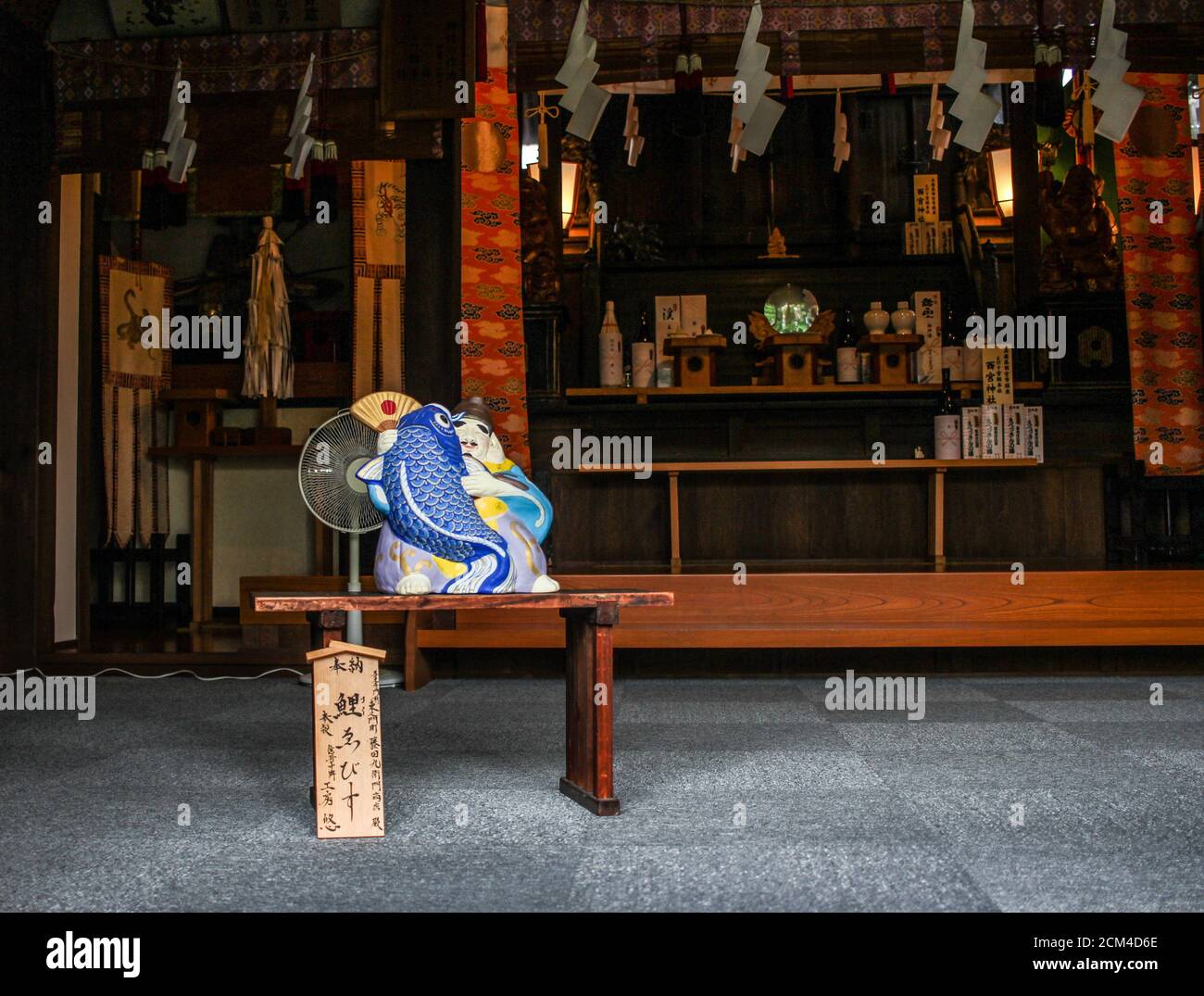 Statue of Ebisu - the god of good luck, fortune and fishermen Stock Photohttps://www.alamy.com/image-license-details/?v=1https://www.alamy.com/statue-of-ebisu-the-god-of-good-luck-fortune-and-fishermen-image373809030.html
Statue of Ebisu - the god of good luck, fortune and fishermen Stock Photohttps://www.alamy.com/image-license-details/?v=1https://www.alamy.com/statue-of-ebisu-the-god-of-good-luck-fortune-and-fishermen-image373809030.htmlRF2CM4D6E–Statue of Ebisu - the god of good luck, fortune and fishermen
 Gods The gods of Wealth fortune Daikoku and Ebisu in the Chogiya bawdy house Stock Photohttps://www.alamy.com/image-license-details/?v=1https://www.alamy.com/gods-the-gods-of-wealth-fortune-daikoku-and-ebisu-in-the-chogiya-bawdy-house-image471296340.html
Gods The gods of Wealth fortune Daikoku and Ebisu in the Chogiya bawdy house Stock Photohttps://www.alamy.com/image-license-details/?v=1https://www.alamy.com/gods-the-gods-of-wealth-fortune-daikoku-and-ebisu-in-the-chogiya-bawdy-house-image471296340.htmlRM2JANB84–Gods The gods of Wealth fortune Daikoku and Ebisu in the Chogiya bawdy house
 Inspired by Seven Gods of Good Luck, From the Series Hana Kurabe, Shibata Zeshin, Japanese, 1807-1891, Woodblock color print, Japan, ca. 1885, Meiji Period, 9 1/2 x 9 7/8 in., 24.1 x 25.1 cm, Benzaiten, Bishamonten, Daikokuten, Ebisu, Fukurokuju, Hotei, Japanese mythology, Jurōjin, Seven Gods of, Reimagined by Artotop. Classic art reinvented with a modern twist. Design of warm cheerful glowing of brightness and light ray radiance. Photography inspired by surrealism and futurism, embracing dynamic energy of modern technology, movement, speed and revolutionize culture Stock Photohttps://www.alamy.com/image-license-details/?v=1https://www.alamy.com/inspired-by-seven-gods-of-good-luck-from-the-series-hana-kurabe-shibata-zeshin-japanese-1807-1891-woodblock-color-print-japan-ca-1885-meiji-period-9-12-x-9-78-in-241-x-251-cm-benzaiten-bishamonten-daikokuten-ebisu-fukurokuju-hotei-japanese-mythology-jurjin-seven-gods-of-reimagined-by-artotop-classic-art-reinvented-with-a-modern-twist-design-of-warm-cheerful-glowing-of-brightness-and-light-ray-radiance-photography-inspired-by-surrealism-and-futurism-embracing-dynamic-energy-of-modern-technology-movement-speed-and-revolutionize-culture-image459249574.html
Inspired by Seven Gods of Good Luck, From the Series Hana Kurabe, Shibata Zeshin, Japanese, 1807-1891, Woodblock color print, Japan, ca. 1885, Meiji Period, 9 1/2 x 9 7/8 in., 24.1 x 25.1 cm, Benzaiten, Bishamonten, Daikokuten, Ebisu, Fukurokuju, Hotei, Japanese mythology, Jurōjin, Seven Gods of, Reimagined by Artotop. Classic art reinvented with a modern twist. Design of warm cheerful glowing of brightness and light ray radiance. Photography inspired by surrealism and futurism, embracing dynamic energy of modern technology, movement, speed and revolutionize culture Stock Photohttps://www.alamy.com/image-license-details/?v=1https://www.alamy.com/inspired-by-seven-gods-of-good-luck-from-the-series-hana-kurabe-shibata-zeshin-japanese-1807-1891-woodblock-color-print-japan-ca-1885-meiji-period-9-12-x-9-78-in-241-x-251-cm-benzaiten-bishamonten-daikokuten-ebisu-fukurokuju-hotei-japanese-mythology-jurjin-seven-gods-of-reimagined-by-artotop-classic-art-reinvented-with-a-modern-twist-design-of-warm-cheerful-glowing-of-brightness-and-light-ray-radiance-photography-inspired-by-surrealism-and-futurism-embracing-dynamic-energy-of-modern-technology-movement-speed-and-revolutionize-culture-image459249574.htmlRF2HK4HEE–Inspired by Seven Gods of Good Luck, From the Series Hana Kurabe, Shibata Zeshin, Japanese, 1807-1891, Woodblock color print, Japan, ca. 1885, Meiji Period, 9 1/2 x 9 7/8 in., 24.1 x 25.1 cm, Benzaiten, Bishamonten, Daikokuten, Ebisu, Fukurokuju, Hotei, Japanese mythology, Jurōjin, Seven Gods of, Reimagined by Artotop. Classic art reinvented with a modern twist. Design of warm cheerful glowing of brightness and light ray radiance. Photography inspired by surrealism and futurism, embracing dynamic energy of modern technology, movement, speed and revolutionize culture
 Ebisu and Daikoku; Two of the Seven Gods of Good Fortune 19th century Totoya Hokkei Japanese. Ebisu and Daikoku; Two of the Seven Gods of Good Fortune 54017 Stock Photohttps://www.alamy.com/image-license-details/?v=1https://www.alamy.com/ebisu-and-daikoku-two-of-the-seven-gods-of-good-fortune-19th-century-totoya-hokkei-japanese-ebisu-and-daikoku-two-of-the-seven-gods-of-good-fortune-54017-image458008031.html
Ebisu and Daikoku; Two of the Seven Gods of Good Fortune 19th century Totoya Hokkei Japanese. Ebisu and Daikoku; Two of the Seven Gods of Good Fortune 54017 Stock Photohttps://www.alamy.com/image-license-details/?v=1https://www.alamy.com/ebisu-and-daikoku-two-of-the-seven-gods-of-good-fortune-19th-century-totoya-hokkei-japanese-ebisu-and-daikoku-two-of-the-seven-gods-of-good-fortune-54017-image458008031.htmlRM2HH41WK–Ebisu and Daikoku; Two of the Seven Gods of Good Fortune 19th century Totoya Hokkei Japanese. Ebisu and Daikoku; Two of the Seven Gods of Good Fortune 54017
 Seven gods of fortune isolated on white background Stock Photohttps://www.alamy.com/image-license-details/?v=1https://www.alamy.com/stock-photo-seven-gods-of-fortune-isolated-on-white-background-75996914.html
Seven gods of fortune isolated on white background Stock Photohttps://www.alamy.com/image-license-details/?v=1https://www.alamy.com/stock-photo-seven-gods-of-fortune-isolated-on-white-background-75996914.htmlRFEBHXRE–Seven gods of fortune isolated on white background
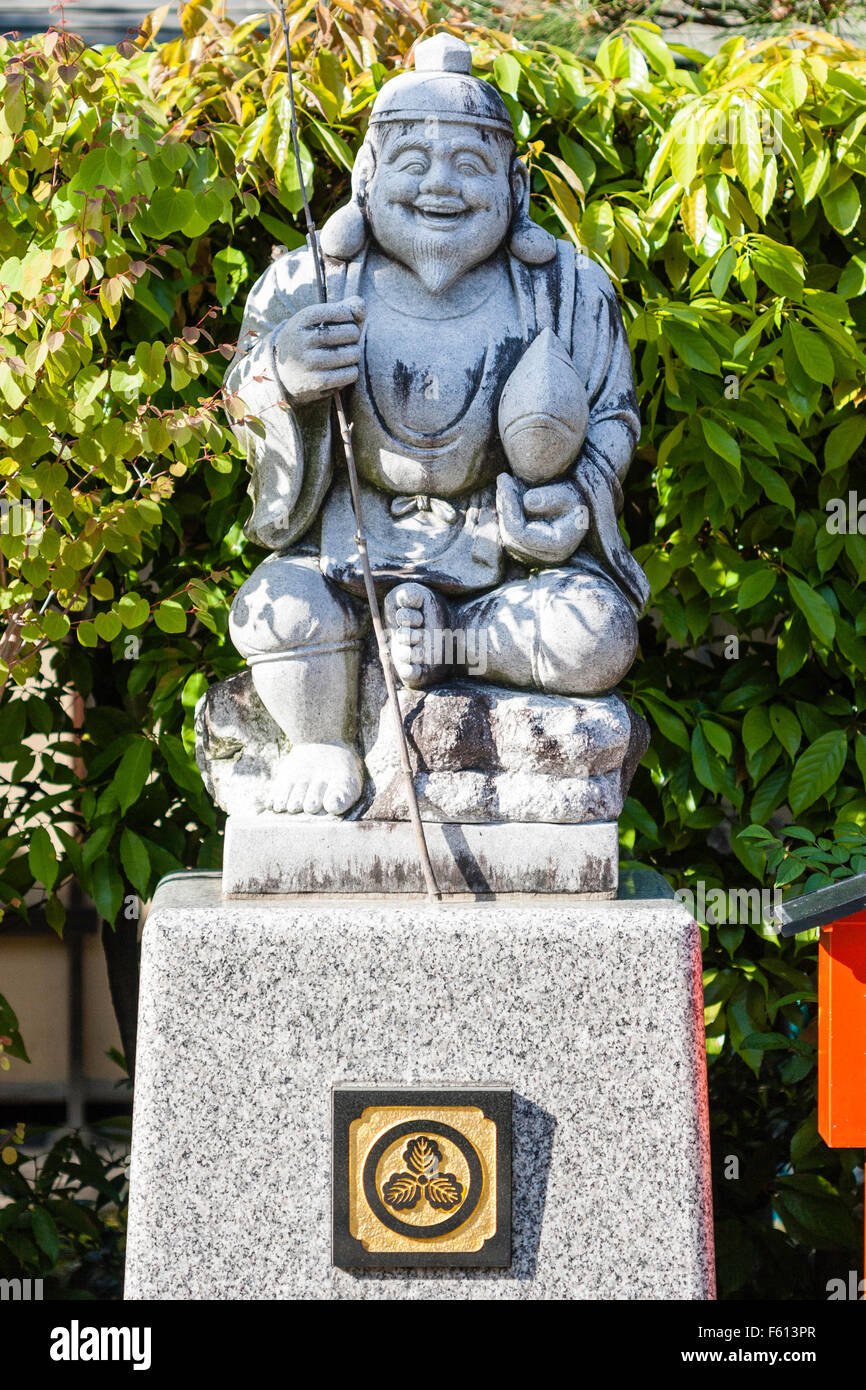 Statue of the Japanese God, Ebisu, aka Webisu, Hiruko god of fishermen and luck. One of the seven gods of good fortune, shichifukujin.. Stock Photohttps://www.alamy.com/image-license-details/?v=1https://www.alamy.com/stock-photo-statue-of-the-japanese-god-ebisu-aka-webisu-hiruko-god-of-fishermen-89764719.html
Statue of the Japanese God, Ebisu, aka Webisu, Hiruko god of fishermen and luck. One of the seven gods of good fortune, shichifukujin.. Stock Photohttps://www.alamy.com/image-license-details/?v=1https://www.alamy.com/stock-photo-statue-of-the-japanese-god-ebisu-aka-webisu-hiruko-god-of-fishermen-89764719.htmlRMF613PR–Statue of the Japanese God, Ebisu, aka Webisu, Hiruko god of fishermen and luck. One of the seven gods of good fortune, shichifukujin..
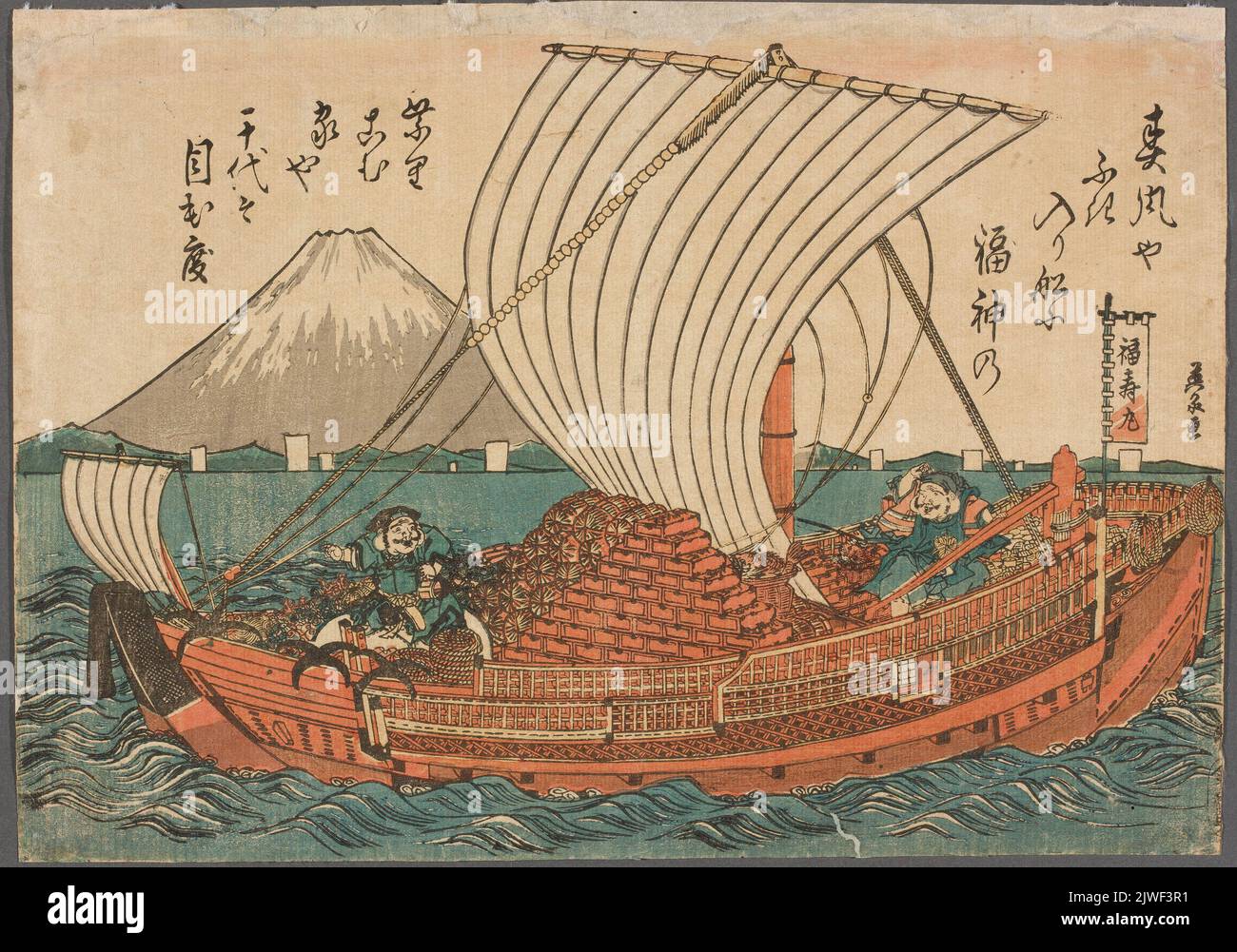 Takarabune, Ship of Good Fortune, led by Daikoku and Ebisu, gods of abundance, belonging to the group of Shichifukujin (Seven Lucky Gods). Eisen,Ikeda (1790-1848), graphic artist Stock Photohttps://www.alamy.com/image-license-details/?v=1https://www.alamy.com/takarabune-ship-of-good-fortune-led-by-daikoku-and-ebisu-gods-of-abundance-belonging-to-the-group-of-shichifukujin-seven-lucky-gods-eisenikeda-1790-1848-graphic-artist-image480378613.html
Takarabune, Ship of Good Fortune, led by Daikoku and Ebisu, gods of abundance, belonging to the group of Shichifukujin (Seven Lucky Gods). Eisen,Ikeda (1790-1848), graphic artist Stock Photohttps://www.alamy.com/image-license-details/?v=1https://www.alamy.com/takarabune-ship-of-good-fortune-led-by-daikoku-and-ebisu-gods-of-abundance-belonging-to-the-group-of-shichifukujin-seven-lucky-gods-eisenikeda-1790-1848-graphic-artist-image480378613.htmlRM2JWF3R1–Takarabune, Ship of Good Fortune, led by Daikoku and Ebisu, gods of abundance, belonging to the group of Shichifukujin (Seven Lucky Gods). Eisen,Ikeda (1790-1848), graphic artist
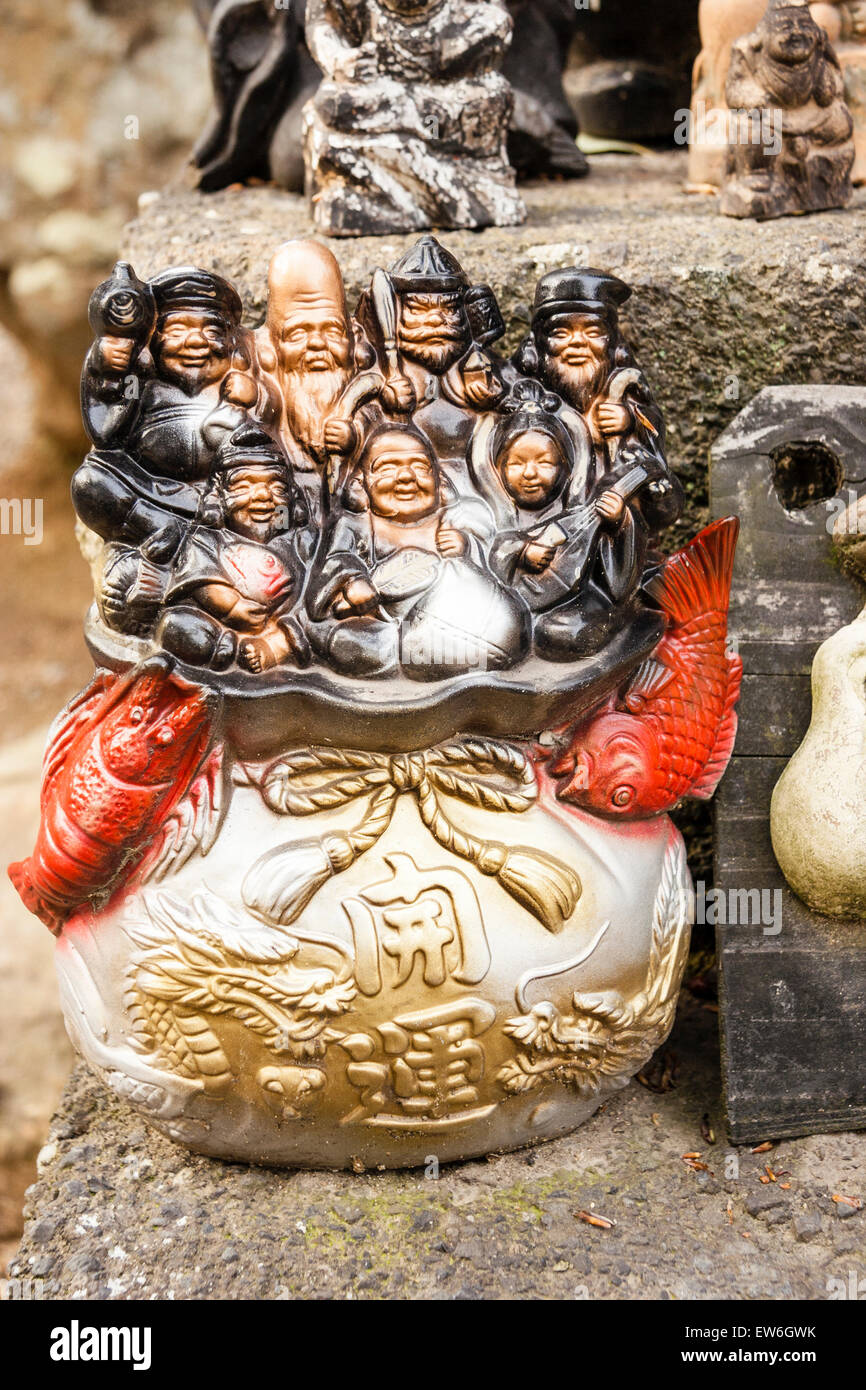 Japan, Kurashiki. Achi-jinja. Pot with Shichifukujin, the seven lucky Japanese Gods of good fortune, on Takarbune, a ship of good fortune. Stock Photohttps://www.alamy.com/image-license-details/?v=1https://www.alamy.com/stock-photo-japan-kurashiki-achi-jinja-pot-with-shichifukujin-the-seven-lucky-84352847.html
Japan, Kurashiki. Achi-jinja. Pot with Shichifukujin, the seven lucky Japanese Gods of good fortune, on Takarbune, a ship of good fortune. Stock Photohttps://www.alamy.com/image-license-details/?v=1https://www.alamy.com/stock-photo-japan-kurashiki-achi-jinja-pot-with-shichifukujin-the-seven-lucky-84352847.htmlRMEW6GWK–Japan, Kurashiki. Achi-jinja. Pot with Shichifukujin, the seven lucky Japanese Gods of good fortune, on Takarbune, a ship of good fortune.
 The courtesan Hinaya from the Chojiya bawdy house as the god Ebisu, from the series: Beautiful women presenting the seven gods of fortune /Keisei mitate shichifukujin Eizan, Kikugawa (1787 1867) Stock Photohttps://www.alamy.com/image-license-details/?v=1https://www.alamy.com/the-courtesan-hinaya-from-the-chojiya-bawdy-house-as-the-god-ebisu-from-the-series-beautiful-women-presenting-the-seven-gods-of-fortune-keisei-mitate-shichifukujin-eizan-kikugawa-1787-1867-image471293524.html
The courtesan Hinaya from the Chojiya bawdy house as the god Ebisu, from the series: Beautiful women presenting the seven gods of fortune /Keisei mitate shichifukujin Eizan, Kikugawa (1787 1867) Stock Photohttps://www.alamy.com/image-license-details/?v=1https://www.alamy.com/the-courtesan-hinaya-from-the-chojiya-bawdy-house-as-the-god-ebisu-from-the-series-beautiful-women-presenting-the-seven-gods-of-fortune-keisei-mitate-shichifukujin-eizan-kikugawa-1787-1867-image471293524.htmlRM2JAN7KG–The courtesan Hinaya from the Chojiya bawdy house as the god Ebisu, from the series: Beautiful women presenting the seven gods of fortune /Keisei mitate shichifukujin Eizan, Kikugawa (1787 1867)
 Ebisu One of the Seven Lucky Gods at Kumagawa Jinja Shrine in Fussa city Tokyo Japan Stock Photohttps://www.alamy.com/image-license-details/?v=1https://www.alamy.com/stock-photo-ebisu-one-of-the-seven-lucky-gods-at-kumagawa-jinja-shrine-in-fussa-148271679.html
Ebisu One of the Seven Lucky Gods at Kumagawa Jinja Shrine in Fussa city Tokyo Japan Stock Photohttps://www.alamy.com/image-license-details/?v=1https://www.alamy.com/stock-photo-ebisu-one-of-the-seven-lucky-gods-at-kumagawa-jinja-shrine-in-fussa-148271679.htmlRMJH6A13–Ebisu One of the Seven Lucky Gods at Kumagawa Jinja Shrine in Fussa city Tokyo Japan
 Ebisu, 1800s. Japan, Edo period (1615-1868). Hanging scroll, ink and color on paper; overall: 129.5 x 30.5 cm (51 x 12 in.). Ebisu, one of the Seven Gods of Good Fortune, takes the guise of a Shinto priest who blesses his catch, a sea bream, with a branch of the camellia tree. Stock Photohttps://www.alamy.com/image-license-details/?v=1https://www.alamy.com/ebisu-1800s-japan-edo-period-1615-1868-hanging-scroll-ink-and-color-on-paper-overall-1295-x-305-cm-51-x-12-in-ebisu-one-of-the-seven-gods-of-good-fortune-takes-the-guise-of-a-shinto-priest-who-blesses-his-catch-a-sea-bream-with-a-branch-of-the-camellia-tree-image448076891.html
Ebisu, 1800s. Japan, Edo period (1615-1868). Hanging scroll, ink and color on paper; overall: 129.5 x 30.5 cm (51 x 12 in.). Ebisu, one of the Seven Gods of Good Fortune, takes the guise of a Shinto priest who blesses his catch, a sea bream, with a branch of the camellia tree. Stock Photohttps://www.alamy.com/image-license-details/?v=1https://www.alamy.com/ebisu-1800s-japan-edo-period-1615-1868-hanging-scroll-ink-and-color-on-paper-overall-1295-x-305-cm-51-x-12-in-ebisu-one-of-the-seven-gods-of-good-fortune-takes-the-guise-of-a-shinto-priest-who-blesses-his-catch-a-sea-bream-with-a-branch-of-the-camellia-tree-image448076891.htmlRM2H0YJJ3–Ebisu, 1800s. Japan, Edo period (1615-1868). Hanging scroll, ink and color on paper; overall: 129.5 x 30.5 cm (51 x 12 in.). Ebisu, one of the Seven Gods of Good Fortune, takes the guise of a Shinto priest who blesses his catch, a sea bream, with a branch of the camellia tree.
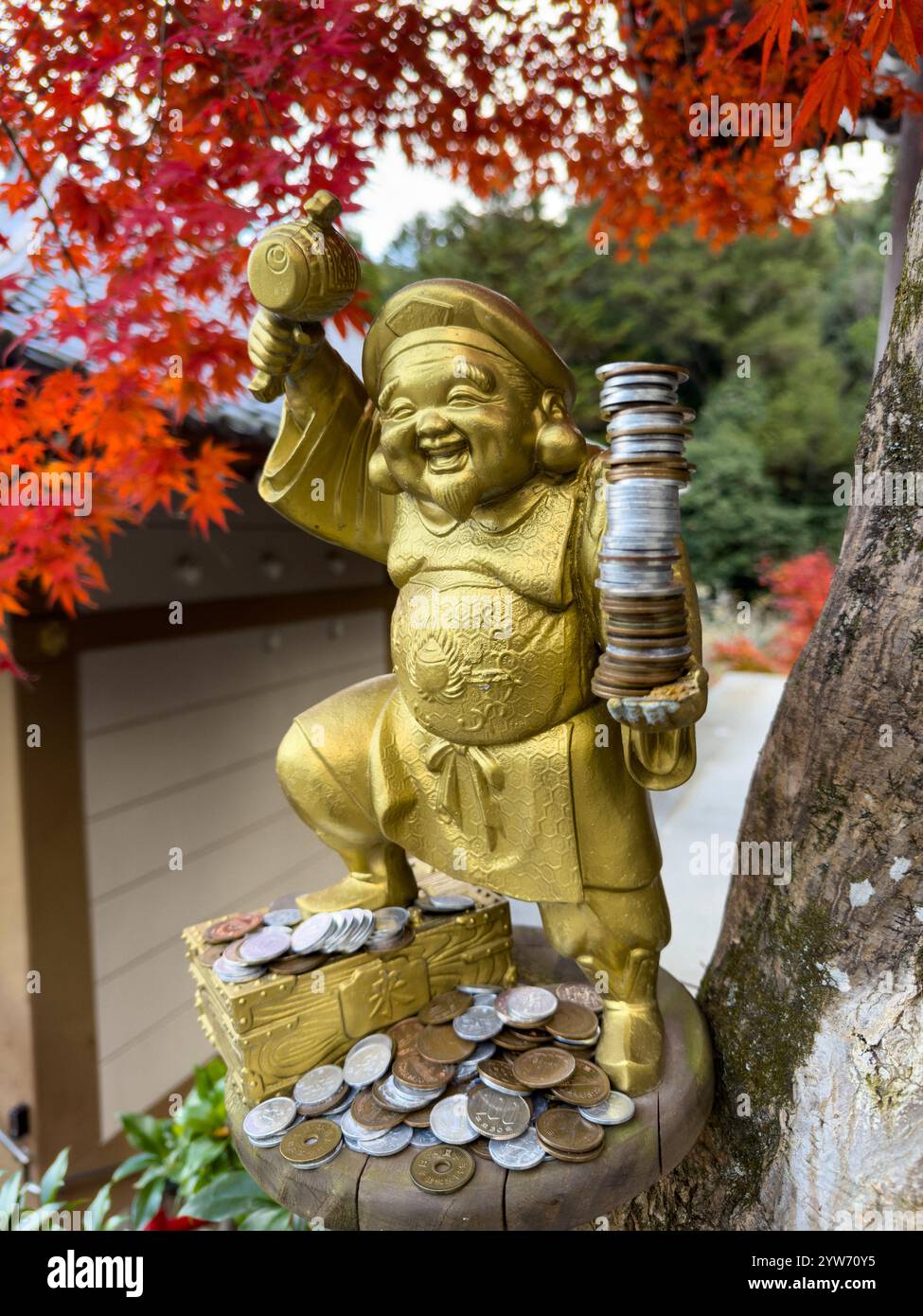 Ebisu Statue with Coins Under Vibrant Autumn Leaves Stock Photohttps://www.alamy.com/image-license-details/?v=1https://www.alamy.com/ebisu-statue-with-coins-under-vibrant-autumn-leaves-image635094073.html
Ebisu Statue with Coins Under Vibrant Autumn Leaves Stock Photohttps://www.alamy.com/image-license-details/?v=1https://www.alamy.com/ebisu-statue-with-coins-under-vibrant-autumn-leaves-image635094073.htmlRM2YW70Y5–Ebisu Statue with Coins Under Vibrant Autumn Leaves
 Seven Gods of Good Fortune and Chinese Children 17th–18th century Kano Chikanobu Japanese In this screen, three of the seven gods of good fortune (Daikoku, Ebisu, and Hotei) and a group of Chinese children serve as visual references to wealth, prosperity, and abundance. Some of the children pull a flower cart (hana-guruma) laden with a bamboo basket overflowing with peonies (emblematic of riches and honor) and other flowers associated with good fortune. The figures display the artist’s awareness of Chinese traditions; in China the theme of One Hundred Boys was a popular and auspicious subject Stock Photohttps://www.alamy.com/image-license-details/?v=1https://www.alamy.com/seven-gods-of-good-fortune-and-chinese-children-17th18th-century-kano-chikanobu-japanese-in-this-screen-three-of-the-seven-gods-of-good-fortune-daikoku-ebisu-and-hotei-and-a-group-of-chinese-children-serve-as-visual-references-to-wealth-prosperity-and-abundance-some-of-the-children-pull-a-flower-cart-hana-guruma-laden-with-a-bamboo-basket-overflowing-with-peonies-emblematic-of-riches-and-honor-and-other-flowers-associated-with-good-fortune-the-figures-display-the-artists-awareness-of-chinese-traditions-in-china-the-theme-of-one-hundred-boys-was-a-popular-and-auspicious-subject-image458560786.html
Seven Gods of Good Fortune and Chinese Children 17th–18th century Kano Chikanobu Japanese In this screen, three of the seven gods of good fortune (Daikoku, Ebisu, and Hotei) and a group of Chinese children serve as visual references to wealth, prosperity, and abundance. Some of the children pull a flower cart (hana-guruma) laden with a bamboo basket overflowing with peonies (emblematic of riches and honor) and other flowers associated with good fortune. The figures display the artist’s awareness of Chinese traditions; in China the theme of One Hundred Boys was a popular and auspicious subject Stock Photohttps://www.alamy.com/image-license-details/?v=1https://www.alamy.com/seven-gods-of-good-fortune-and-chinese-children-17th18th-century-kano-chikanobu-japanese-in-this-screen-three-of-the-seven-gods-of-good-fortune-daikoku-ebisu-and-hotei-and-a-group-of-chinese-children-serve-as-visual-references-to-wealth-prosperity-and-abundance-some-of-the-children-pull-a-flower-cart-hana-guruma-laden-with-a-bamboo-basket-overflowing-with-peonies-emblematic-of-riches-and-honor-and-other-flowers-associated-with-good-fortune-the-figures-display-the-artists-awareness-of-chinese-traditions-in-china-the-theme-of-one-hundred-boys-was-a-popular-and-auspicious-subject-image458560786.htmlRM2HJ16XX–Seven Gods of Good Fortune and Chinese Children 17th–18th century Kano Chikanobu Japanese In this screen, three of the seven gods of good fortune (Daikoku, Ebisu, and Hotei) and a group of Chinese children serve as visual references to wealth, prosperity, and abundance. Some of the children pull a flower cart (hana-guruma) laden with a bamboo basket overflowing with peonies (emblematic of riches and honor) and other flowers associated with good fortune. The figures display the artist’s awareness of Chinese traditions; in China the theme of One Hundred Boys was a popular and auspicious subject
 Ebisu Garden Tokyo trendy fashion luxery modern Stock Photohttps://www.alamy.com/image-license-details/?v=1https://www.alamy.com/stock-photo-ebisu-garden-tokyo-trendy-fashion-luxery-modern-11888674.html
Ebisu Garden Tokyo trendy fashion luxery modern Stock Photohttps://www.alamy.com/image-license-details/?v=1https://www.alamy.com/stock-photo-ebisu-garden-tokyo-trendy-fashion-luxery-modern-11888674.htmlRMA7P9HR–Ebisu Garden Tokyo trendy fashion luxery modern
 Japanese Style Material of Seven Gods of Good Fortune, Treasure Boat and God of Fortune - Translation: Treasure Stock Vectorhttps://www.alamy.com/image-license-details/?v=1https://www.alamy.com/japanese-style-material-of-seven-gods-of-good-fortune-treasure-boat-and-god-of-fortune-translation-treasure-image561582545.html
Japanese Style Material of Seven Gods of Good Fortune, Treasure Boat and God of Fortune - Translation: Treasure Stock Vectorhttps://www.alamy.com/image-license-details/?v=1https://www.alamy.com/japanese-style-material-of-seven-gods-of-good-fortune-treasure-boat-and-god-of-fortune-translation-treasure-image561582545.htmlRF2RHJ87D–Japanese Style Material of Seven Gods of Good Fortune, Treasure Boat and God of Fortune - Translation: Treasure
 Seven gods of good fortune Stock Photohttps://www.alamy.com/image-license-details/?v=1https://www.alamy.com/seven-gods-of-good-fortune-image628094950.html
Seven gods of good fortune Stock Photohttps://www.alamy.com/image-license-details/?v=1https://www.alamy.com/seven-gods-of-good-fortune-image628094950.htmlRF2YDT5EE–Seven gods of good fortune
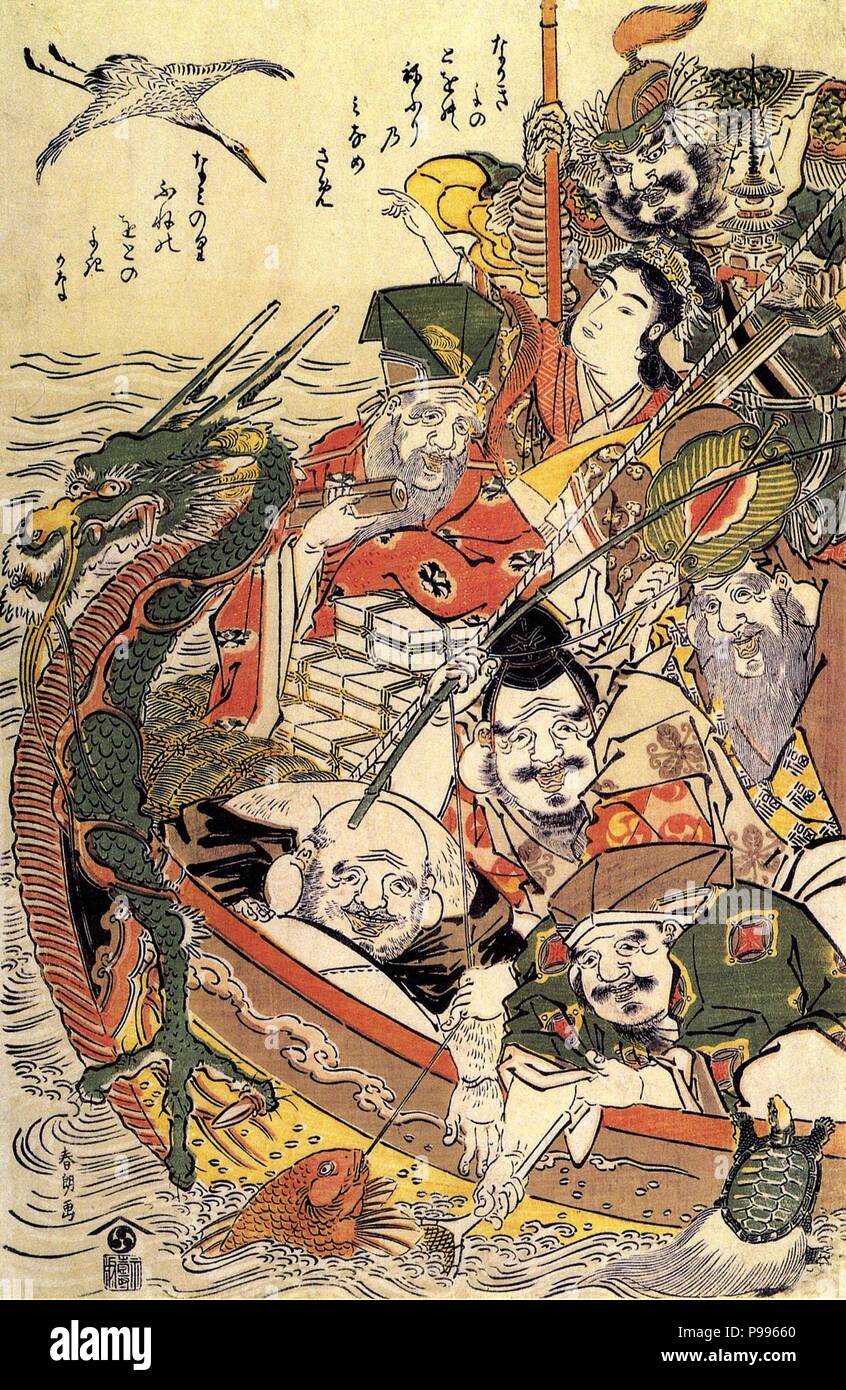 Seven Gods of Good Fortune. Museum: PRIVATE COLLECTION. Stock Photohttps://www.alamy.com/image-license-details/?v=1https://www.alamy.com/seven-gods-of-good-fortune-museum-private-collection-image212258760.html
Seven Gods of Good Fortune. Museum: PRIVATE COLLECTION. Stock Photohttps://www.alamy.com/image-license-details/?v=1https://www.alamy.com/seven-gods-of-good-fortune-museum-private-collection-image212258760.htmlRMP99660–Seven Gods of Good Fortune. Museum: PRIVATE COLLECTION.
 Ebisu, from the series "The Seven Gods of Good Luck in Modern Life (Tosei Shichi Fukujin)", c. 1769. Stock Photohttps://www.alamy.com/image-license-details/?v=1https://www.alamy.com/ebisu-from-the-series-quotthe-seven-gods-of-good-luck-in-modern-life-tosei-shichi-fukujinquot-c-1769-image457037233.html
Ebisu, from the series "The Seven Gods of Good Luck in Modern Life (Tosei Shichi Fukujin)", c. 1769. Stock Photohttps://www.alamy.com/image-license-details/?v=1https://www.alamy.com/ebisu-from-the-series-quotthe-seven-gods-of-good-luck-in-modern-life-tosei-shichi-fukujinquot-c-1769-image457037233.htmlRM2HFFRJ9–Ebisu, from the series "The Seven Gods of Good Luck in Modern Life (Tosei Shichi Fukujin)", c. 1769.
 Katsukawa Shuntei. A Woman as Ebisu, from the series Seven Women as the Gods of Good Fortune for the Hanagasa Poetry Club (Hanagasaren shichifukujin). 1815–1820. Japan. Color woodblock print; shikishiban, surimono Stock Photohttps://www.alamy.com/image-license-details/?v=1https://www.alamy.com/katsukawa-shuntei-a-woman-as-ebisu-from-the-series-seven-women-as-the-gods-of-good-fortune-for-the-hanagasa-poetry-club-hanagasaren-shichifukujin-18151820-japan-color-woodblock-print-shikishiban-surimono-image337995261.html
Katsukawa Shuntei. A Woman as Ebisu, from the series Seven Women as the Gods of Good Fortune for the Hanagasa Poetry Club (Hanagasaren shichifukujin). 1815–1820. Japan. Color woodblock print; shikishiban, surimono Stock Photohttps://www.alamy.com/image-license-details/?v=1https://www.alamy.com/katsukawa-shuntei-a-woman-as-ebisu-from-the-series-seven-women-as-the-gods-of-good-fortune-for-the-hanagasa-poetry-club-hanagasaren-shichifukujin-18151820-japan-color-woodblock-print-shikishiban-surimono-image337995261.htmlRM2AHW0B9–Katsukawa Shuntei. A Woman as Ebisu, from the series Seven Women as the Gods of Good Fortune for the Hanagasa Poetry Club (Hanagasaren shichifukujin). 1815–1820. Japan. Color woodblock print; shikishiban, surimono
 A collection of Ebisu statues at Nishinomiya Shrine in Nagano Stock Photohttps://www.alamy.com/image-license-details/?v=1https://www.alamy.com/a-collection-of-ebisu-statues-at-nishinomiya-shrine-in-nagano-image373809403.html
A collection of Ebisu statues at Nishinomiya Shrine in Nagano Stock Photohttps://www.alamy.com/image-license-details/?v=1https://www.alamy.com/a-collection-of-ebisu-statues-at-nishinomiya-shrine-in-nagano-image373809403.htmlRF2CM4DKR–A collection of Ebisu statues at Nishinomiya Shrine in Nagano
 tokyo, japan - march 18 2020: Abundance of decorations in the effigy of deities and lucky charms of Japanese folklore like Ebisu god of fishing, Daiko Stock Photohttps://www.alamy.com/image-license-details/?v=1https://www.alamy.com/tokyo-japan-march-18-2020-abundance-of-decorations-in-the-effigy-of-deities-and-lucky-charms-of-japanese-folklore-like-ebisu-god-of-fishing-daiko-image355759713.html
tokyo, japan - march 18 2020: Abundance of decorations in the effigy of deities and lucky charms of Japanese folklore like Ebisu god of fishing, Daiko Stock Photohttps://www.alamy.com/image-license-details/?v=1https://www.alamy.com/tokyo-japan-march-18-2020-abundance-of-decorations-in-the-effigy-of-deities-and-lucky-charms-of-japanese-folklore-like-ebisu-god-of-fishing-daiko-image355759713.htmlRF2BJP741–tokyo, japan - march 18 2020: Abundance of decorations in the effigy of deities and lucky charms of Japanese folklore like Ebisu god of fishing, Daiko
 Art inspired by Seven Gods of Good Luck, From the Series Hana Kurabe, Shibata Zeshin, Japanese, 1807-1891, Woodblock color print, Japan, ca. 1885, Meiji Period, 9 1/2 x 9 7/8 in., 24.1 x 25.1 cm, Benzaiten, Bishamonten, Daikokuten, Ebisu, Fukurokuju, Hotei, Japanese mythology, Jurōjin, Classic works modernized by Artotop with a splash of modernity. Shapes, color and value, eye-catching visual impact on art. Emotions through freedom of artworks in a contemporary way. A timeless message pursuing a wildly creative new direction. Artists turning to the digital medium and creating the Artotop NFT Stock Photohttps://www.alamy.com/image-license-details/?v=1https://www.alamy.com/art-inspired-by-seven-gods-of-good-luck-from-the-series-hana-kurabe-shibata-zeshin-japanese-1807-1891-woodblock-color-print-japan-ca-1885-meiji-period-9-12-x-9-78-in-241-x-251-cm-benzaiten-bishamonten-daikokuten-ebisu-fukurokuju-hotei-japanese-mythology-jurjin-classic-works-modernized-by-artotop-with-a-splash-of-modernity-shapes-color-and-value-eye-catching-visual-impact-on-art-emotions-through-freedom-of-artworks-in-a-contemporary-way-a-timeless-message-pursuing-a-wildly-creative-new-direction-artists-turning-to-the-digital-medium-and-creating-the-artotop-nft-image459566505.html
Art inspired by Seven Gods of Good Luck, From the Series Hana Kurabe, Shibata Zeshin, Japanese, 1807-1891, Woodblock color print, Japan, ca. 1885, Meiji Period, 9 1/2 x 9 7/8 in., 24.1 x 25.1 cm, Benzaiten, Bishamonten, Daikokuten, Ebisu, Fukurokuju, Hotei, Japanese mythology, Jurōjin, Classic works modernized by Artotop with a splash of modernity. Shapes, color and value, eye-catching visual impact on art. Emotions through freedom of artworks in a contemporary way. A timeless message pursuing a wildly creative new direction. Artists turning to the digital medium and creating the Artotop NFT Stock Photohttps://www.alamy.com/image-license-details/?v=1https://www.alamy.com/art-inspired-by-seven-gods-of-good-luck-from-the-series-hana-kurabe-shibata-zeshin-japanese-1807-1891-woodblock-color-print-japan-ca-1885-meiji-period-9-12-x-9-78-in-241-x-251-cm-benzaiten-bishamonten-daikokuten-ebisu-fukurokuju-hotei-japanese-mythology-jurjin-classic-works-modernized-by-artotop-with-a-splash-of-modernity-shapes-color-and-value-eye-catching-visual-impact-on-art-emotions-through-freedom-of-artworks-in-a-contemporary-way-a-timeless-message-pursuing-a-wildly-creative-new-direction-artists-turning-to-the-digital-medium-and-creating-the-artotop-nft-image459566505.htmlRF2HKK1ND–Art inspired by Seven Gods of Good Luck, From the Series Hana Kurabe, Shibata Zeshin, Japanese, 1807-1891, Woodblock color print, Japan, ca. 1885, Meiji Period, 9 1/2 x 9 7/8 in., 24.1 x 25.1 cm, Benzaiten, Bishamonten, Daikokuten, Ebisu, Fukurokuju, Hotei, Japanese mythology, Jurōjin, Classic works modernized by Artotop with a splash of modernity. Shapes, color and value, eye-catching visual impact on art. Emotions through freedom of artworks in a contemporary way. A timeless message pursuing a wildly creative new direction. Artists turning to the digital medium and creating the Artotop NFT
 tokyo, japan - march 30 2020: Japanese folklore deities Ebisu, Daikokuten, Otafuku on a giant Engi Kumade which means Auspicious Rake in the free muse Stock Photohttps://www.alamy.com/image-license-details/?v=1https://www.alamy.com/tokyo-japan-march-30-2020-japanese-folklore-deities-ebisu-daikokuten-otafuku-on-a-giant-engi-kumade-which-means-auspicious-rake-in-the-free-muse-image359109691.html
tokyo, japan - march 30 2020: Japanese folklore deities Ebisu, Daikokuten, Otafuku on a giant Engi Kumade which means Auspicious Rake in the free muse Stock Photohttps://www.alamy.com/image-license-details/?v=1https://www.alamy.com/tokyo-japan-march-30-2020-japanese-folklore-deities-ebisu-daikokuten-otafuku-on-a-giant-engi-kumade-which-means-auspicious-rake-in-the-free-muse-image359109691.htmlRF2BT6T23–tokyo, japan - march 30 2020: Japanese folklore deities Ebisu, Daikokuten, Otafuku on a giant Engi Kumade which means Auspicious Rake in the free muse
 Ebisu statue god of fishers or merchants is the Seven Gods of Fortune, commonly referred to in English as the Seven Lucky Gods, Stock Photohttps://www.alamy.com/image-license-details/?v=1https://www.alamy.com/stock-photo-ebisu-statue-god-of-fishers-or-merchants-is-the-seven-gods-of-fortune-86427147.html
Ebisu statue god of fishers or merchants is the Seven Gods of Fortune, commonly referred to in English as the Seven Lucky Gods, Stock Photohttps://www.alamy.com/image-license-details/?v=1https://www.alamy.com/stock-photo-ebisu-statue-god-of-fishers-or-merchants-is-the-seven-gods-of-fortune-86427147.htmlRFF0H2KR–Ebisu statue god of fishers or merchants is the Seven Gods of Fortune, commonly referred to in English as the Seven Lucky Gods,
 Illustration 3D Stock Photohttps://www.alamy.com/image-license-details/?v=1https://www.alamy.com/illustration-3d-image7137737.html
Illustration 3D Stock Photohttps://www.alamy.com/image-license-details/?v=1https://www.alamy.com/illustration-3d-image7137737.htmlRMAA2AMA–Illustration 3D
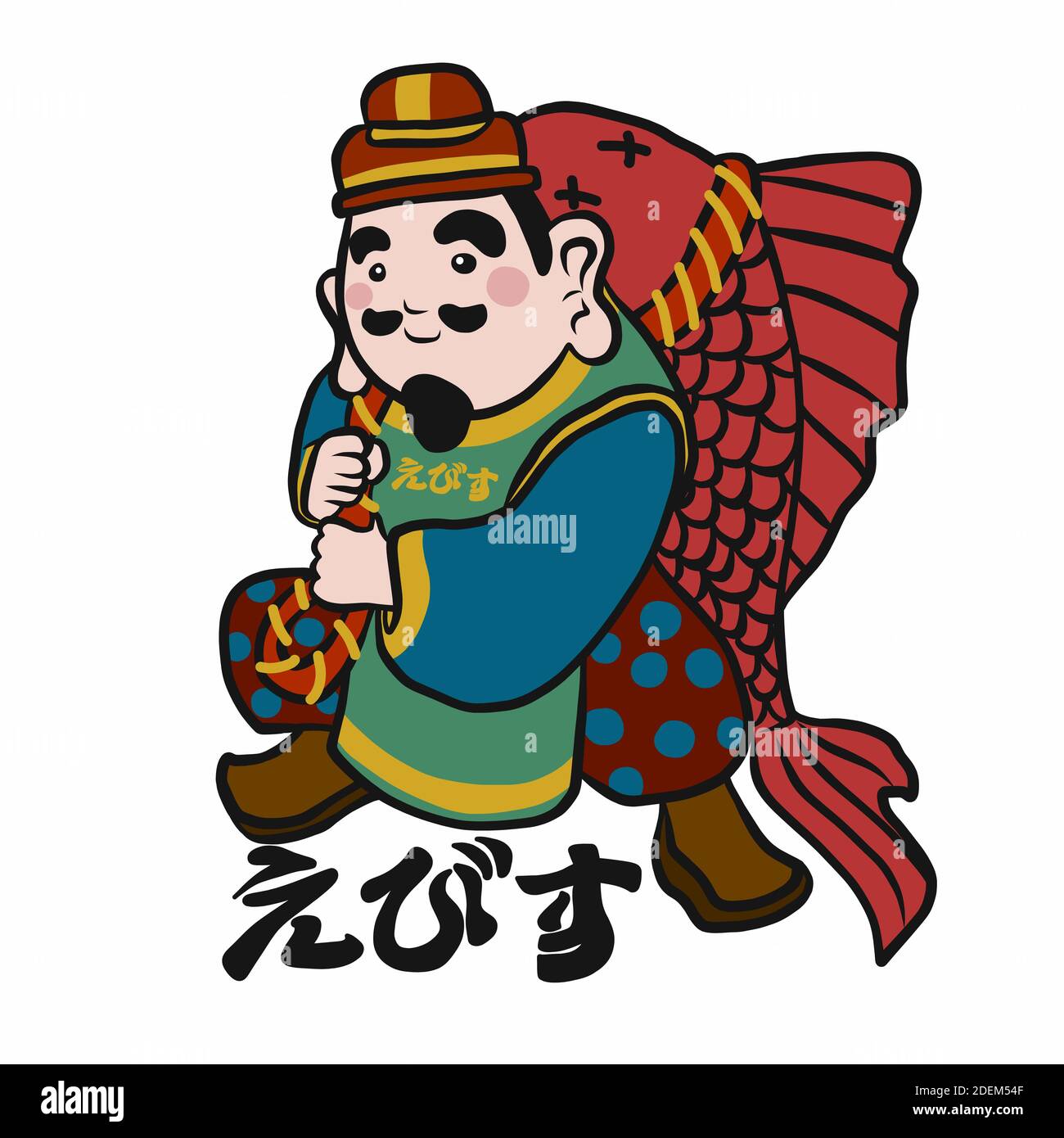 Japanese fisherman god with Japanese word mean Ebisu (God's name) cartoon vector illustration Stock Vectorhttps://www.alamy.com/image-license-details/?v=1https://www.alamy.com/japanese-fisherman-god-with-japanese-word-mean-ebisu-gods-name-cartoon-vector-illustration-image387676367.html
Japanese fisherman god with Japanese word mean Ebisu (God's name) cartoon vector illustration Stock Vectorhttps://www.alamy.com/image-license-details/?v=1https://www.alamy.com/japanese-fisherman-god-with-japanese-word-mean-ebisu-gods-name-cartoon-vector-illustration-image387676367.htmlRF2DEM54F–Japanese fisherman god with Japanese word mean Ebisu (God's name) cartoon vector illustration
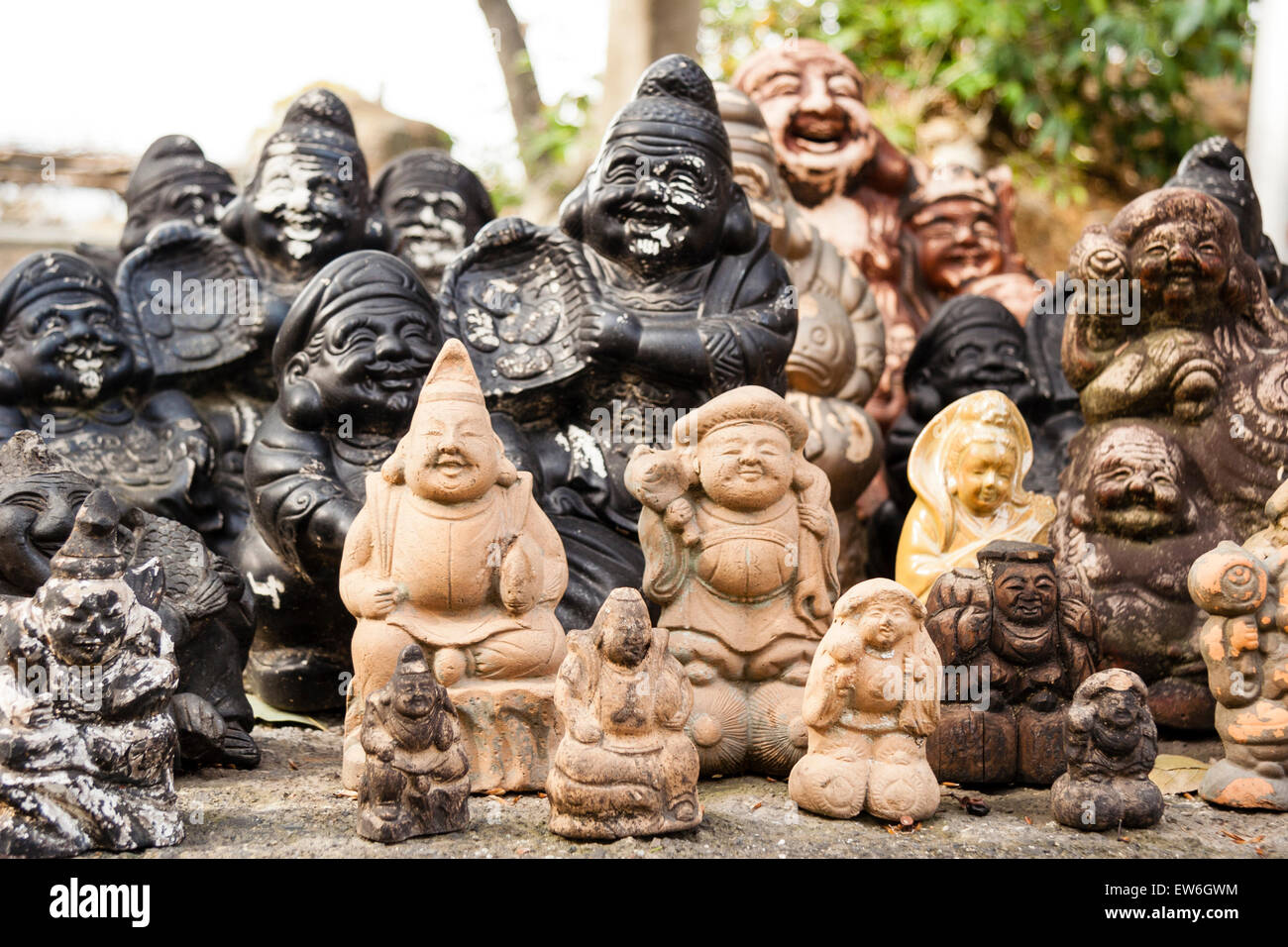 Japan, Kurashiki. Achi-jinja. Small statues of Shichifukujin, some of the the Japanese seven gods of happiness and good fortune arranged in group. Stock Photohttps://www.alamy.com/image-license-details/?v=1https://www.alamy.com/stock-photo-japan-kurashiki-achi-jinja-small-statues-of-shichifukujin-some-of-84352848.html
Japan, Kurashiki. Achi-jinja. Small statues of Shichifukujin, some of the the Japanese seven gods of happiness and good fortune arranged in group. Stock Photohttps://www.alamy.com/image-license-details/?v=1https://www.alamy.com/stock-photo-japan-kurashiki-achi-jinja-small-statues-of-shichifukujin-some-of-84352848.htmlRMEW6GWM–Japan, Kurashiki. Achi-jinja. Small statues of Shichifukujin, some of the the Japanese seven gods of happiness and good fortune arranged in group.
 nagasaki, kyushu - december 12 2022: Granite sculpture depicting the divinity Nanban Ebisu meaning the portuguese ebisu created by Masayuki Nagare in Stock Photohttps://www.alamy.com/image-license-details/?v=1https://www.alamy.com/nagasaki-kyushu-december-12-2022-granite-sculpture-depicting-the-divinity-nanban-ebisu-meaning-the-portuguese-ebisu-created-by-masayuki-nagare-in-image509671205.html
nagasaki, kyushu - december 12 2022: Granite sculpture depicting the divinity Nanban Ebisu meaning the portuguese ebisu created by Masayuki Nagare in Stock Photohttps://www.alamy.com/image-license-details/?v=1https://www.alamy.com/nagasaki-kyushu-december-12-2022-granite-sculpture-depicting-the-divinity-nanban-ebisu-meaning-the-portuguese-ebisu-created-by-masayuki-nagare-in-image509671205.htmlRF2MH5ER1–nagasaki, kyushu - december 12 2022: Granite sculpture depicting the divinity Nanban Ebisu meaning the portuguese ebisu created by Masayuki Nagare in
 Statue of Ebisu, JR Ebisu Station, Shibuya-Ku, Tokyo, Japan Stock Photohttps://www.alamy.com/image-license-details/?v=1https://www.alamy.com/statue-of-ebisu-jr-ebisu-station-shibuya-ku-tokyo-japan-image329721442.html
Statue of Ebisu, JR Ebisu Station, Shibuya-Ku, Tokyo, Japan Stock Photohttps://www.alamy.com/image-license-details/?v=1https://www.alamy.com/statue-of-ebisu-jr-ebisu-station-shibuya-ku-tokyo-japan-image329721442.htmlRM2A4C31P–Statue of Ebisu, JR Ebisu Station, Shibuya-Ku, Tokyo, Japan
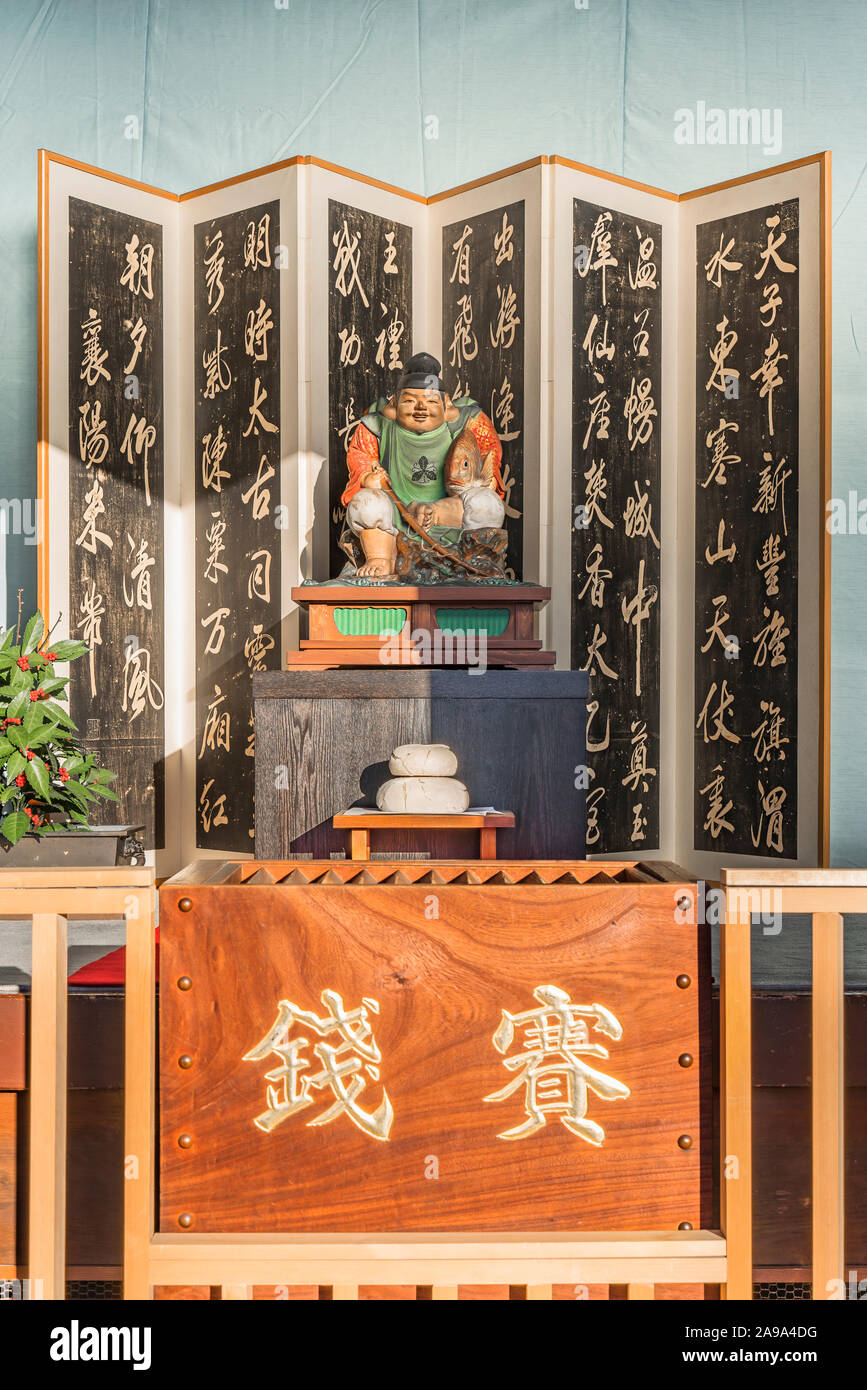 Wooden statue of the Shinto deity Ebisu with a screen, a kagami mochi rice cake and a donation box where is inscribed saisen which means money in the Stock Photohttps://www.alamy.com/image-license-details/?v=1https://www.alamy.com/wooden-statue-of-the-shinto-deity-ebisu-with-a-screen-a-kagami-mochi-rice-cake-and-a-donation-box-where-is-inscribed-saisen-which-means-money-in-the-image332751932.html
Wooden statue of the Shinto deity Ebisu with a screen, a kagami mochi rice cake and a donation box where is inscribed saisen which means money in the Stock Photohttps://www.alamy.com/image-license-details/?v=1https://www.alamy.com/wooden-statue-of-the-shinto-deity-ebisu-with-a-screen-a-kagami-mochi-rice-cake-and-a-donation-box-where-is-inscribed-saisen-which-means-money-in-the-image332751932.htmlRF2A9A4DG–Wooden statue of the Shinto deity Ebisu with a screen, a kagami mochi rice cake and a donation box where is inscribed saisen which means money in the
 The Namazu, also called the Onamazu, is a creature in Japanese mythology and folktales. The Namazu is a gigantic catfish said to cause earthquakes and tremors. Living in the mud under the Japanese isles, the Namazu is guarded by the protector god Kashima, who restrains the catfish using the kaname-ishi rock. Whenever Kashima lets his guard down, Namazu thrashes about and causes violent earthquakes. The Namazu rose to new fame and popularity after the Ansei great earthquakes that happened near Edo in 1855. This led to the Namazu being worshipped as a god of world rectification (yonaoshi daimyo Stock Photohttps://www.alamy.com/image-license-details/?v=1https://www.alamy.com/the-namazu-also-called-the-onamazu-is-a-creature-in-japanese-mythology-and-folktales-the-namazu-is-a-gigantic-catfish-said-to-cause-earthquakes-and-tremors-living-in-the-mud-under-the-japanese-isles-the-namazu-is-guarded-by-the-protector-god-kashima-who-restrains-the-catfish-using-the-kaname-ishi-rock-whenever-kashima-lets-his-guard-down-namazu-thrashes-about-and-causes-violent-earthquakes-the-namazu-rose-to-new-fame-and-popularity-after-the-ansei-great-earthquakes-that-happened-near-edo-in-1855-this-led-to-the-namazu-being-worshipped-as-a-god-of-world-rectification-yonaoshi-daimyo-image344279763.html
The Namazu, also called the Onamazu, is a creature in Japanese mythology and folktales. The Namazu is a gigantic catfish said to cause earthquakes and tremors. Living in the mud under the Japanese isles, the Namazu is guarded by the protector god Kashima, who restrains the catfish using the kaname-ishi rock. Whenever Kashima lets his guard down, Namazu thrashes about and causes violent earthquakes. The Namazu rose to new fame and popularity after the Ansei great earthquakes that happened near Edo in 1855. This led to the Namazu being worshipped as a god of world rectification (yonaoshi daimyo Stock Photohttps://www.alamy.com/image-license-details/?v=1https://www.alamy.com/the-namazu-also-called-the-onamazu-is-a-creature-in-japanese-mythology-and-folktales-the-namazu-is-a-gigantic-catfish-said-to-cause-earthquakes-and-tremors-living-in-the-mud-under-the-japanese-isles-the-namazu-is-guarded-by-the-protector-god-kashima-who-restrains-the-catfish-using-the-kaname-ishi-rock-whenever-kashima-lets-his-guard-down-namazu-thrashes-about-and-causes-violent-earthquakes-the-namazu-rose-to-new-fame-and-popularity-after-the-ansei-great-earthquakes-that-happened-near-edo-in-1855-this-led-to-the-namazu-being-worshipped-as-a-god-of-world-rectification-yonaoshi-daimyo-image344279763.htmlRM2B0389R–The Namazu, also called the Onamazu, is a creature in Japanese mythology and folktales. The Namazu is a gigantic catfish said to cause earthquakes and tremors. Living in the mud under the Japanese isles, the Namazu is guarded by the protector god Kashima, who restrains the catfish using the kaname-ishi rock. Whenever Kashima lets his guard down, Namazu thrashes about and causes violent earthquakes. The Namazu rose to new fame and popularity after the Ansei great earthquakes that happened near Edo in 1855. This led to the Namazu being worshipped as a god of world rectification (yonaoshi daimyo
 asakusa, japan - november 08 2019: Auspicious rakes or kisshō kumade decorated with Japanese deities like Ebisu and Daikokuten in masu cups or Otafuku Stock Photohttps://www.alamy.com/image-license-details/?v=1https://www.alamy.com/asakusa-japan-november-08-2019-auspicious-rakes-or-kissh-kumade-decorated-with-japanese-deities-like-ebisu-and-daikokuten-in-masu-cups-or-otafuku-image381526084.html
asakusa, japan - november 08 2019: Auspicious rakes or kisshō kumade decorated with Japanese deities like Ebisu and Daikokuten in masu cups or Otafuku Stock Photohttps://www.alamy.com/image-license-details/?v=1https://www.alamy.com/asakusa-japan-november-08-2019-auspicious-rakes-or-kissh-kumade-decorated-with-japanese-deities-like-ebisu-and-daikokuten-in-masu-cups-or-otafuku-image381526084.htmlRF2D4M0BG–asakusa, japan - november 08 2019: Auspicious rakes or kisshō kumade decorated with Japanese deities like Ebisu and Daikokuten in masu cups or Otafuku
